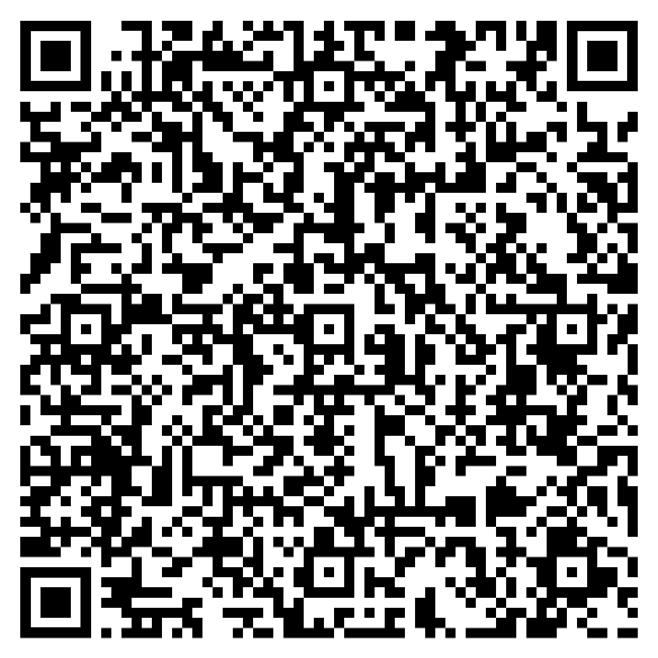THE HARVARD CRIMSON

PSC Adviser
SEE


Lacrosse Sees Strong Win in Season’s




SEE




Harvard Corporation Senior Fellow Penny S. Pritzker ’81 and the presidential search committee chose Claudine Gay as Harvard’s 30th president without conducting a scholarly review of her work, according to a person familiar with the process.
The committee favored Gay’s administrative expertise during the process, passing over two internal candidates who boasted both administrative experience and far more extensive scholarship credentials: Tomiko Brown-Nagin and John F. Manning ’82.
Brown-Nagin, dean of the Radcliffe Institute for Advanced Study, published
two books and won the highest award in American History writing, while Manning, dean of Harvard Law School, argued nine cases before the U.S. Supreme Court and wrote more than 40 legal articles.
Manning declined to comment on being a finalist in the last presidential search. Brown-Nagin did not respond to a request for comment.
Gay was heralded as a brilliant political scientist and successful university administrator upon her selection as Harvard’s president, but her scholarly record was comparatively thin.
The revelation about the search process gives insight on how the search committee managed to pick a president whose scholarship would later come under microscopic scrutiny for allegations of plagiarism in December, after she had already faced months of controversy over
the University’s response to Hamas’ Oct. 7 attack on Israel.
An investigation by the Corporation later found that her work contained multiple instances of “duplicative language,” leading Gay to make a total of seven corrections across two articles and her Ph.D. dissertation.
The plagiarism allegations, which were first reported by right-wing media outlets, raised questions about the extent to which the search committee vetted Gay and how the allegations were not discovered during the search process.
A person familiar with the process said Gay’s lengthy experience as a senior administrator led the Harvard Corporation — the University’s highest governing body — to not conduct a more comprehensive review of her scholarship. A Harvard spokesperson declined to
comment for this article.
The plagiarism allegations marked a major turning point in Gay’s brief tenure as president, weakening her support among Harvard faculty and students.
The unraveling of Gay’s presidency and the intense scrutiny on her scholarship record will likely prompt a look inward for the Corporation as its members try again to select someone to lead Harvard for the next decade.
The search for Harvard’s 30th president lasted just five months, making it the shortest Harvard presidential search in almost 70 years.
The 15-person presidential search committee narrowed a pool of 600 initial nominations down to just one person: Claudine Gay.
SEE PAGE 4
The University announced Monday evening that it is investigating social media posts that contained an antisemitic image from two pro-Palestine student groups and would refer the matter to the Harvard College Administrative Board.
“Such despicable messages have no place in the Harvard community,” the University wrote in a statement posted on Instagram. “We condemn these posts in the strongest possible terms.”
The Ad Board — an administrative body responsible for the application and enforcement of undergraduate policies — will review the posts, a sign that Harvard might look to take disciplinary action against the groups that published the antisemitic image.
While the post originated from two student organizations — Harvard Under-
graduate Palestine Solidarity Committee and the African and African American Resistance Organization, most of the initial criticism was directed at a Harvard faculty and staff pro-Palestine group that reposted the image in an Instagram story.
Shabbos “Alexander” Kestenbaum, a Harvard Divinity School student who sued the University last month alleging its failure to address antisemitism on campus, slammed Harvard faculty in a post on X for sharing “an explicitly antisemitic poster depicting a Jewish hand controlling the black mind.”
“With Professors like these, it’s easy to see why we Jewish students don’t feel safe in class,” Kestenbaum wrote. The image, which appeared to come from a June 1967 Student Nonviolent Coordinating Committee newsletter, depicted a hand branded with the Star of David with a dollar sign at the center of the star holding a noose that circles the necks of
Interim President Alan M. Garber ’76 fiercely condemned an antisemitic image posted by two pro-Palestine student groups in a Tuesday evening message to Harvard affiliates. “While the groups associated with the posting or sharing of the cartoon have since sought to distance themselves from it in various ways, the damage remains, and our condemnation stands,” Garber wrote. “The members of the Corporation join me in unequivocally condemning the posting and sharing of the cartoon in question.”
The antisemitic image was included in a Sunday Instagram post by the Harvard Undergraduate Palestine Solidarity Committee and the African and African American Resistance Organization. The image depicted a hand imprinted
with the Star of David and a dollar sign in the middle of it, holding a noose around the necks of two men who appear to be former Egyptian President Gamal Nasser and Muhammad Ali.
The image quickly drew outrage from Harvard affiliates online, with many directing their anger at Harvard Faculty and Staff for Justice in Palestine, a newly-formed group that reposted the image in an Instagram story.
The University announced on Monday that the antisemitic post would be reviewed by the Harvard College Administrative Board, which reviews disciplinary action regarding undergraduate students.
“The University will review the situation to better understand who was responsible for the posting and to determine what further steps are warranted,” Garber added.
A Harvard spokesperson declined to comment on how disciplinary procedures
SEE
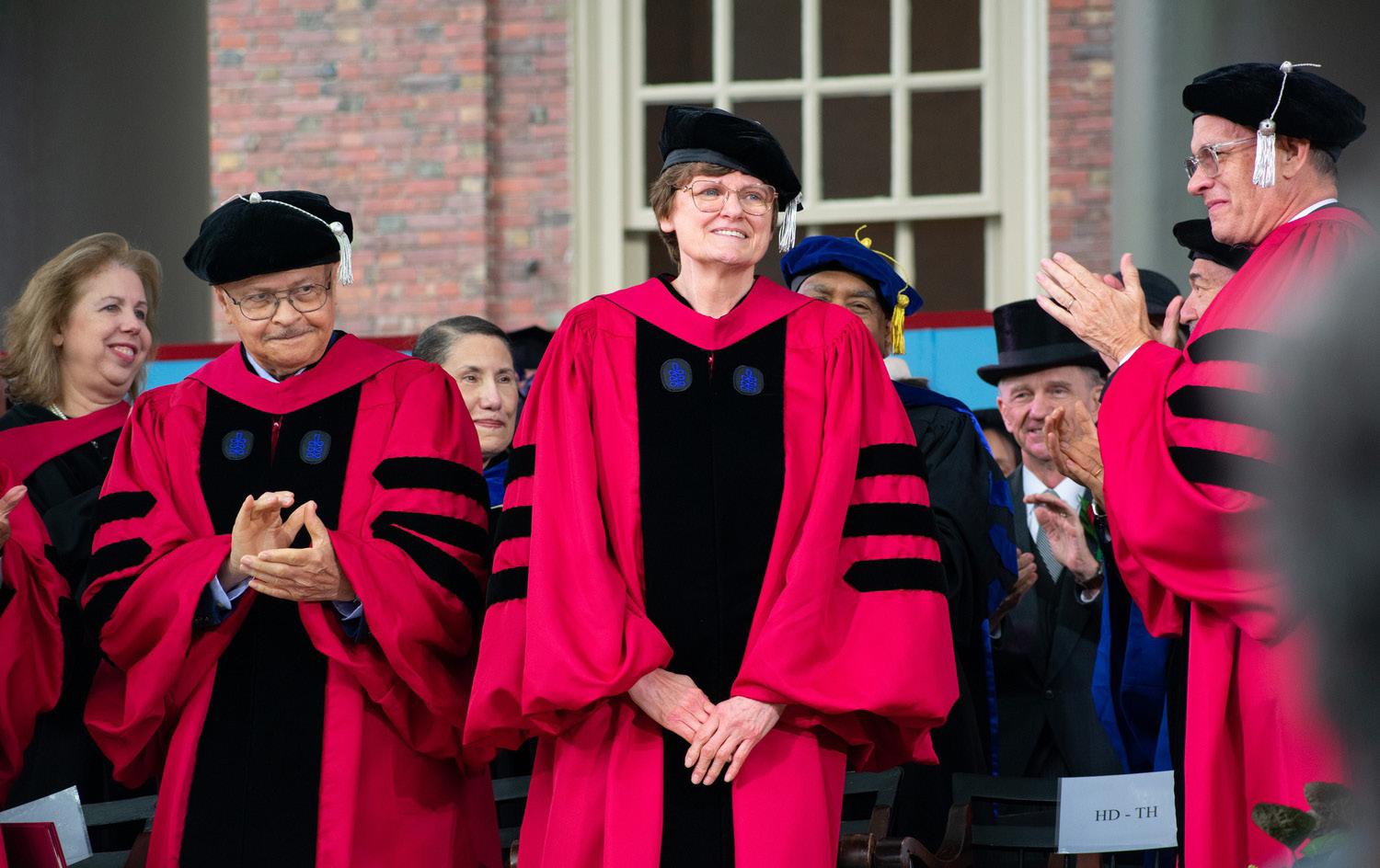
NOBEL PRIZE. Katalin Karikó and Drew Weissman spoke about their research and handling anti-vaccine sentiments Tuesday evening at a panel hosted by the IvyLeague+ and PreHealth Society. Karikó and Weissman received the 2023 Nobel Prize in Medicine for their discoveries which led to the creation of Pfizer and Moderna’s Covid-19 vaccines. The panel explored RNA-based gene therapy’s applications to the Covid-19 vaccine and beyond, including vaccines for autoimmune disease. BY ANGELINA J. PARKER AND SAMANTHA D. WU — CRIMSON STAFF WRITERS, PHOTO BY JULIAN J. GIORDANO — CRIMSON PHOTOGRAPHER
YALE
Following the release of “Yale and Slavery: A History,” Yale President Peter Salovey and Yale Corporation Senior Trustee Joshua Bekenstein formally apologized and outlined several tasks to address the university’s historical ties to slavery. In the apology, Salovey and Bekenstein recognized Yale’s leaders’ involvement with slavery and articulated a commitment to mitigate the continued impact of historical enslavement.
THE YALE DAILY NEWS
COLUMBIA
Five Jewish students and two organizations filed a lawsuit against Columbia and Barnard Wednesday, citing “particularly severe and pervasive” antisemitism on campus. The suit was filed under Title VI of the Civil Rights Act of 1946 and alleges the universities failed to ensure a safe environment for Jewish students, specifically their refusal to “stop and deter this outrageous antisemitic conduct and discipline the students and faculty who perpetrate it.”
THE COLUMBIA SPECTATOR
CORNELL
Following the enactment of the Interim Expressive Activity Policy, which requires registration of outdoor events for organizers of student demonstrations, members of Cornell’s Faculty Senate raised concerns at the first meeting of the semester. Under the policy, students may only use megaphones without prior approval between noon and 1 pm at two specific locations on campus. In a meeting last week, Cornell’s Student Assembly criticized the new policy, as well as the lack of transparency from administration.
THE CORNELL DAILY SUN

SCIENCE. Astronomers led by Harvard Ph.D. student Ralf Konietzka discovered that the Radcliffe Wave moves in an oscillating pattern in a paper published in Nature. The Wave — named in honor of the Harvard Radcliffe Institute — was initially discovered by a Radcliffe fellow in 2020. Konietzka’s team revealed that the Wave not only appears to be a wave but also moves like a wave. Using data from the Gaia spacecraft, the astronomers were able to observe the Wave’s oscillation for the first time ever. BY NICHOLAS J.
FRUMKIN AND ELIZABETH PENG — CRIMSON STAFF WRITERS, PHOTO BY SOFIA S. DE OLIVERIA
— CRIMSON PHOTOGRAPHER
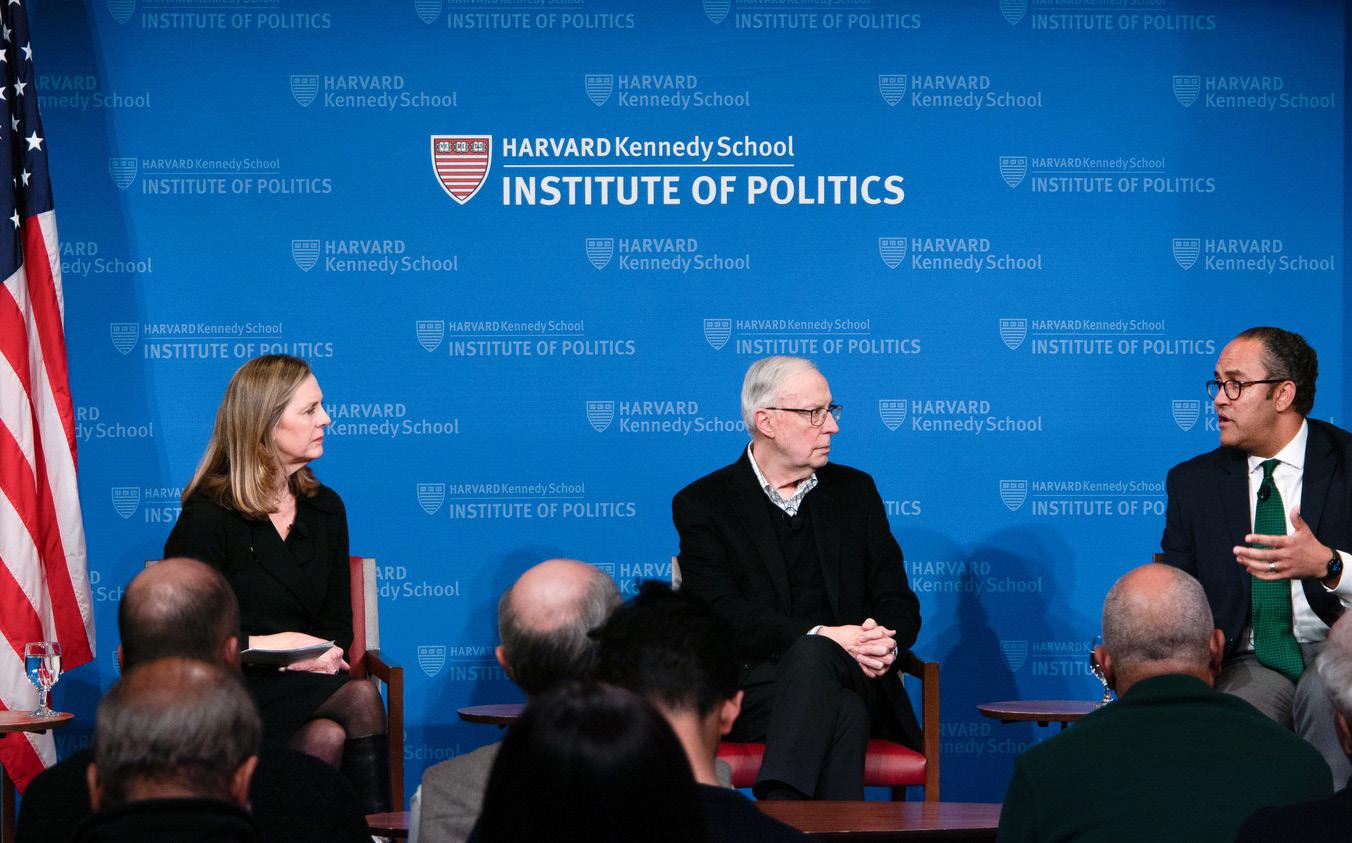
POLITICS. Former GOP hopeful and U.S. Representative William Hurd spoke about former President Donald Trump’s chances at reelection in the fall at an Institute of Politics forum Tuesday. Hurd briefly ran for the Republican presidential nomination before dropping out of the race in October. Hurd said that a victory over Trump would have to come in the primary elections and said he is doubtful of former U.N. Ambassador Nikki Haley’s chances. BY WILLIAM C. MAO AND DHRUV T. PATEL — CRIMSON STAFF WRITERS, PHOTO BY MATTEO CAGLIERO — CRIMSON PHOTOGRAPHER

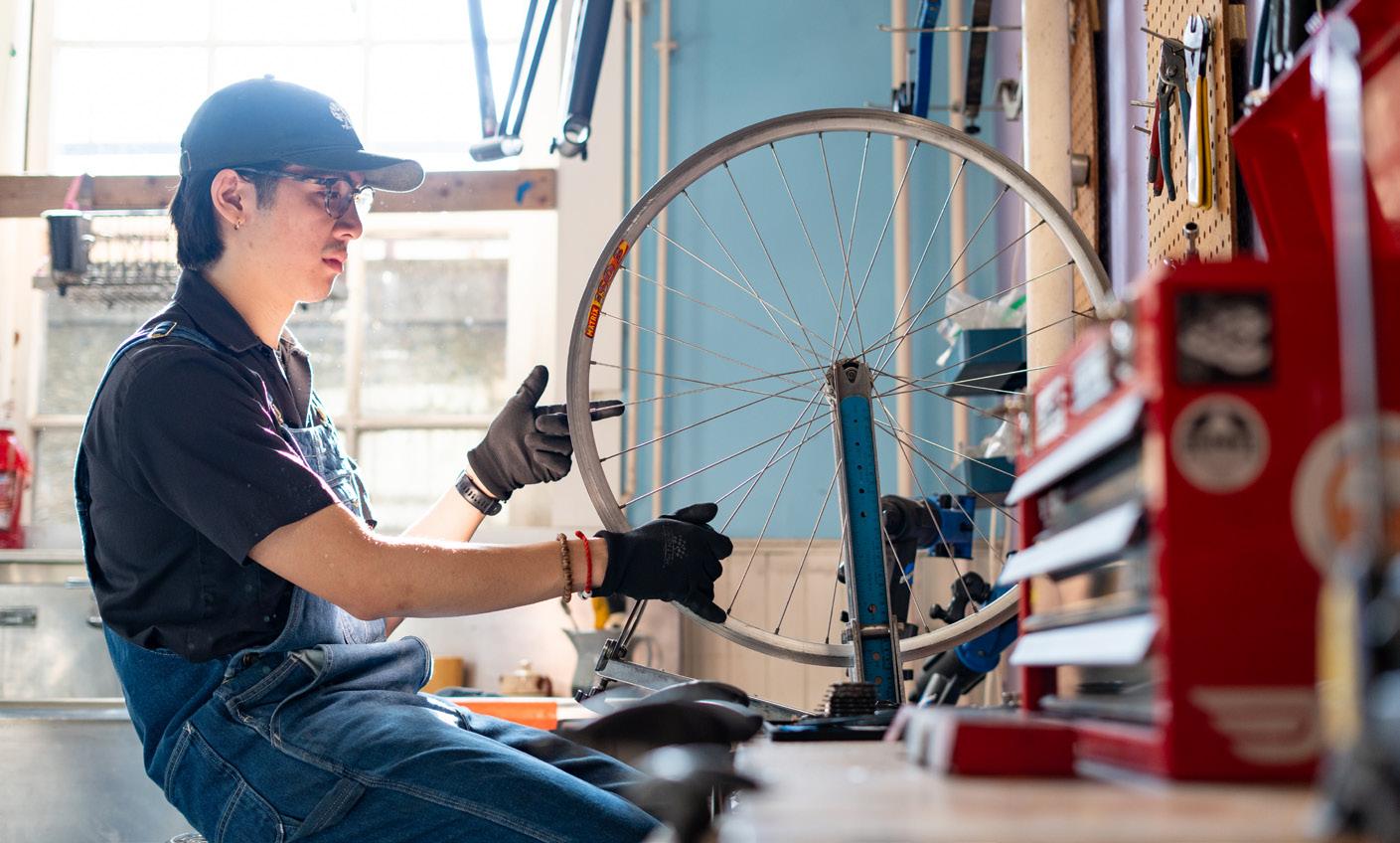
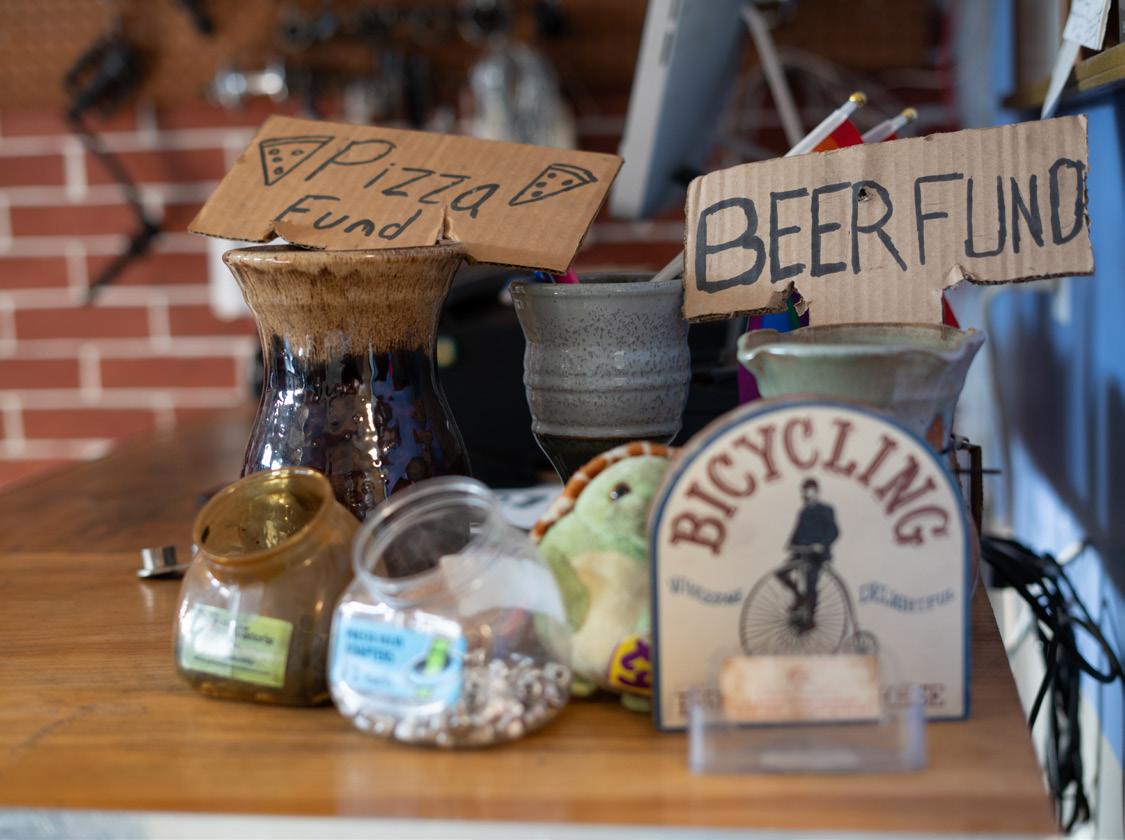
UPENN
In response to hearing frustrations from friends about using dating apps in the Philadelphia region, third-year MBA and MSW student Annie Xu created the matchmaking service Pairperfect, which provides users with potential love matches following completion of a questionnaire, profile, and video call with
THE
PRINCETON



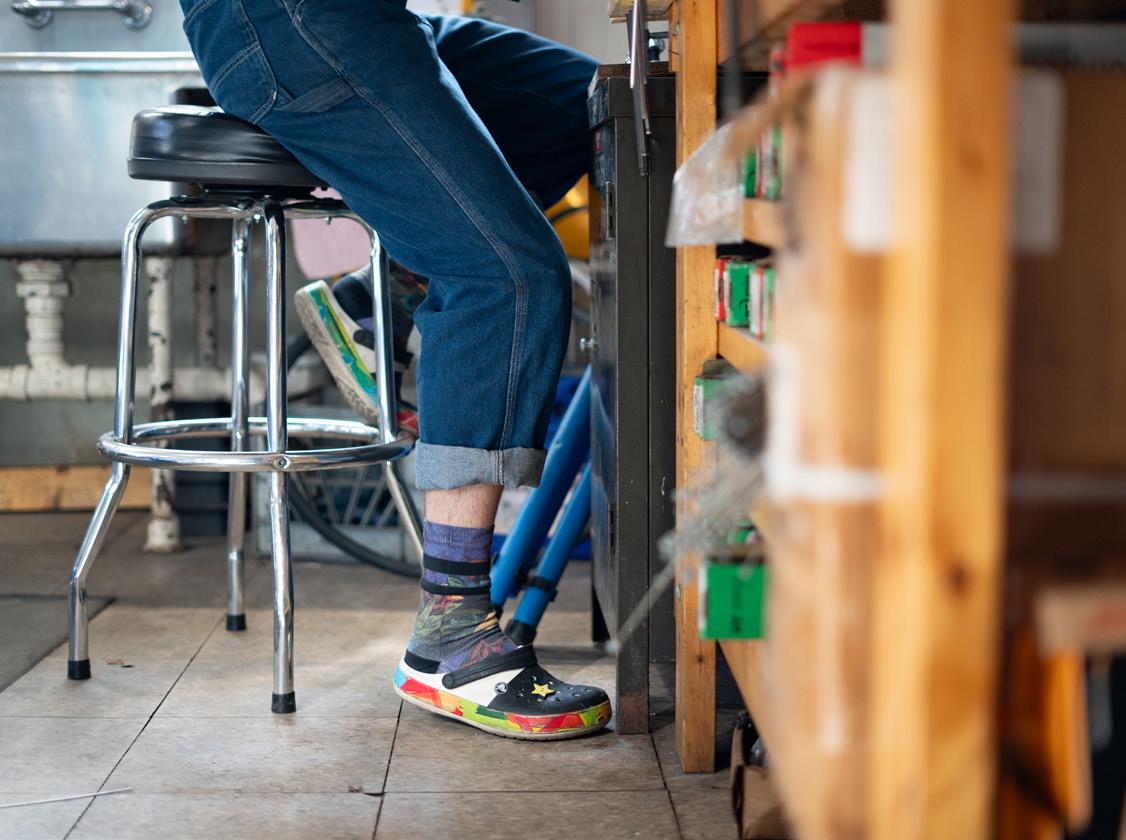
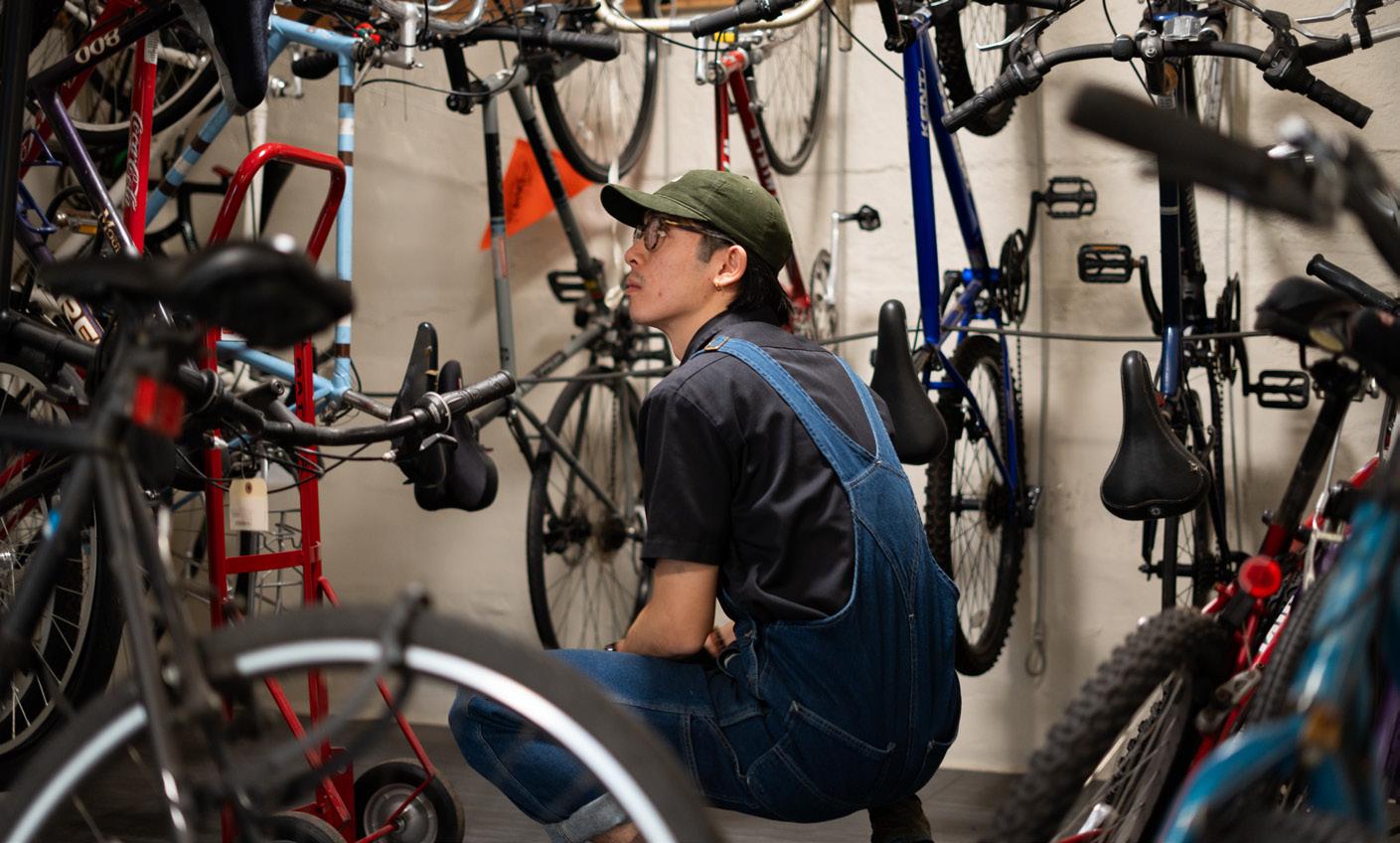
THE HARVARD CRIMSON
FEBRUARY 23, 2024
IN THE REAL WORLD
BIDEN TO SANCTION RUSSIA IN RESPONSE TO NAVALNY’S DEATH IN PRISON
The Biden administration is gearing up to impose significant sanctions on Moscow following the death of Russian opposition leader Aleksey Navalny, as confirmed by a White House official. National security officials have targeted various sectors of the Russian defense industry and economic revenue streams that fuel its military activities. The announcement comes in the wake of Navalny’s death in government custody at the age of 47, which President Biden accuses Putin of being responsible for.
DUTCH PRIME MINISTER RUTTE IN POSITION TO BECOME NATO SECRETARY GENERAL
Dutch Prime Minister Mark Rutte is on track to become the next leader of NATO, having garnered the backing of two-thirds of the alliance’s member countries, POLITICO reported. Rutte, who has actively pursued the position since November, is currently the sole candidate proposed by the member governments. However, per NATO’s consensus-based decision-making process, he must still secure unanimous support.
OPEN AI RELEASES SORA, AN AI TEXT-TO-VIDEO GENERATOR
OpenAI unveiled Sora, a groundbreaking AI model capable of crafting “realistic” and “imaginative” videos lasting up to 60 seconds from simple text prompts, the organization announced in a recent blog post. Sora distinguishes itself by its ability to generate complex scenes featuring multiple characters, diverse motions, and detailed backgrounds based on text instructions.
ALABAMA SUPREME COURT RULES FROZEN EMBRYOS ARE CHILDREN
In
Start every week with a preview of what’s on the agenda around Harvard University
Friday 2/23
2024 AFRICA HEALTH CONFERENCE
Harvard T.H. Chan School of Public Health
Attend the second annual Africa Health Conference at the Harvard T.H. Chan School of Public Health. This year’s theme is “Mapping Changemakers Transforming Health in Africa,” centering the leaders and organizations changing the healthcare field in Africa.
FAMILY DAY AT HARVARD ART MUSEUMS
Harvard Art Museums, 1-4 p.m.
Visit the Harvard Art Museums for family-friendly fun. There will be scavenger hunts, cardboard sculptures, and an art-making workshop. Admission is free on a first-come, first-served basis.
FILM SCREENING: “IN WATER”
Harvard Film Archive, 7-8 p.m.
Attend a screening of Hong Sangsoo’s “In Water” at the Harvard Film Archive. The South Korean production focuses on a small film crew led by a young director who has decided to give up acting and make a short film with two friends. Admission is free for Harvard students.
Monday 2/26
ETHICS MONDAY: HOW TO STEAL A PRESIDENTIAL ELECTION
Edmond & Lily Safra Center for Ethics, 12 p.m.
Join HLS professor Lawrence Lessig in discussion of his new book, written with Matt Seligman. The discussion will be focused on the peculiarities of the U.S. presidential election system, as well as proposed potential reforms.
RACE, POLICE, AND THE MEDIA IN AMERICA
JFK Jr. Forum, 5:30-6:30 p.m.
A discussion with Khalil Gibran Muhammad, associate editor of the Boston Globe Adrian Walker, and Boston Globe reporter Elizabeth Koh, moderated by IOP Director Setti Warren.
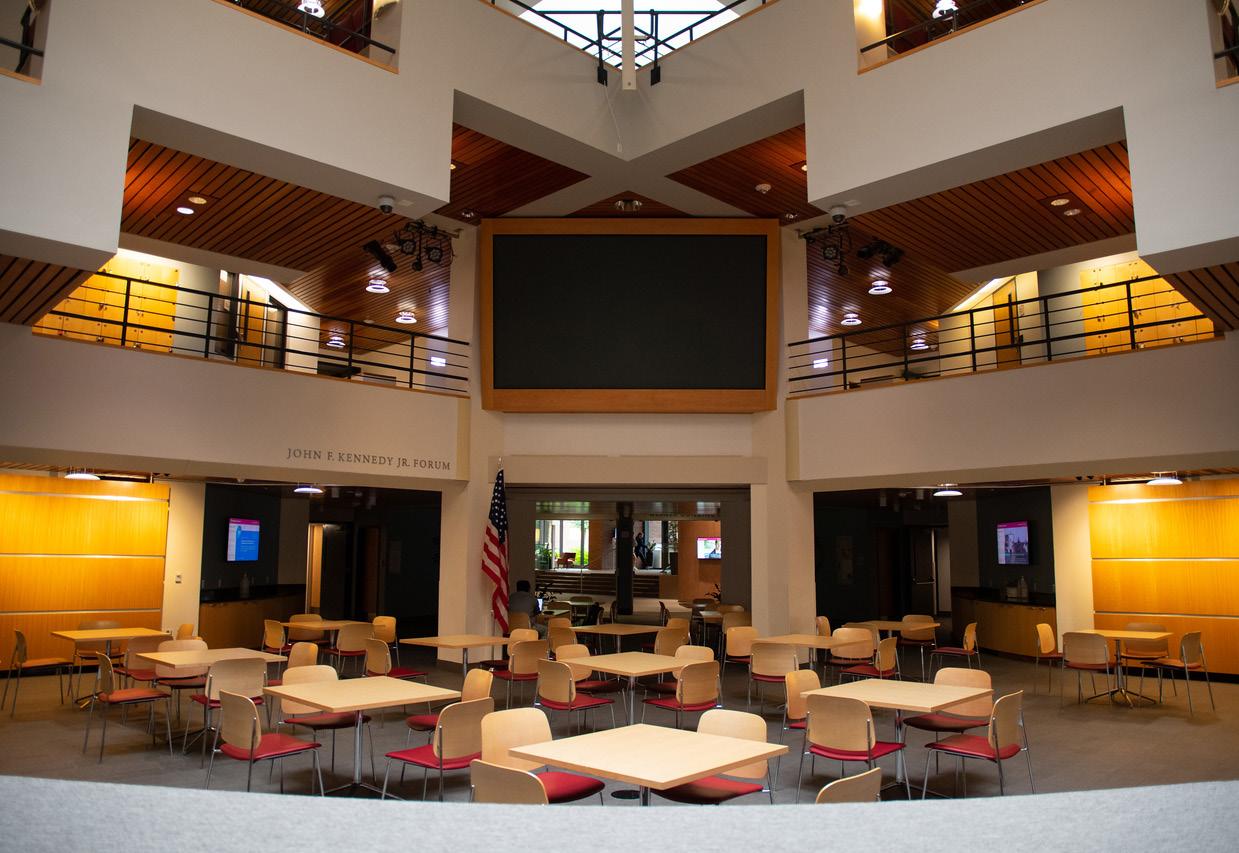
Wednesday 2/28
SPRING FIRST-YEAR FACULTY DINNER
Annenberg Hall, 4:30-7:30 p.m.
First-years, invite a professor, teaching fellow, preceptor, proctor, or other guest for a fancy dinner at Annenberg Hall. This event provides the opportunity to get to know faculty and discuss academic pursuits, research, career trajectories, or personal interests.
Thursday 2/29
CMSA FOURTH ANNUAL YIP LECTURE
Science Center Hall A, 4-5 p.m.
Joshua Tennebaum, an MIT Professor in the Department of Brain and Cognitive Sciences, will deliver the fourth annual Yip lecture, titled “How to grow a mind from a brain: From guessing and betting to thinking and talking.”
HGSE ALUMNI OF COLOR
CONFERENCE
13 Appian Way
The Alumni of Color Conference at the Harvard Graduate School of Education aims to improve diversity, equity, and inclusion practices in educational spaces. All members of the Harvard community are invited to attend and learn more about cutting edge research in education.
BIDEN ADMINISTRATION CONSIDERING PLAN TO RESTRICT ASYLUM CLAIMS AT US-MEXICO BORDER

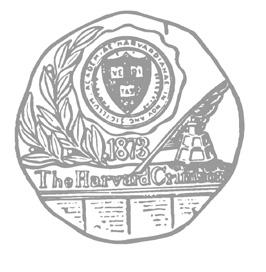
Agroup of Black Harvard alumni demanded that the University clarify and reaffirm its commitment to diversity, equity, and inclusion initiatives on campus in a letter to interim President Alan M. Garber ’76 and Harvard’s governing boards.
The Black Alumnae of Harvard Equity Initiative wrote in
SEARCH FROM PAGE 1
its letter that Claudine Gay’s election as Harvard’s 30th president signaled that the University “embraced the link between excellence and diversity,” but wrote that their “joy turned to dismay as we watched Dr. Gay endure vitriol with no well-coordinated defense to counter the well-coordinated attacks.” Gay resigned in January after a tumultuous six months in office. After Gay’s controversial congressional testimony in December, “cynical forces have manipulated the mounting number of antisemitic incidents around the country to attack the freedoms of speech and thought on America’s campuses, and to portray DEl as antisemitic and racist,” the letter stated.
A Harvard spokesperson did not comment for this article.
The group also requested more transparency from the governing boards as they launch a search for Gay’s permanent successor.
Harvard’s 31st president search process should treat “diversity, equity, and inclusion as essential values,” according to the letter.
The group’s concerns mirror those expressed by some students and faculty in the aftermath of Claudine Gay’s presidency, with some students stating that they believed Gay was held to a different standard as president because she is a Black woman.
The Black Harvard alumni group’s letter also took aim at
the plagiarism allegations that surfaced against Gay in the final month of her presidency. The allegations contributed to her decision to step down as president before the start of her second semester in the role.
“Attacks on Dr. Gay’s citation errors were tailored to undermine confidence in Dr. Gay’s academic qualifications, given she is a Black woman, and were the first salvo in what some anti-DEl activists have announced is an allout war against DEl,” the letter stated. The letter concluded with a request for an open dialogue with the University, and a list of five action items.
The action request included a demand to support and defend
Gay’s reputation, engagement in a “transparent selection process” for her successor, an affirmation of the importance of DEI on campus, an overhaul of DEI efforts to include recognized experts and a DEI task force, and additional transparency surrounding demographic data on University enrollment.
The letter requested a response from the University to its demands by March 15. “As a global academic leader, Harvard is in the unique position to lead and exemplify the urgent need to protect and rally for diversity, inclusion, and equity for all,” the group wrote.
A
In an interview with The Crimson after Gay’s selection in December 2022, Corporation member and former Princeton University president Shirley M. Tilghman said that administra-
experience was essential in addition to substantial scholarship when weighing candidates.
“It is just too complicated a job for someone who has never had to deal with something as complicated as the Faculty of Arts and Sciences, so that eliminated some of the candidates who may have been extraordinary scholars, but really did not have the kind of depth of experience,” Tilghman said at the time.
But in their focus on Gay’s administrative bona fides, the committee placed less weight on her academic track record.
Though Gay wrote multiple articles on race and politics that have been widely cited, her scholarship was decisively more limited compared to those of Manning and Brown-Nagin.
When the search process began, Manning had nine years of HLS administrative experience, first as deputy dean and then as dean of HLS since 2017. BrownNagin had four years of top administrative experience, having been promoted to her deanship around the same time as Gay in 2018.
Helming the FAS — the University’s largest school — seemed to serve as a litmus test for administrative skill, leading Pritz-

ker and the search committee to believe that Gay would make a relatively easy transition into the Harvard presidency. But Gay’s administrative roles at the University also led the search committee to make a disastrous decision to not review her scholarship more closely.
A person who has served on leadership search committees at various colleges and universities said that Harvard, like other universities, does not conduct extensive reviews and plagiarism checks on the scholarship of its serious contenders. Instead, the University relied on the conclusions of previous search committees and tenure reviews.
The Corporation seemingly believed a review would be unnecessary, even though university presidents — especially lead-
ers of prominent institutions like Harvard — are usually subject to a higher level of scrutiny.
But when the Corporation learned of the plagiarism allegations in October 2023, they then launched an independent review process that found several instances of “duplicative language” — where quotation marks were missing or attribution was omitted entirely.
While the Corporation initially stuck by Gay after the first allegations became public, persistent questions about Gay’s academic integrity eventually led Pritzker and the board to lose confidence in their own candidate.
Three members of the Board of Overseers — the University’s second-highest governing body — are expected to join members of the Corporation on the 31st
presidential search committee, which has not been formally announced. Barring any changes, at least eight of the new search committee’s 15 members will have also served on the group that selected Gay. Their job, in many ways, will be retracing their steps from a year ago in a radically altered higher education climate. In light of her tumultuous tenure, some criticized the rapidness of the selection process that promoted Gay. While Harvard has 11 other shortlist candidates from the last search that they already determined were good contenders, the events of the last several months may point to the need for the next search to include broader outreach before selecting the next president.
The Harvard Corporation faces some new challenges that it did not in the fall of 2022, even as Manning and Brown-Nagin could both be strong presidential contenders again.
The governing boards, in particular Pritzker and the Corporation, remain under serious scrutiny for their role in Harvard’s leadership crisis. Beyond Harvard, how universities address questions of free speech and hate on their campuses will remain salient, regardless who occupies the top job.
But this time around the Corporation must confront a situation in which its preferred candidates are asking an awkward question: Who wants to be president of Harvard?
emma.haidar@thecrimson.com cam.kettles@thecrimson.com
might apply to entire student groups. While the PSC is an organization that is officially recognized by the University, AFRO is not.
The PSC and AFRO removed the post before the University’s Monday statement, writing in an apology that they “regret inadvertently including an image that played upon antisemitic tropes.”
The post was met with widespread condemnation on social media.
Rabbi David Wolpe, who stepped down from former President Gay’s antisemitism advisory group following her congressional testimony, wrote on X that the image is “despicably, inarguably antisemitic.”
“Is there no limit?” he added.
The House Committee on Education and the Workforce, which is currently investigating Harvard over antisemitism on campus, also condemned Harvard faculty involvement in the original post on X.
“This repugnant antisemitism should have no place in our society, much less on Harvard’s faculty,” the Committee tweeted.
The Committee subpoenaed three top Harvard administrators on Feb. 16, after a weekslong back-and-forth over the committee’s request for internal communications from the University and the Harvard Corporation — the University’s highest governing body.
In the subpoena, the committee ordered Harvard to hand over all disciplinary records for Harvard affiliates and student organizations related to “conduct involving the targeting of Jews, Israelis, Israel, Zionists, or Zionism.”
The committee also demanded any communications relating to the University’s response to PSC’s controversial pro-Palestine letter published immediately after the Oct. 7 attack by Hamas on Israel, communications regarding PSC’s annual “Israeli Apartheid Week” and communications regarding pro-Palestine protests following Oct. 7.
Garber’s unequivocal condemnation of the antisemitic image comes as Jewish groups on campus have demanded the University fulfill its commitment to combating antisemitism with actions and not just words.
“Perpetuating vile and hateful antisemitic tropes, or otherwise engaging in inflammatory rhetoric or sharing images that demean people on the basis of their identity, is precisely the opposite of what this moment demands of us,” Garber wrote.
“Reckless provocation draws attention without advancing understanding,” he added.
two men who appear to be Muhammad Ali and former Egyptian President Gamal Nasser.
The phrase “third world” appears on the left side of the image and “liberation movement” is written on a machete in the background.
Sunday’s post, which explained the history of Black and Palestinian solidarity, was taken down and reposted Monday afternoon without the antisemitic image by both AFRO and the PSC. The groups wrote that the earlier version of the post “shared an image that was not reflective of our values as organizations.”
“Our mutual goals for liberation will always include the Jewish community - and we regret inadvertently including an image that played upon antisemitic tropes,” the caption stated. “Antisemitism has no place in the movement of Palestinian libera-
tion, and we wholeheartedly disavow it in all its forms.”
Harvard Faculty and Staff for Justice in Palestine, the newly formed group of pro-Palestinian faculty and staff, also apologized on Monday for resharing the original post.
“It has come to our attention that a post featuring antiquated cartoons which used offensive antisemitic tropes was linked to our account,” the group wrote in a Monday Instagram post. “We removed the content as soon as it came to our attention.”
“We apologize for the hurt that these images have caused and do not condone them in any way,” the group added.
The original post quickly drew widespread criticism for its display of antisemitic tropes from the House Committee on Education and the Workforce and Jewish Harvard affiliates.
“This repugnant antisemitism should have no place in our society, much less on Harvard’s faculty,” the committee’s official X account posted on Monday.
The committee — which is currently investigating Harvard over its handling of antisemitism on its campus — subpoenaed Harvard’s top leadership on Friday, the first time the committee has ever subpoenaed a university.
The University’s swift condemnation of the post and announcement that it would be reviewed by the Ad Board comes as Harvard is under increasing pressure to demonstrate that it is taking allegations of antisemitism seriously.
As part of its subpoena, the committee demanded Harvard produce disciplinary records related to “conduct involving the targeting of Jews, Israelis, Israel, Zionists, or Zionism.”
Harvard Chabad condemned
the image in a Monday post on X, calling it “reprehensible.”
“Members of Harvard *faculty* posting old-school classic antisemitic posters. Note the $ sign placed in the star of david depicted below,” the post stated. “This should be called what it is. Reprehensible. Bigoted. Hateful.” Harvard Hillel, the University’s Jewish center, wrote in a statement Monday night that it is “in contact with the administration” about the post containing an antisemitic image.
“This post follows an alarming increase in antisemitism on our campus in recent weeks,” Hillel wrote. “We will continue to call upon our administration to take action against virulent antisemitism at Harvard and strengthen our Jewish community.”
Harvard faculty and students also took to X to criticize the inclusion of the image on the origi-
nal post. Former Harvard Medical School Dean Jeffrey S. Flier also criticized Harvard FSJP for posting the image.
“Star of David on a hand choking the third world. Posted today by “Harvard faculty and staff for justice in Palestine,” Flier wrote. “No debate about this being anti-Semitic.”
After the original post was removed and updated Monday afternoon, Flier wrote on X that the update and apology was “better than leaving it up, but still very disturbing.”
In a Monday statement to The Crimson, Kestenbaum wrote that “the fact that this antisemitism was posted by Harvard faculty makes me question both the intelligence of said faculty, and what is it about Harvard’s hiring practices that allow such blatant antisemites to teach at this University.”
Former Harvard Hillel President Jacob M. Miller ’25, a Crimson Editorial chair, wrote that Harvard’s “antisemitism problem is so deep it even extends to the school’s faculty. Shameful.”
Harvard Jews for Palestine and HLS Tzedek — a Harvard Law School organization for Jewish students who “take a liberatory approach to Judaism” — praised AFRO and PSC for their “swift and clear response” to the criticism. “Jews for Palestine condemns antisemitism in all its forms, and stands in solidarity with PSC and AFRO, who have amended and apologized for inadvertently using an antisemitic image in a post,” the groups wrote. “As PSC and AFRO stated, antisemitism has no place in the movement for Palestinian liberation.”
BACKLASH. Harvard professor Walter Johnson resigned as a faculty adviser to the PSC as the group faced backlash over sharing an antisemitic social media post.
BY TILLY R. ROBINSON AND NEIL H. SHAH CRIMSON STAFF WRITERSWalter Johnson, a professor of History and of African and African American Studies, resigned as a faculty adviser to the Harvard Undergraduate Palestine Solidarity Committee and from Harvard Faculty and Staff for Justice in Palestine after the groups faced a wave of backlash for sharing a post containing an antisemitic image.
History professor Alison Frank Johnson, Johnson’s wife, confirmed his decision to resign from the two groups when reached by phone Tuesday evening.
“Conversations about Professor Johnson’s stepping down from the position were ongoing. His term was up in the spring and he had let us know he was not going to renew,” the PSC wrote in a statement. “This was a personal decision and he remains supportive of our goals as an organization. We are grateful for his time and support and wish him all the best.”
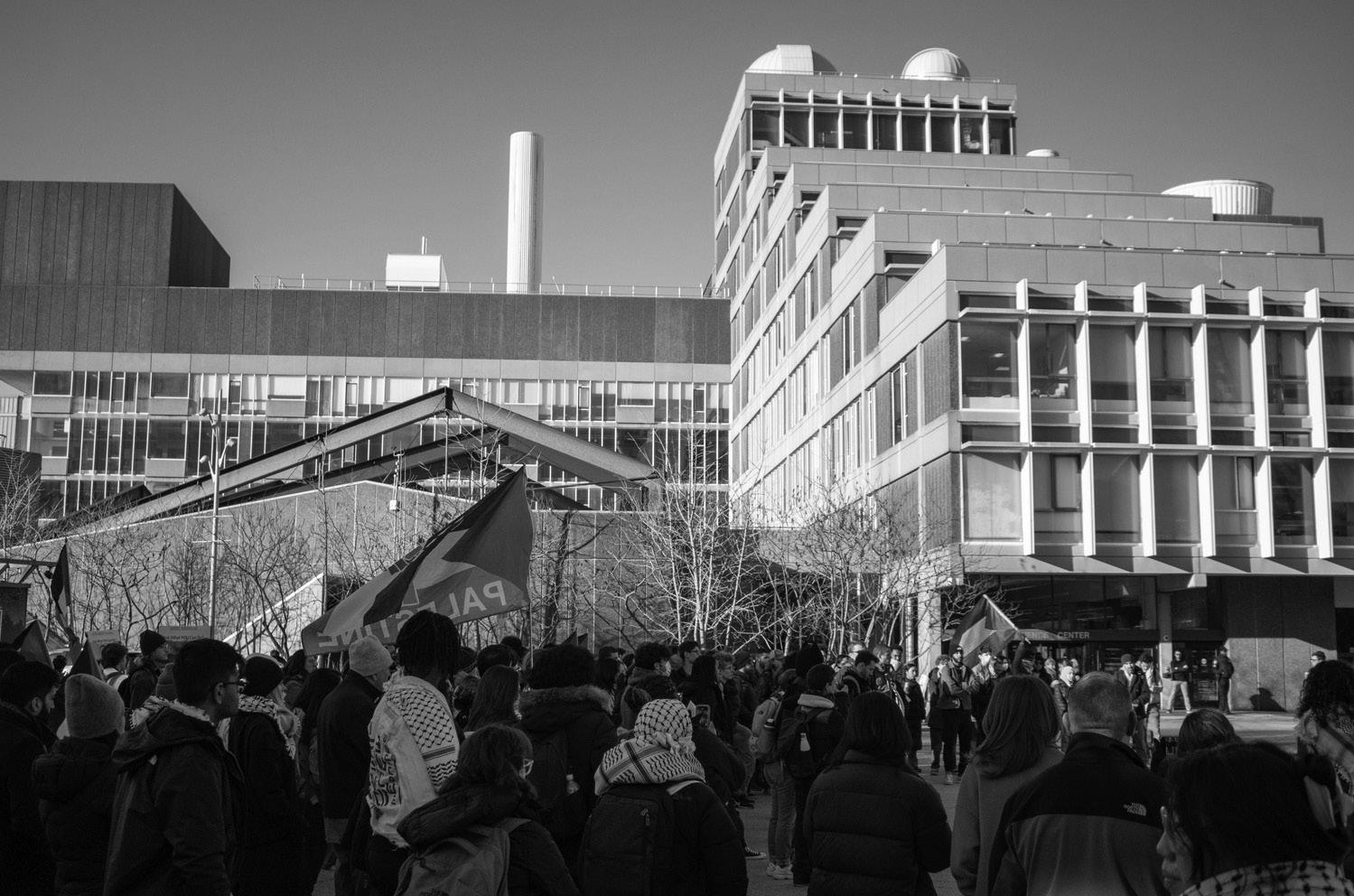
The FSJP did not immediately respond to requests for comment. Following the initial backlash, the PSC uploaded a new version of the post, writing in the caption that “an earlier version of this post” contained an image “not re -
flective” of their organizational values.
“Our mutual goals for liberation will always include the Jewish community- and we regret inadvertently including an image that played upon antisemitic
tropes,” they wrote. Interim Harvard President Alan M. Garber ’76 fiercely condemned the antisemitic image in a University-wide email on Tuesday, writing that “perpetuating vile and hateful antisemit-
ic tropes, or otherwise engaging in inflammatory rhetoric or sharing images that demean people on the basis of their identity, is precisely the opposite of what this moment demands of us.”
Johnson was initially listed as the first signatory in FSJP’s founding statement. The list of FSJP members was removed from the website at some point after controversy erupted over the antisemitic image.
FSJP issued an apology in an Instagram post on Monday for resharing the post containing the antisemitic image on their account.
“We apologize for the hurt that these images have caused and do not condone them in any way,” the organization wrote. “Harvard FSJP stands against all forms of hate and bigotry, including antisemitism.”
The PSC and the African and African American Resistance Organization — the two groups that initially posted the antisemitic image — apologized in a joint statement on Tuesday for the “immense harm” caused by the post.
“To be very clear: The original antisemitic image wholly violated our internal standards and betrayed our fundamental values of justice and liberation,” the groups wrote. “The inclusion of the offensive caricature was an unprompted, painful error — a combination of ignorance and inadequate oversight.”
“While the image in question was removed promptly, it should have never been published to begin with,” they added.
tilly.robinson@thecrimson.com neil.shah@thecrimson.com
Dean of Harvard College Rakesh Khurana condemned an antisemitic image posted by two pro-Palestine student groups during an interview on Tuesday, calling the post “unmistakably antisemitic and racist.”
“It’s become clear that some members of our community are intent on testing the limits of how low discourse can go — and it now appears that we are hitting rock bottom,” Khurana said.
The antisemitic image was jointly posted on Instagram Sunday by the Harvard Undergraduate Palestine Solidarity Committee and the African and African American Resistance Organization. The image depicted a hand, branded with the Star of David and a dollar sign in its center, holding a noose around the necks of who appear to be
Muhammad Ali and Gamal Abdel Nasser, a former president of Egypt.
“Finding words to express my disgust at what I saw is hard,” Khurana said. “I’m aware that after public condemnation, the offensive images have been taken down, but this bell cannot be unrung.”
The image — which was reposted by Harvard Faculty and Staff for Justice in Palestine, a newly-formed pro-Palestine group of faculty and staff — faced swift backlash on social media from Harvard affiliates who condemned the faculty members for amplifying antisemitic tropes. Walter Johnson, a professor of history and African and African American Studies, resigned from his position on FSJP and as the faculty adviser to the PSC on Wednesday.
Harvard has faced increasing scrutiny for its handling of antisemitism on its campus since the Oct. 7 attacks on Israel — including an ongoing con -
gressional investigation and a lawsuit brought by six Jewish students alleging the University’s failure to address antisemitism on campus.
The University strongly condemned the antisemitic image on Monday evening and announced it was investigating the post. Interim Harvard President Alan M. Garber ’76 personally denounced the image in a University-wide email Tuesday evening.
While the two groups that posted the original image deleted it and issued an apology, many affiliates, including Garber and Khurana, said it was too little, too late.
In Tuesday evening statements to The Crimson, members of the PSC and AFRO reiterated their regret for including the image on the original post.
Dean of Harvard College Rakesh Khurana condemned an antisemitic image posted by two pro-Palestine student groups during an interview on Tuesday,
calling the post “unmistakably antisemitic and racist.”
“It’s become clear that some members of our community are intent on testing the limits of how low discourse can go — and it now appears that we are hitting rock bottom,” Khurana said. The antisemitic image was jointly posted on Instagram Sunday by the Harvard Undergraduate Palestine Solidarity Committee and the African and African American Resistance Organization. The image depicted a hand, branded with the Star of David and a dollar sign in its center, holding a noose around the necks of who appear to be Muhammad Ali and Gamal Abdel Nasser, a former president of Egypt.
“Finding words to express my disgust at what I saw is hard,” Khurana said. “I’m aware that after public condemnation, the offensive images have been taken down, but this bell cannot be unrung.”
The image — which was reposted by Harvard Faculty and Staff for Justice in Palestine, a newly-formed pro-Palestine group of faculty and staff — faced swift backlash on social media from Harvard affiliates who condemned the faculty members for amplifying antisemitic tropes. Walter Johnson, a professor of history and African and African American Studies, resigned from his position on FSJP and as the faculty adviser to the PSC on Wednesday.
Harvard has faced increasing scrutiny for its handling of antisemitism on its campus since the Oct. 7 attacks on Israel — including an ongoing congressional investigation and a lawsuit brought by six Jewish students alleging the University’s failure to address antisemitism on campus. The University strongly condemned the antisemitic image on Monday evening and announced it was investigating the post. Interim Harvard President
Alan M. Garber ’76 personally denounced the image in a University-wide email Tuesday evening.
While the two groups that posted the original image deleted it and issued an apology, many affiliates, including Garber and Khurana, said it was too little, too late.
In Tuesday evening statements to The Crimson, members of the PSC and AFRO reiterated their regret for including the image on the original post.
When asked if the College is considering different approaches to disciplinary practices, Khurana said that the College will continue to rely on its processes and “apply them in a content-neutral and consistent way.”
“I also hope that people understand that rules are critical, but they’re not our aspiration,” he said.
michelle.amponsah@thecrimson.com joyce.kim@thecrimson.com
The decision to visit London, arguably the second-largest financial capital of the world, comes as the University is trying to contain a growing donor exodus and convince alumni that things are on the mend after a fall semester marked by almost nonstop controversy since Oct. 7. While most of the donor fall -
out occurred last fall, it did not end with Gay’s resignation. Billionaire hedge fund manager Kenneth C. Griffin ’89 — who donated $300 million to the Faculty of Arts and Sciences in April 2023 — pledged to pause donations late last month.
Victoria W. K. Leung ’91, president of the Harvard Club of the United Kingdom, said “the UK is a renewed priority for the University” and Garber’s trip is part of a larger “listening tour.”
“I think that it’s just a very very simple relationship building exercise, and I do understand that they are trying to salvage and regenerate goodwill because obviously there’s a lot of falling-out among donors and alums,” Leung said. “I think they are taking the right steps,” she added.
Leung said the trip was planned three weeks ago by the Harvard Alumni Association.
HAA Executive Director Sarah C. Karmon wrote in an emailed statement the HAA was “delighted” Garber would be heading to London to meet with alumni.
“I know he is looking forward to engaging with the club and with our numerous and active alumni throughout the United Kingdom,” she wrote.
Garber’s trip to the Harvard
Club of the UK follows other visits to London by senior University officials, including a recent event with Dean of Undergraduate Education Amanda J. Claybaugh, Dean of Students Thomas Dunne, and Harvard development officers.
Claybaugh and Dunne also met with alumni in early February in New York with Harvard College Dean Rakesh Khurana.
Leung said the UK was made a top priority after planned trips by former Harvard President Lawrence S. Bacow and Gay had been canceled.
Bacow visited Jordan, Israel, and Palestine in March 2023, his last international trip as president. He met with alumni and visited universities in all three countries, facing backlash from Harvard College Palestine Solidarity Committee for visiting Palestine “while denying the crime of apartheid on the ground.”
In a January interview with The Crimson, Garber expressed confidence in Harvard’s process for soliciting donations, saying that donors are “aligned” with the University’s goals.
“We listen to all kinds of voices that speak about Harvard University,” he said. “Our donors are among them, young alumni who are not donors,
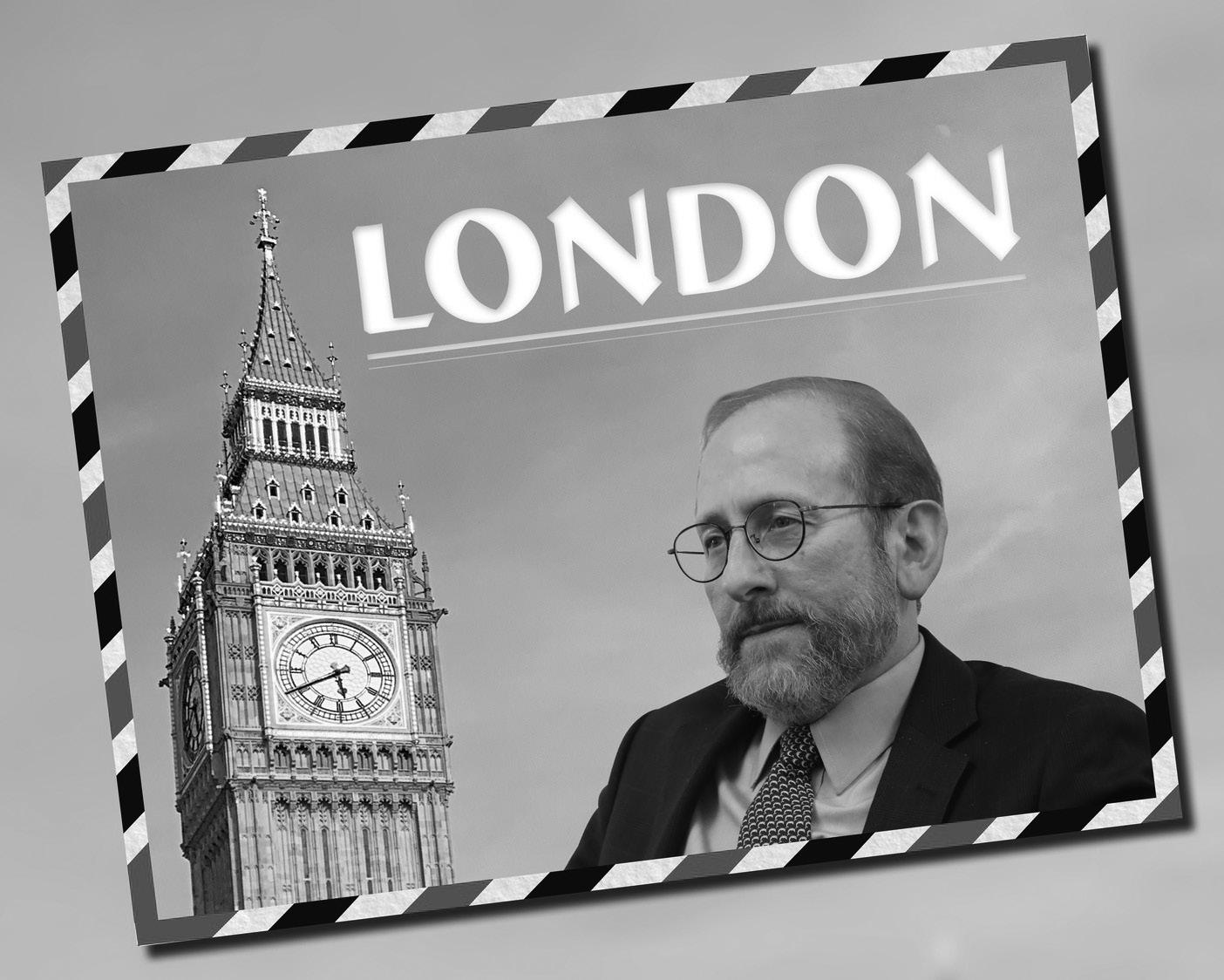
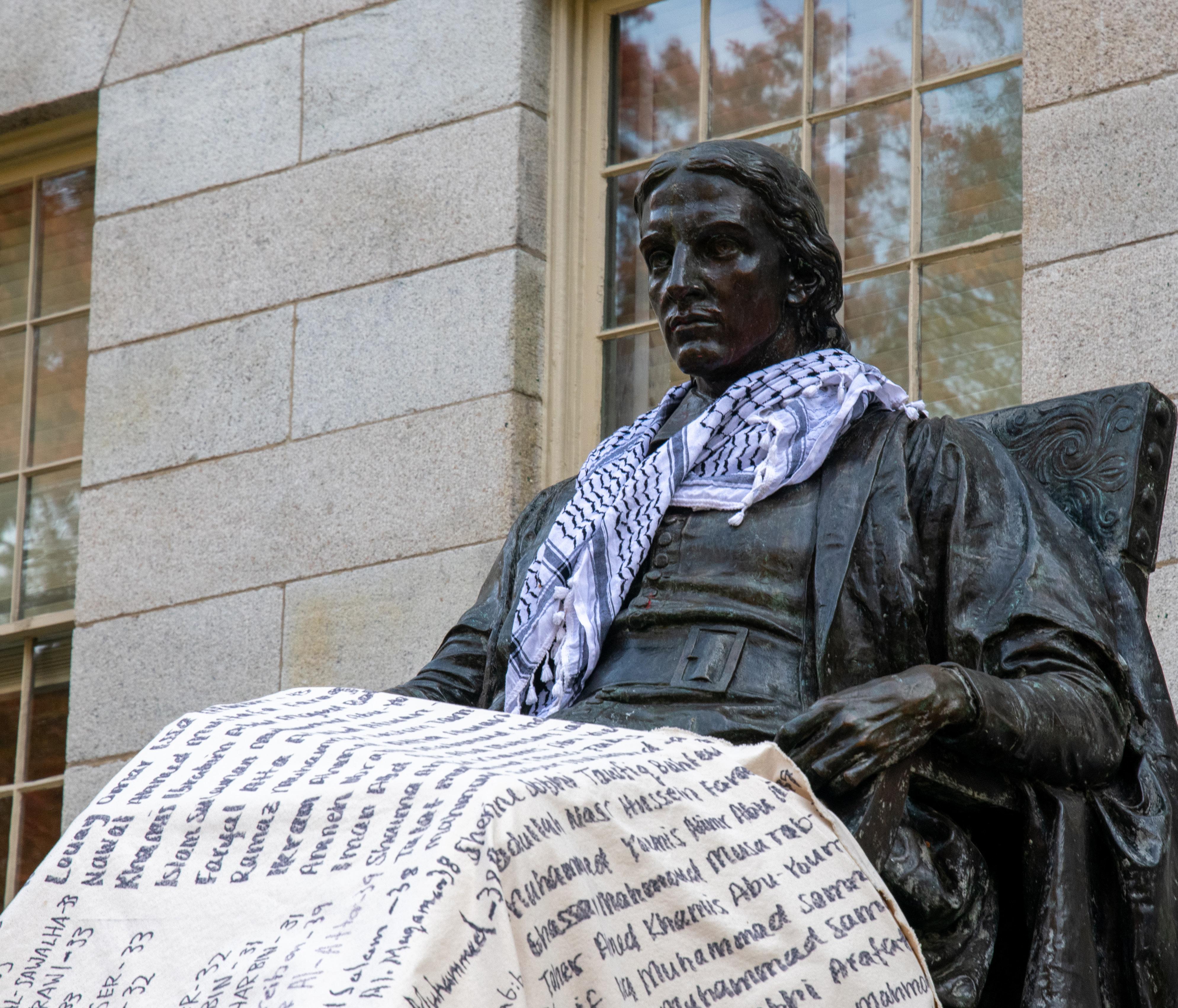
POLITICAL. Following months of controversy, Harvard is expected to consider a policy of institutional neutrality.
BY TILLY R. ROBINSON AND NEIL H. SHAH CRIMSON STAFF WRITERSIthe community, the University is planning a process to engage community members on their views and considerations related to institutional neutrality,” Swain wrote.
Though no formal announcement has been made yet, Flier suggested it had been in the works for some time.
But even the policy’s most ardent supporters acknowledge that its implementation would require a significant conceptual lift — one that Harvard’s upcoming working group will have to
consider. Institutional neutrality requires serious consideration of where Harvard should choose to set its own boundaries: When Harvard is itself implicated in politics, how should it weigh in? Where does it draw the line between condemning harmful and hateful speech — like an antisemitic image posted by two student groups — and taking a stance of its own? And yet, despite the complexities that would arise if Harvard adopts institutional neutrality, a growing number of faculty members — including some of the University’s most prominent scholars — say they believe it should.
‘All Of This Could Have Been Avoided’
On Dec. 5, in the midst of a tense Capitol Hill hearing, Rep. Elise M. Stefanik ’06 (R-N.Y.) laid a trap for then-Harvard President Claudine Gay. “Did anyone contact you about flying the Israeli flag over Harvard Yard?” Stefanik asked.
“Yes,” Gay answered. Stefanik followed up: “And the decision was made not to allow the flag to be flown over Harvard Yard?”
“It’s been standard protocol at
invasion. No senior Ukrainian officials were on campus at the time.
“So, the University made an exception for the Ukrainian flag, but not the Israeli flag,” Stefanik pressed.
“That was a choice made by my predecessor,” Gay said.
While the two decisions were made by two different leaders, Stefanik’s point landed: the University, as an institution, had strayed from precedent for Ukraine, but enforced it for Israel.
The exchange was overshadowed by other segments of the hearing, which would lead to Gay’s resignation less than a month later. But that allegation of hypocrisy illustrated what many faculty now see as a pernicious problem: relentless pressure on the University to publicly respond to political crises.
“Critics count the number of hours between a tragic event and a statement and use that as a metric to decide how much and whether the administration cares; they then police every word once a statement is issued,” History professor Alison Frank Johnson wrote in an email.
“This has to stop,” she added.
Gay’s initial message on Hamas’s Oct. 7 attack was
Critics count the number of hours between a tragic event and a statement and use that as a metric to decide how much and whether the administration cares.
the University for years to only fly the American flag unless we have a visiting dignitary,” Gay said. Stefanik confronted Gay with an accusation of hypocrisy, pointing to her predecessor’s decision — less than two years earlier — to raise the Ukrainian flag over Harvard Yard in a display of solidarity after Russia’s full-scale
slammed for being weak, slow, and equivocal, especially in comparison to Harvard’s responses to the invasion of Ukraine and the death of George Floyd. The message, which came on Oct. 9 and was signed by all of Harvard’s top deans, would become the first in a series of no fewer than seven public statements on campus
divisions over the war in Gaza by Gay’s administration. As the University failed to appease critics on either side of the Israel-Palestine conflict, the backlash escalated into a fullblown international scandal.
In the months since, Harvard has struggled to contain a growing donor exodus and become the subject of lawsuits and several federal investigations. The pressure contributed to Gay’s decision to step down, plunging the University into its worst leader-
continued, the faculty members concluded that the policy was the way to go. Their next objective — per Maskin and Flier, a CAFH co-president— was to draft a set of principles they all agreed a neutral institution should follow. A few short months after they started — and as the new administration settled into Massachusetts Hall — they sent their proposal to Garber’s office.
Though Garber has yet to publicly issue a statement on institutional neutrality, the forthcom-
At Harvard, all of this could have been avoided. I think if we were able to put a institutional neutrality policy in place at Harvard, that would make things better.
ship crisis in more than 50 years.
“At Harvard, all of this could have been avoided,” Maskin said.
“I think if we were able to put a institutional neutrality policy in place at Harvard, that would make things better,” he added. “Not just from the standpoint of academic freedom, but from not having these terrible distractions all the time.”
Shortly after Oct. 7, as criticism began to foment against the University, Maskin met with University Professor Gary King and the five co-presidents of the Council on Academic Freedom at Harvard. Together, they began researching what institutional neutrality would mean for Harvard, inspired by the University of Chicago’s long-standing policy of not commenting on current events.
Maskin and the study group broached the idea with then-University President Gay. She agreed, Maskin wrote in an email, that “institutional neutrality was worthy of serious consideration.”
As Harvard’s leadership woes
ing working group is the clearest indication yet that he is taking the idea seriously, and that a substantial reimagining of Harvard’s role in politics could be in the University’s future.
As Harvard’s leadership seems to be warming up to the idea, so are its professors. Across emails and interviews, more than 30 faculty members indicated they supported adopting institutional neutrality in some form — a vast majority of faculty members who responded to The Crimson.
“If the University just got out of the business of commenting on controversies and current events, they’d save themselves a whole lot of trouble,” said Psychology professor and CAFH co-president Steven A. Pinker, who proposed adopting institutional neutrality in a Boston Globe op-ed published four days after Gay’s congressional testimony.
“Taking an ideological stand should not be the decision of administrators who feel pressured to do so by a political and media complex that feeds on hot takes and partisanship,” Theater, Dance, and Media produc-
er James P. Stanley wrote in an email. While Maskin backs institutional neutrality, he acknowledges situations in which it’s “practically unavoidable” to make a statement, such as when Harvard itself is implicated.
Still, he reaffirmed his belief that institutional neutrality is the best path forward for a battered Harvard — pointing to UChicago’s policy as one to emulate.
“I don’t think that the exceptions have caused Chicago great difficulty, and I wouldn’t expect that they would cause great difficulty at Harvard either,” Maskin said. “But any institutional neutrality policy is going to require a lot of hard thinking about the details.”
Drawing the Line
If Harvard were to adopt a statement of neutrality, it would be far from a panacea for the school’s current problems. The University would almost certainly continue to face calls to censure controversial speech from pro-Palestine organizers, whose activism has not let up in the spring semester.
So far, Garber’s administration has indicated a renewed willingness to enforce regulations on the time, place, and manner of student protest. And some situations make for simpler calls — such as Garber’s condemnation Tuesday of an antisemitic image shared online by two pro-Palestine student groups. But there are tougher situations, such as how an ostensibly neutral Harvard would respond to language some consider political rhetoric but others see as hate speech.
“There are always going to be cases somewhere in the boundary,” Maskin said. “Part of a thoroughgoing institutional neutrality policy — which I think Harvard would have to develop if it wanted to go down that route — would be to try to spell out what is bullying and harassment, and what is permissible speech.”
Maskin is a member of CAFH, whose co-presidents — Flier, Pinker, former Dean of the College Harry R. Lewis ’68, Harvard Law School professor Jeannie Suk Gersen, and Philosophy
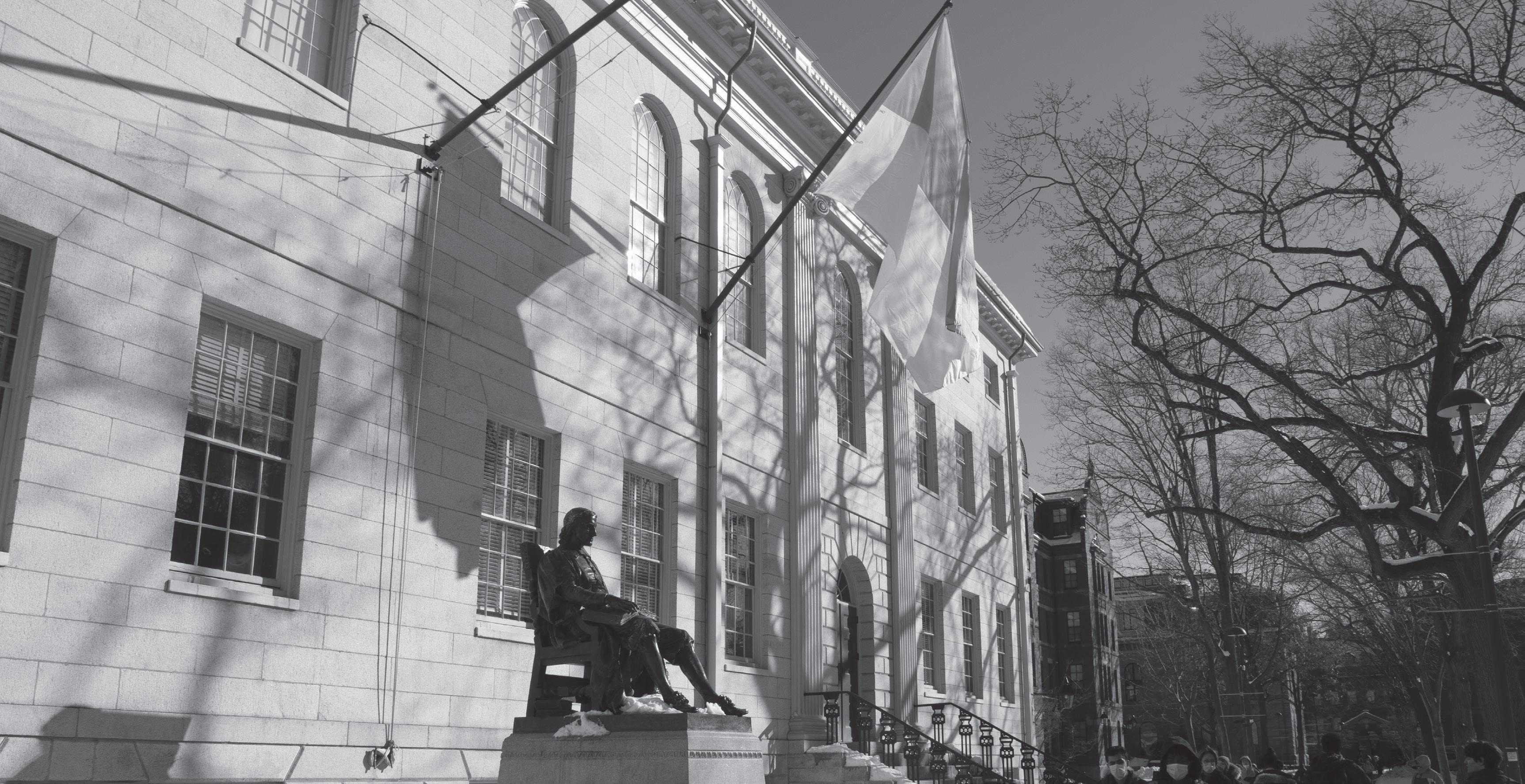
professor Edward J. “Ned” Hall — have emerged at the forefront of the push for institutional neutrality.
To proponents, institutional neutrality not only protects the University from outside forces, but also protects scholars from the speech of administrators stifling campus debate.
The University “should not prejudice any of its students or any of its faculty,” Pinker said. “It should not set them in opposition to their own employer, their own grader, their own judge.”
Publicly, CAFH has not endorsed institutional neutrality, although the group circulated a January donor prospectus highlighting it as an active area of member interest.
But many of its members — as well as, notably, Flier, Lewis, and Pinker — have rebuked Harvard as too weak on language from pro-Palestine activists they see as antisemitic.
On Oct. 8, Flier and Pinker helped draft a faculty letter criticizing Gay’s initial statement on the conflict for failing to distance the University from a controversial Oct. 7 student group statement holding Israel “entirely responsible” for the violence, accusing the student groups of “approving” Hamas’ attack.
The perceived political bent has alienated some professors. At least two former CAFH members — Classics professor Richard F. Thomas and Government professor Ryan D. Enos — left the organization due to concerns that CAFH was unwilling to fully defend free speech.
Thomas pointed to CAFH executive director Flynn J. Cratty’s use of the CAFH email list to circulate the letter condemning the student groups’ Oct. 7 statement.
Enos said he was disappointed in “members and some leadership” of CAFH who “chose not only to not protect unpopular speech among students” — particularly pro-Palestine organizers — but also “in many ways actually led the charge to try to condemn those students.”
Flynn J. Cratty, CAFH’s executive director, did not respond to multiple requests for comment.
Flier emphasized that his statements — and Pinker’s — were made in the context of Harvard as it stands now, with its practice of taking stances on geopolitical issues, and, in recent months, student speech.
“Presidents and deans were making statements on many different issues. Then, October 7th happened,” Flier said. “Headlines around the world were saying Harvard student groups say ‘X, Y, and Z.’ And, I think everybody was waiting to see what the University leadership would or would not say.”
When Harvard’s leaders speak out, it’s not always obvious whether their words convey personal beliefs or represent the University’s official position. Institutional neutrality, if adopted, might oblige them to stay silent, even if that silence is at odds with their own deeply held beliefs.
In an interview, Lewis, the former Harvard College dean, said
institutional neutrality would require University leaders to be “personally restrained” — a phi losophy Lewis said he has re tained for years.
“Your primary obligation now is not your own personal academ ic freedom — your professional academic freedom — it’s the welfare of the University,” Lewis said.
On the lapel of his tweed jacket, Lewis had clipped a pin bear ing the American and Ukrainian flags joined to gether. Asked whether he would wear the pin today if he were still dean of the College, Lewis hesi tated. “Perhaps not,” he said.
‘Harvard is Not Neutral’
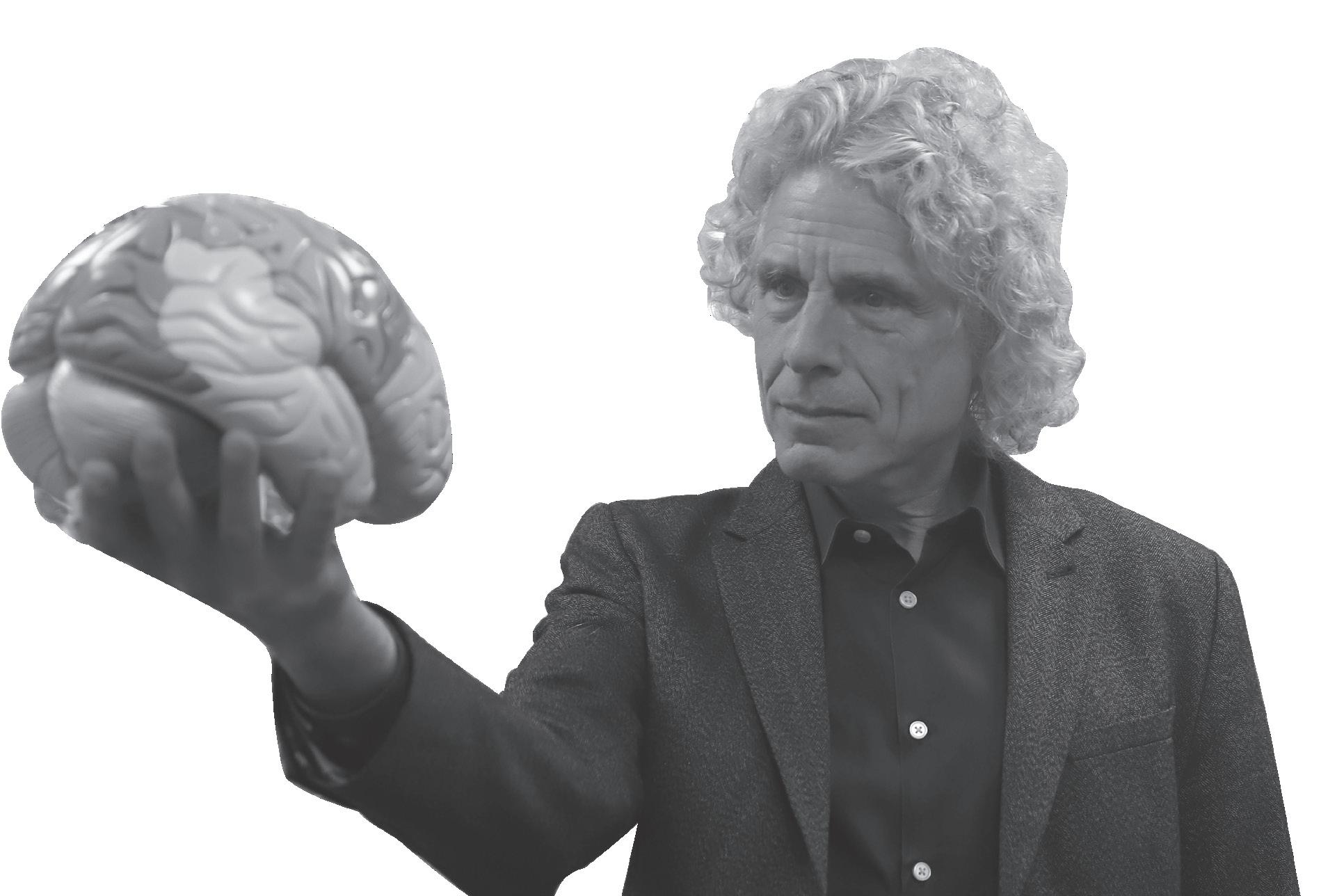
Though support for institutional neutrality has picked up among faculty, some say that in a tense,
more recently — billionaires that can put their thumb on the economic and social scales at a Enos specifically took aim at the House Committee on Education and the Workforce’s investigation into Harvard, which he called “a sign of rising authoritarianism in the
“If you believe in free inquiry and academic freedom, what you see coming from Congress right now should be a five-alarm fire,” Enos
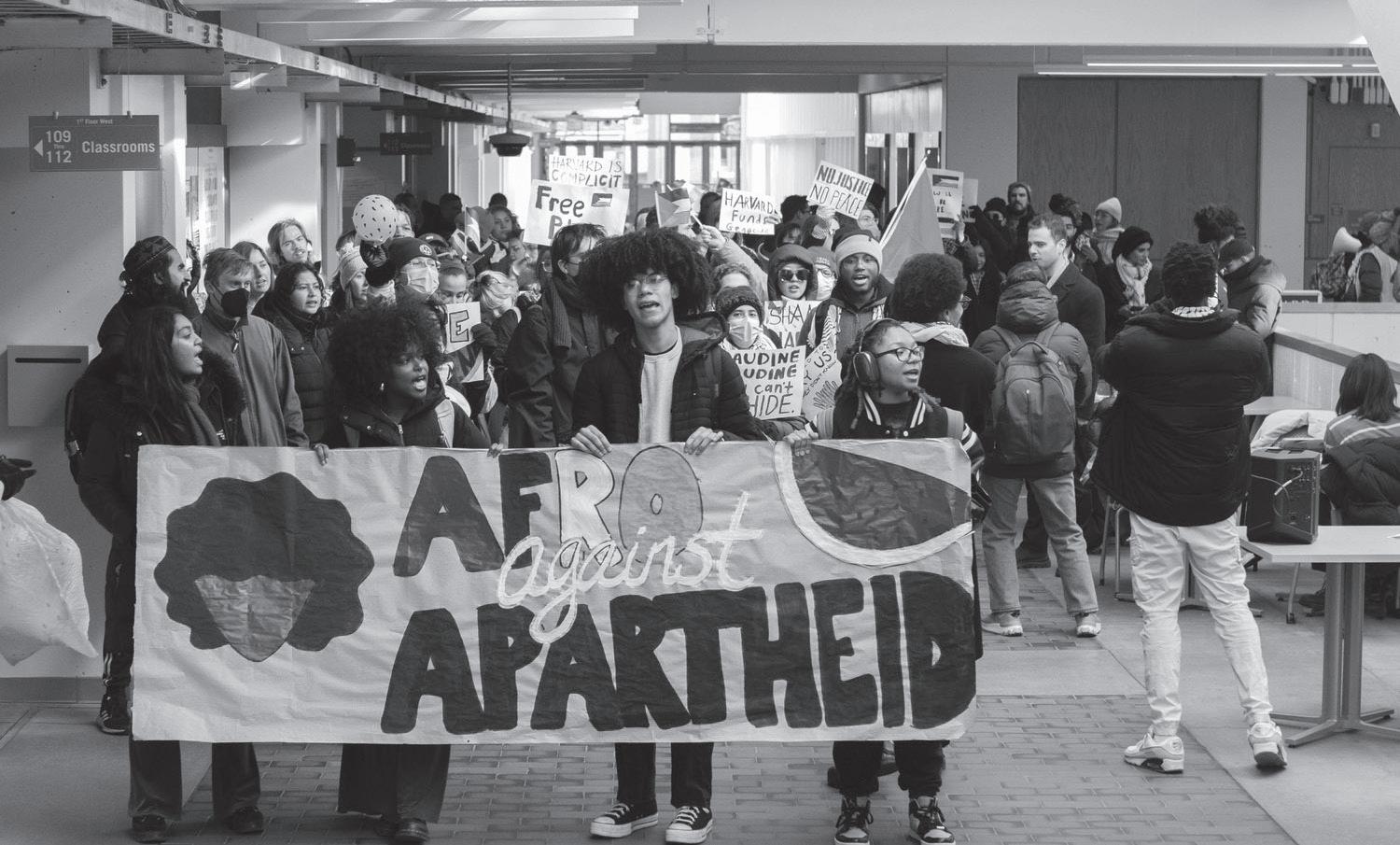
politicized moment for higher education — with Harvard star ing down a lawsuit and congres sional subpoenas — the Univer sity shouldn’t turn its back on debate.
Enos, the Government profes sor, said Harvard should avoid making statements not essential to its mission. But, he added, if the University — which maintains a robust lobbying arm in addition to its public institutional voice — pledged to “stay out of politics” entirely, it could not respond to political attacks on higher edu cation. These, to Enos, represent the academy’s most pressing foe, and so going silent would “be a grave mistake”.
“The greatest threats to academic freedom do not come internally from a university,” Enos said. “They come externally from people like government actors, and — maybe even
status quo.”
“Protest tends to be protest against the status quo,” he said, suggesting that adopting institutional neutrality may allow Harvard to avoid responding to the critiques of its dissenters.
In the case of UChicago, for instance, university leaders have pointed to the school’s guidelines as a reason for resisting calls for divestment: from South Africa to protest apartheid, from Sudan to protest ethnic violence in Darfur, and from fossil fuel companies to protest climate change.
In 2016, UChicago cited its institutional neutrality policy in a statement rebuffing demands to divest from companies doing business in Israel — demands recently echoed by Harvard students.
Salma Abu Ayyash, a preceptor at the School of Engineering and Applied Sciences, wrote in an email that she felt Harvard’s statements on the war have been biased and callous “considering the level of carnage in Gaza.” But, she wrote, silence from the University would serve only to conceal its administrators’ stances.
“I think I would rather have them speak up, even if on the wrong side of history, such as their current cowardly myopic stand on Gaza today,” wrote Abu Ayyash, who is Palestinian. “I am for disruption of academia, and against a sanitized process that allows our students to disengage from issues that they are implicated in, as taxpayers, and citizens of the world.”
Swain, the University spokesperson, declined to comment on Abu Ayyash’s criticisms.
Johnson, the History professor, wrote in her email that she would support a “‘no hot takes’ policy.” But, she wrote, genuine “neutrality” would be a fiction at Harvard — an entity whose very existence, she felt, rests on implicit judgments about the institutions and social fabric that surround it.
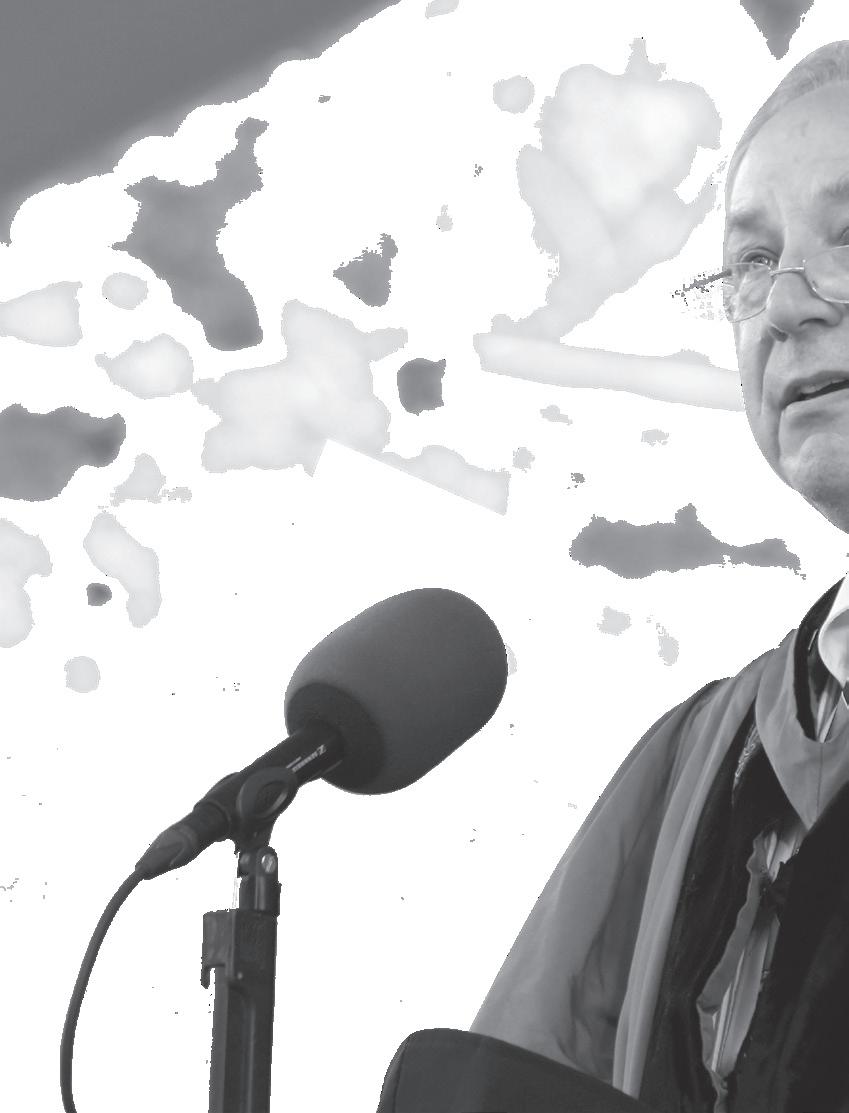
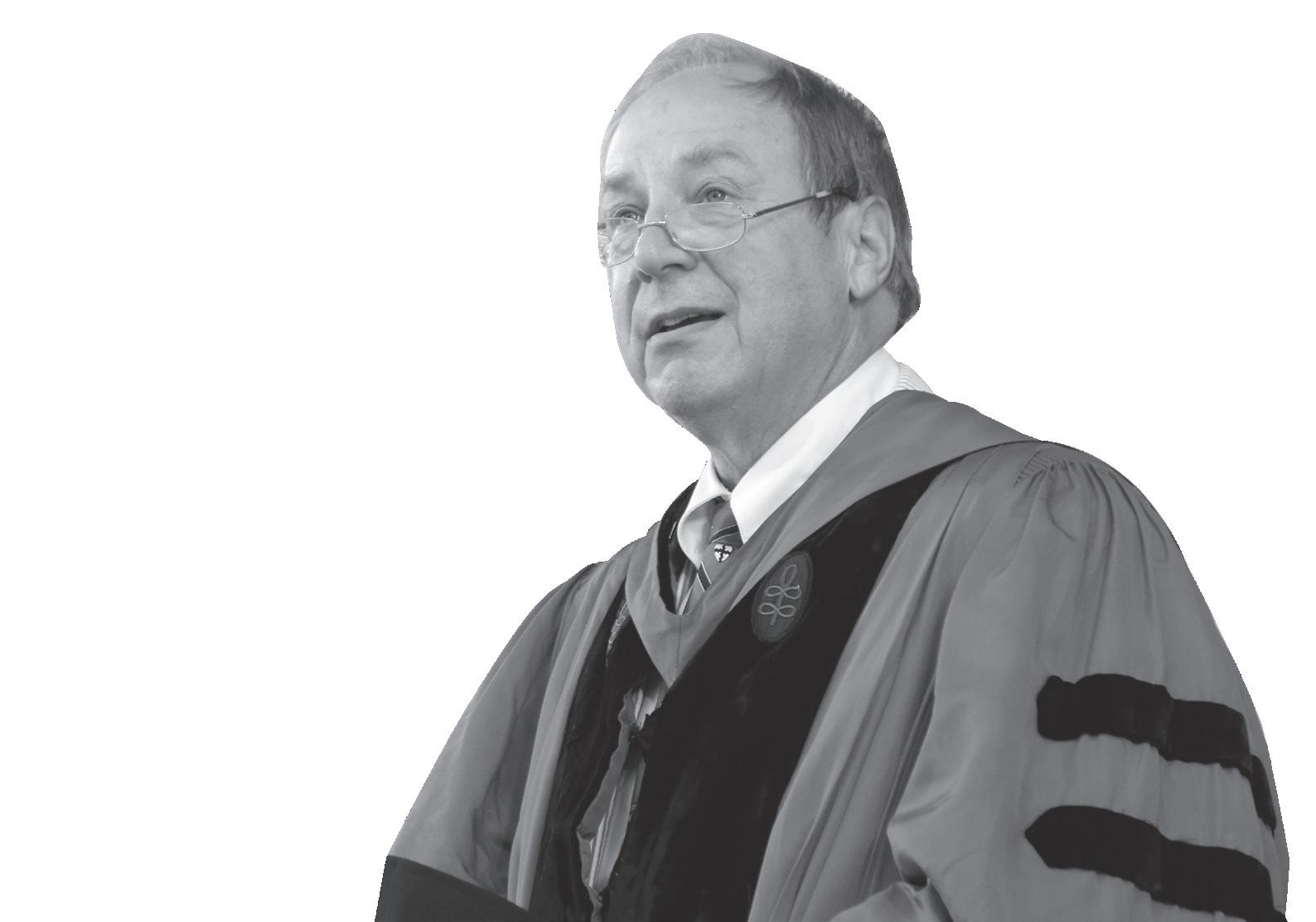
Though an institutional neutrality policy might draw stricter lines around Harvard’s advocacy, it could also leave it largely untouched. Existing policies at other universities typically allow schools to comment on issues that affect their mission or
And it’s not clear how firmly institutional neutrality would restrict Harvard’s behind-thescenes politicking: UChicago, like Harvard, spends six figures annually on its lobbying in Washington.
While amenable to the principles of institutional neutrality, Thomas — the Classics professor — expressed concerns that a neutrality policy could be used to further what he called an “unjust
“Harvard is not neutral about capitalism: it requires a stable and growing economy to fund our work and it invests heavily in the stock market, which implies a literal investment in certain outcomes over others,” Johnson wrote. “Harvard is not neutral about democracy. The freedoms we (faculty, students, staff) cherish depend on it.”
“Our university does not exist outside of history or outside of politics,” she added. “We cannot pretend that it does.”
organization of the division.
BY TILLY R. ROBINSON AND NEIL H. SHAH CRIMSON STAFF WRITERSFaculty of Arts and Sciences Dean Hopi E. Hoekstra hopes to select two new divisional deans — in Science and in Arts and Humanities — within “the next few months,” she said in a Wednesday interview.
In November, Dean of Science Christopher W. Stubbs and Dean of Arts and Human -
ities Robin E. Kelsey both announced they would step down from their positions at the end of the 2023-24 academic year.
The two announcements left Hoekstra — then in just the fourth month of her tenure — in a position to appoint new senior FAS leadership and assert her own direction for Harvard’s most influential faculty.
Her pick for Arts and Humanities dean is likely to be especially consequential, as some faculty have grown frustrated with the division’s contentious strategic planning process and distrustful of Kelsey. The new dean will be tasked with implementing the recommendations of the planning process, which could include a substantial re -
Hoekstra declined to indicate how far along in the search process she was, but said she hopes for “as much overlap as possible” between the selection of new deans and the current ones’ tenures.
Since last semester, Hoekstra said, she has solicited input letters from faculty and staff in the two divisions and conducted a faculty “listening tour.”
“We’ve had really robust responses from faculty — sometimes letters that span five or six pages, mostly in the Arts and Humanities,” Hoekstra said.
Hoekstra reaffirmed her previous commitment to interdisciplinary collaboration
across the FAS’s three divisions, adding that she is seeking deans who will create new opportunities for such work.
“These two appointments are really an opportunity to think about how we may reimagine the divisional structure — in the sense that there’s a real sense that the divisions are siloed,” Hoekstra said.
“What I’m really looking for are deans who want to think about how we make those real parts of those barriers more porous,” she added. In addition to the dean searches, Hoekstra highlighted encouraging civil discourse, considering the use of AI to augment classroom experiences, and fostering inclusivi -
ty and belonging in the FAS as her main priorities for the semester.
Hoekstra, a biologist serving in her first administrative role, has assembled an unofficial cabinet of top faculty and administrators to advise her on “topics of importance.” Stubbs will continue to weigh in on issues regarding artificial intelligence, while FAS Chief Campus Curator Brenda D. Tindal and Government professor Eric Beerbohm were named advisors on academic community engagement and civil discourse, respectively. Hoekstra said Tindal will focus on ensuring “faculty, staff, researchers, and students feel included and feel like they be -
long in our community.”
Tindal’s “first steps are really about outreach,” Hoekstra said, adding that Tindal was set to meet with the Faculty Council Wednesday afternoon.
Hoekstra said her main projects as dean so far — appointing advisors, launching a civil discourse initiative and a committee on classroom conduct, and the dean searches — were united by a concern for the FAS’s “academic mission.”
“All of these really have threads that pull across the FAS, with the goal of bringing our community closer together,” she said.
tilly.robinson@thecrimson.com neil.shah@thecrimson.com
 BY CAM E. KETTLES AND SAKETH SUNDAR CRIMSON STAFF WRITERS
BY CAM E. KETTLES AND SAKETH SUNDAR CRIMSON STAFF WRITERS
Thirty Harvard affiliates gathered to mourn the death of Russian opposition leader Alexey Navalny at a small vigil in Harvard Yard Saturday evening.
Navalny, 47, died on Friday in a remote penal colony in Russia near the Arctic. His death, which was confirmed by his spokesperson on Saturday, came three years after he was arrested upon his bold return to Moscow from Germany where he was recovering from a poisoning attack that left him in a coma for two weeks.
At the time of his death, Na-
valny was serving multiple prison sentences, including a 19-year sentence on charges of “extremism.”
In freezing temperatures, Russian students and affiliates — many of whom were visibly emotional — paid tribute to Navalny with flowers, candles, and speeches in Russian about how they will remember Navalny, a fierce critic of the Russian government who rose to prominence as an anti-corruption activist with a wry sense of humor.
Yulia Gromova, a postdoctoral fellow who attended the vigil, said that when she learned of Navalny’s death, she felt a need to do something to express her gratitude for his service to Russia. In a speech in Russian to the hud-
dled group, Gromova said Navalny’s message of hope will stay with her.
In a 2022 documentary following the poisoning attack, Navalny recorded a message to the Russian people in a final message should he be killed by Russian President Vladimir Putin’s regime.
“The only thing necessary for the triumph of evil, is for good people to do nothing,” Navalny said in the documentary. “So don’t be inactive.”
“He said it in a very serious face, looking in the camera and, in the end, he started laughing. It was a big relief for me because I understood that he knew what he is doing,” Gromova said. “He is supporting you even after his
own death.”
Navalny, who attempted to run for president in 2018 but was denied access to the ballot, nearly died after he was poisoned with the chemical nerve agent Novichok in August 2020. The U.S. government and many Western officials called the poisoning an assassination attempt and blamed it on Putin.
After he recovered in a hospital in Berlin, Navalny decided to return to Russia in January 2021 despite knowing he would almost certainly face arrest upon his arrival. He was often kept in solitary confinement in prison where Navalny and his allies frequently expressed concern about his health condition.
While the exact circumstanc-
es of his death are still unknown and his body has still not been released by authorities, U.S. President Joe Biden blamed Putin for Navalny’s death on Friday, calling it “the consequence of something that Putin and his thugs did.”
Polina Galouchko ’23, master’s student and co-organizer of the vigil, said the event was needed for Russians at Harvard to come together.
“It’s very easy to feel lonely and scared, especially when you’re abroad in a foreign country,” she added.
Galouchko said it was “important” for her to see fellow Harvard affiliates “willing to sit, stand here in the cold wind, and bring flowers and hear other people talk and hug them and be to -
gether.”
An attendee of the vigil who agreed to speak on the condition of anonymity due to safety concerns, said she participated in protests in Saint Petersburg, Russia as a college student following anti-corruption investigations published by Navalny’s team.
The attendee said that marching in the street of Saint Petersburg with her fellow outraged friends gave her a “feeling of belonging.”
“Being a part of the crowd then — when a lot of major investigations that Navalny’s team was putting out were causing big uproar in society — has really changed my life and the way I understand myself as part of Russian society,” she said.
“I really hope that his death will be redeemed in a new big gathering in my favorite city that I will be a part of in the future,” she added.
Olga Borodina, a Ph.D. student, attended the vigil wrapped in a white and blue striped flag, a symbol of opposition to Russia’s invasion of Ukraine.
“When the war started, people created this flag to symbolize that there are Russians that do not agree with Putin’s regime. They want to still show themselves and come to protests and identify themselves as Russian,” Borodina said.
“They created this flag — white, blue, white — removing red from the flag, removing blood and everything associated with the war,” she added.
Borodina, like many of the Russian affiliates at the vigil, said she wanted to honor Navalny’s memory — someone who gave her and others in her generation hope that Russia could one day become a democratic society.
“He galvanized everyone,” she said. “He really made a change in Russian society, including myself.”
“He wanted Russia to be free and happy,” Borodina added.
cam.kettles@thecrimson.com saketh.sundar@thecrimson.com
recently elected bargaining committee — which includes undergraduate and graduate workers across all sectors — has started training under the guidance of UAW members to prepare for upcoming negotiations with University lawyers
and officials.
Organizers attended a fullday training session on Jan. 27, which Syd D. Sanders ’24, an organizer for HUWU-UAW and a member of the bargaining committee, called “pretty straightforward.”
During the session, the group “talked through the process,” as well as the “linguistics and the legal terminology, what we’re allowed to bargain for, what we’re not, how meetings work, strategies,” Sanders said.
The undergraduate students on the bargaining committee will also be joined at the bargaining table by UAW members including Koby Ljunggren, the former president of Harvard Graduate Student Union-UAW and an advisor for HUWU-UAW.
To guide negotiations and strategy, HUWU-UAW organizers distributed a survey to collect union members’ requests and demands.
Olivia G. Pasquerella ’26, a
member of the HUWU-UAW bargaining committee, said the survey was a way to gauge the priorities of rank-and-file members.
“We just wanted to hear from other workers that maybe aren’t in the bargaining committee themselves what their experience is like in their jobs,” said Pasquerella, a Crimson magazine editor.
Some survey topics included hiring practices, what constitutes a fireable offense, the amount of break time, accessibility, and workplace harassment.
HUWU-UAW rank-andfile member Lucy H. Vuong ’26 praised the bargaining committee’s efforts to include all union members in the preparation process.
“I do think that it has been an incredibly clear process and inclusive process for everyone, even people that aren’t directly involved with HUWU’s bargaining committee,” Vuong, a Crimson multimedia editor, said.
Pasquerella said two top priorities for the union are pay increases “across the board” and “better scheduling practices,” including assurance of a job’s existence and of continued employment in the next semester.
The union will bring proposals to the bargaining table, where they will likely meet with representatives from Harvard’s Office of Labor and Employee Relations and the University’s lawyers.
“We’ll do non-economic stuff first, so like sexual harassment protection, scheduling, hiring, onboarding tips,” Sanders said. “We can then end with the wages so that they can’t just try to pay us off.”
HUWU-UAW organizers also plan to request worker information from the University to increase participation in a bargaining goals vote and inform the union’s negotiation. In addition to the demand for bargaining, we’ll submit what’s
an initial RFI, or request for information. What’s really important for that bargaining goals vote is that we are able to inform every unit member,” Ljunggren said. “That first request for information will give us — hopefully — the worker information that we need to be able to contact people.”
According to Sanders, the University has historically been reluctant to share information with student unions, including lists of student workers eligible for the union. “We have to hassle with the school for every information piece that we want and we are legally entitled to,” Sanders said.
Harvard spokesperson Jason A. Newton wrote in an emailed statement that “we look forward to the opening of good faith negotiations with Harvard Undergraduate Workers Union.”
Newton wrote that the process will begin with “working to provide appropriate and accu-
rate information on the bargaining unit, as required, according to National Labor Relations Act rules.”
Austin Siebold ’23, a former HUWU-UAW organizer, pointed to the “exciting opportunity” for Harvard students as “undergrad unions are relatively new.”
Siebold said that because the students “get to be one of the first on a very public stage that is Harvard,” it “could mean that concessions that get made at this bargaining table become that much easier to get at other universities.”
Siebold also pointed to the broader significance of the union’s first bargaining process and contract with the University. “We’re negotiating for a relatively small unit right now that seems like it will expand in the future,” he said. “Harvard is aware of how high the stakes are.”
aran.sonnad-joshi@thecrimson.com sheerea.yu@thecrimson.com
THE HARVARD CRIMSON
FEBURARY 23, 2024
STAFF EDITORIAL
PROTEST GUIDELINES. As it puts its protest policy into practice, Harvard must err on the side of fostering speech, not chilling it. Still, it is surely the University’s rightful prerogative to regulate student protest and, yes, discipline student protestors.
BY THE CRIMSON EDITORIAL BOARDAfter a brief lull, campus protest has returned to Harvard.
Shortly after taking office, interim University President Alan M. Garber ’76 clarified the University’s protest guidelines. Many took the move to signal that his administration would be more swift to discipline campus protestors than its predecessor.
Nevertheless, after a few weeks of relative silence, the familiar sounds of protest again ring out at Harvard and
DISSENT
in Cambridge. So far, pro-Palestinian groups have organized a rally in the Science Center Plaza, a march on the house of U.S. Senator Elizabeth Warren (D-Mass.), and a “die-in” on the steps of Widener Library.
In general, we welcome protest. Free expression is the lifeblood of the University, necessary to ensure that heterodox views can challenge orthodoxies, expand worldviews, and cultivate a spirit of tolerance.
Historically, the right to free expression has empowered marginalized groups to overcome powerful would-be censors and demand more just treatment. It’s no coincidence that generations of civil rights activists advocated for permitting speech, even when vulgar or hateful: They knew that when speech codes crack down, they start at the margins.
Protest, from whatever perspective, undoubtedly has an important place at our institution. That commitment cannot waver, even — indeed, especially — when speech is incendiary or very uncomfortable.
As it puts its protest policy into practice, Harvard must err on the side of fostering speech, not chilling it. Still, it is surely the University’s rightful prerogative to regulate student protest and, yes, discipline student protestors.
Harvard has legitimate reasons to limit protests — they have disrupted classes, blocked thoroughfares, and, in the case of the University Hall occupation, impacted the ability of administrators to do their jobs.
Under the circumstances, we find it strange that protestors at a private institution unbound by the First Amendment feel the University should look the other way when they resist it in ways that hamper its function.
Harvard owes student protestors a clear articulation of the range of consequences that violations of the protest guidelines could produce. But to a first approximation, to protest is precisely to defy the institution. To protest “within the rules” seems oxymoronic.
The recent student occupiers of University Hall un-
With the recent clarifications to its protest guidelines — arbitrarily made and selectively enforced — Harvard has shattered what little reputation it had left as a home for open dialogue.
The guidelines, outlined in an email from interim University President Alan M. Garber ’76, stipulate that demonstrations are prohibited in classrooms, libraries, dormitories, dining halls, Harvard offices, or “other places in which demonstrations and protests would interfere with the normal activities of the University.” Essentially, everywhere.
With their tacit support for Harvard’s new guidelines, the Editorial Board today demonstrates that their commitment to free speech is just as specious as our University’s.
Right now, protest guidelines are being written before our eyes, and they’re being written in response to the content of the demonstrations rather than their form. The University recently began requiring that requests to congregate on Widener Library’s steps “be submitted five business days in advance” in what we
card-making activity for Palestine, Harvard Law School Justice for Palestine were told by administration that the space they planned to use for the event was not reservable. A few days prior, a nearly identical event hosted by the Women’s Law Student Association in the same space came and went without notice.
At a “die-in” hosted by Harvard Out of Occupied Palestine last week, a speaker was told by the Harvard University Police Department that he could not use a megaphone. (Imagine that, a megaphone at a protest.)
To in any way legitimize the creation and implementation of Harvard’s new protest guidelines is to give a blank check to the University’s McCarthyist campaign against pro-Palestine organizing. We are horrified that that check bears our Board’s signature.
The Board’s complicity descends into absurdity with their assertion that the new guidelines will reinvigorate — rather than stifle — dissent. Indeed, the dangerous ambiguity of the protest restrictions has produced a visible and disturbing chilling effect on campus: Two weeks ago, a news piece in this very paper characterized our first week back on campus as “calmer.”
As organizers ourselves, we say with certainty: The prospect of disciplinary consequences has chilled our
about the University’s motives — Harvard is financially and morally invested in the apartheid state students protest against.
Last semester, the University seemingly expended more energy censuring pro-Palestine phrases than addressing the rampant doxxing, anti-Palestinian racism, and Islamophobia threatening its students. As of 2019, Harvard had roughly $200 million of its endowment invested in companies identified by the United Nations as tied to Israeli settlements.
We agree with the Board: Freedom of speech does not mean freedom from consequences. We would know: One of us is currently facing disciplinary action for the occupation of University Hall; the other lives in fear of the same repercussions.
The retaliation we have faced for our organizing is evidently and prejudicially excessive.
Since Oct. 7, voicing support for Palestine has been a one-way ticket to the pages of Canary Mission, the side of a “doxxing truck,” and an appearance before the College’s Administrative Board. Two other editors on the Editorial Board did not sign onto this dissent because they feared the consequences that could follow.
In the Board’s encouragement of transgressive organizing, we hear only an excuse for the reprehen-
derstood this and knew they could face arrests, just as the hundreds of college protestors who demonstrated at Harvard during the Vietnam war.
While we certainly do not support violent reprisals against protestors, the fact remains that many of the most successful protests — the sit-ins of the 1960s, the Stonewall riots, the student protests against the war in Vietnam — also faced the fiercest opposition.
If history is any judge, Harvard’s new posture does not assure the failure of today’s student protestors or those who will follow them. Indeed, it may aid them.
–This staff editorial solely represents the majority view of The Crimson Editorial Board. It is the product of discussions at regular Editorial Board meetings. In order to ensure the impartiality of our journalism, Crimson editors who choose to opine and vote at these meetings are not involved in the reporting of articles on similar topics.
tion. Rather than shutting down discourse, the University should establish forums in which these debates can be had.
Unfortunately, our administration has done the exact opposite. By refusing to meet with students (much less, make progress on the substance of our demands), it has driven organizers to bolder, louder actions — a dynamic that its arbitrary and punitive discipline only reinforces.
If these new protest guidelines are indicative of anything, it’s a growing pro-Palestine consensus among our student body. The Board would be wise to side with its fellow students — and history — rather than a draconian administration intent on silencing them.
– Mahmoud M. Al-Thabata ’27, a Crimson Editorial editor, lives in Holworthy Hall and is an organizer with the Harvard Undergraduate Palestine Solidarity Committee. Violet T.M. Barron ’26, an Associate Editorial editor, is a Social Studies concentrator in Adams House and an organizer with Harvard Jews for Palestine.
 BY CHANDEN A. CLIMACO
BY CHANDEN A. CLIMACO
Most proposals to make Harvard more inclusive are either expensive (campus expansion) or illegal (race-based affirmative action).
Broader access to higher education is certainly a goal worth striving for. But many reforms, if enacted, would ultimately have little-to-no impact on most people. Every year, hundreds of thousands of high school graduates apply to colleges and receive zero acceptances. Even the more ambitious proposals — enrolling an extra thousand students per year, for example — would barely make a dent in the problem.
What we need is a way to extend Harvard’s reach that is not only inexpensive and legal, but that also benefits more than just the lucky few thousand our campus can house.
Sounds like a pipe dream. It’s not.
In fact, the solution already existed: EdX, a nonprofit online education platform founded in 2012 by Harvard and MIT has offered classes to millions of learners worldwide since its inception, totally free of charge. Flash forward to 2023 and the schools have sold edX to a for-profit company now at risk of bankruptcy, endangering the future of accessible online higher education.
Let me explain.
To Harvard students, CS50 — the University’s
crash course to computer science — holds repute as one of the campus’ largest courses and perhaps its most over-the-top lecture class, complete with a capella performances, an all-nighter hackathon, and a visit from Boston Dynamics’ robotic dog.
Outside of Harvard’s campus, though, CS50 is known as the world’s most popular online course. It’s frequently recommended on “best online coding courses” lists, and for good reason. Every lecture is available in ultra-HD, and the course offers graded problem sets, recorded sections, and options to interact with your classmates, ask questions, or even say hello to professor David J. Malan ’99 himself!
It’s impressive stuff. It’s also free.
Since its first online offering through edX in 2012, more than 5.4 million individuals around the world have learned to code with CS50.
Malan’s course was one of the platform’s first. Over the next decade, edX partnered with dozens of the world’s best universities to host more than 3,500 courses for 40 million learners. It was a stunning display of how impactful digital learning can really be.
But in 2021, Harvard and MIT sold edX to a for-profit corporation for $800 million. In the sale, the corporation promised to keep their courses free — for five years, that is.
That corporation, 2U Inc., was the target of a recent lawsuit alleging it had used falsified data to attract students to programs co-hosted with the
University of Southern California. A former professor who was slated to administer a program with 2U, Ashley Bell, claimed that the company aimed to use their course as a “cash cow,”saying 2U “made it obvious that they didn’t care about the quality of the program” when she resigned in protest. Time is ticking. In two years, 2U’s agreement to keep courses on edX free will expire. One can imagine what a for-profit education corporation will do when it is allowed to charge for Harvard lectures.
But, even more concerningly, it seems 2U might be going under. Its stock price has declined 99 percent in the past five years, it last reported nearly a billion dollars in debt, and it’s made significant layoffs since acquiring edX. 2U has itself reported concerns about its ability to stay afloat.
Bankruptcy would leave millions of learners in the dust, including the tens of thousands of students in the official degree-granting programs universities contract 2U to host on its digital infrastructure. It would be — by all measures — a catastrophe.
Harvard seems to recognize that this hole should not go unfilled — or at least it purports to. With the $800 million from edX’s sale, Harvard and MIT launched a new nonprofit called Axim Collaborative that aims to build on edX’s “commitment to educational equity,” but I’m skeptical. Why try to fix something that wasn’t ever broken?
Dissenting Opinions: Occasionally, The Crimsonpress in a staff editorial. In these cases, dissenting board members have the opportunity to express
Their plan to fund the nonprofit offers a telling indication: Harvard and MIT plan to limit their expenses on the project to only cash generated from the interest on edX’s sale. They’ve offered few details on their plans for Axim, leaving some concerned about its ability to offer a real replacement for edX.
It’s a far cry from the ambitious goals they had for edX and a disappointing betrayal of then-Faculty of Arts and Sciences Dean Michael D. Smith’s lofty promise for edX to “change the way education is done across the world.”
It’s also a discouraging sign for the online education movement more generally: Two of the world’s most prestigious universities selling their online education brainchild is assuredly demotivating for other institutions who may have sought to universalize their own courses. The story of edX has demonstrated the difficulties of democratizing access to knowledge, but there is no need to end the story here. The online education revolution still holds great promise — so long as it is not overrun by ruinous profit-seeking. As the promise of edX fades, Harvard must ensure that its original mission — making the world’s best education available to everyone — doesn’t fade with it.

RISHI
gram post. A few people drafted it; perhaps a few more reviewed it; someone, in the end, pressed post.
BY THE CRIMSON EDITORIAL BOARDThis Monday, two pro-Palestine campus groups released a post on Instagram containing a cartoon that was unequivocally and reprehensibly antisemitic.
That the naked antisemitism of that graphic almost certainly passed through multiple hands without setting off alarms boggles the mind. With temperatures on campus as high as they are, this post demonstrates serious, condemnable recklessness by the Harvard Undergraduate Palestine Solidarity Committee and the African and African American Resistance Organization.
Still, the Instagram post was just that: an Insta-
This one post does not tell us what the dozens of other members of these two organizations believe. It does not tell us what the pro-Palestine coalition at Harvard believes. It most assuredly does not tell us what the national pro-Palestine movement believes, nor does it invalidate their essential aims.
All this Instagram post tells us is that Monday afternoon a handful of activists failed to exercise even the most basic sensitivity.
Still, there’s something more general to be taken from this brief, alarming episode: Even if the vast majority of our peers do not harbor hate toward the Jewish people — and we sincerely believe they do not — they most certainly do engage in the garden-variety ignorance and callousness that falls short of outright antisemitism.
Hatred against Jews gets noticed because it is loud; prejudice, more common by far, often passes in silence.
That the blatant antisemitism of the cartoon
DEPLATFORMING. If Harvard aims to train the next generation of leaders, students must learn how to en gage with and respond to attacks on our democracy.
BY MAYA A. BODNICKWe should invite MAGA Republicans to speak at Harvard — even though they’re fascists. Let me explain.
Each year, the John F. Kennedy Jr. Forum at the Harvard Kennedy School hosts speaker events with some of the world’s most powerful leaders. Since August 2023, the Forum has invited 11 Republican politicians to speak.
That number isn’t small, and I applaud the Forum’s efforts to introduce intellectual diversity by platforming conservative opinions that are underrepresented on campus. As a matter of fact, if you attended those events, you might actually get a positive sense of the Republican Party — a sense that it supports democracy, patriotism, and moderation.
That’s because the Forum’s Republican speakers have one thing in common: They’ve all condemned the Jan. 6 insurrection (or in Jeffrey J. Denham’s case, stayed silent on it).
third of Americans who identified as Republican believed that the 2020 election results were legitimate. Many Republican leaders who originally condemned the Jan. 6 attack are now supporting Donald J. Trump’s 2024 election bid — despite his promise to be a dictator on “day one” of his second term. Numerous historians have argued that these politicians and their willingness to destroy American democracy amounts to fascism. For example, Columbia University professor and fascism expert Robert Paxton wrote after Jan. 6: “I have been reluctant to use the F word for Trumpism, but yesterday’s use of violence against democratic institutions crosses the red line.”
in the AFRO-PSC Instagram post wasn’t caught suggests that — like many of us — people in the pro-Palestine coalition have learning to do: about Jewish people, their culture, and the violent, millennia-long history of their persecution.
For all people and in all places, discussion across difference is of the utmost importance. These issues are hard. Discussing them is hard. But they only become harder if we don’t understand the people on the other side, much less trust them or see their perspective.
In this sense, engaging in dialogue is one of the most progressive things we can do. Through it, we lay the foundations for a better world, even as the path by which it might become real remains hazy. Since the violence of Oct. 7, discussion has taken a backseat to protest; chants have drowned out conversation. With the stakes so personal and the lights so bright, it should come as no surprise that we have spent so much time shouting past one another. Campus discourse has gone toxic, and this ugly, thoughtless Instagram post is the worst of it.
So, to the Harvard community: It’s time to talk to each other; to be mindful of what we say and how we say it; to engage with the best intentions and see the best intentions in others; to seek out uncomfortable conversations with courage and humility. It’s time to replace this pain, anger, and unease with empathy and a willingness to learn.
Discourse alone is no silver bullet. Sometimes, hate is just hate — not ignorance waiting to be vanquished by dialogue.
Still, imperfect, frustrating, and slippery as it is, discourse is often all we have. After five long months at each other’s throats, let’s let this antisemitic post kickstart the conversations that could stop us from reaching a sixth.
–This staff editorial solely represents the majority view of The Crimson Editorial Board. It is the product of discussions at regular Editorial Board meetings. In order to ensure the impartiality of our journalism, Crimson editors who choose to opine and vote at these meetings are not involved in the reporting of articles on similar topics.
Iam Jewish. Throughout my life, I have experienced antisemitism in countless ways. In eighth grade, classmates would “sieg heil” when passing me in the halls. One told me Hitler was his hero. I’ve had pennies thrown at me, and I’ve been grilled by coworkers on my “allegiance to Israel” after they learned my faith.
Naturally, when I saw a patently antisemitic cartoon shared by my peers on Instagram this Monday, I was appalled.
The image was featured in an infographic slideshow on Black and Palestinian solidarity jointly posted by the Harvard Undergraduate Palestine Solidarity Committee and the African and African American Resistance Organization — an unrecognized student organization that has taken the lead in pro-Palestinian protests on campus. The infographic circulated and was reposted by Harvard Faculty and Staff for Justice in Palestine before being taken down and reposted with the antisemitic image removed.
Backlash should be expected. Over the last five months, it has become clear that conduct at Harvard regarding Israel and Palestine will be over-examined, nitpicked, and de-nuanced by others. That inherently makes reckless and careless conduct from student organizations all the more harmful.
It shifts focus away from Gaza, where over 29,000 Palestinians have been killed according to Gaza health authorities; where nearly two million Palestinians are internally displaced; and where, according to Israeli intelligence, 29 Israeli hostages are dead and over 100 remain in Hamas’ hands.
It ostracizes progressive Jews from the movement by demonstrating an inability to unequivocally separate staunch criticism of Israel and legitimate calls for Palestinian self-determination from hateful antisemitic tropes.
It makes it easier for critics that don’t give a damn about Palestinians to dismantle activism efforts on our campus, convoluting the already complex task of separating real claims of antisemitism from accusations intended to silence pro-Palestinian protest.
‘Deplatforming’
Forum speakers Roy D. Blunt, Rodney L. Davis, and Rep. Mike J. Gallagher (R-WI) voted to certify the 2020 election in Congress. Elaine L. Chao and Mick Mulvaney resigned from the Trump administration after the Capitol attack. Former Representative William B. Hurd called the attacks “a coup,” Utah Governor Spencer J. Cox described the insurrection as “evil,” and Wyoming Governor Mark Gordon declared it an “affront to the very Constitution that has made our country what it is.” Then-acting Attorney General Jeffrey A. Rosen said he prevented former President Donald J. Trump from using the Justice Department to overturn the election. And former Speaker of the House Paul D. Ryan said he was “absolutely horrified” by the Jan. 6 riot and sobbed as he watched the attack occur.
We’d be living in a different world if these Republican defenders of democracy ran the country — but the reality is, they don’t. By cherry picking these moderate Republicans, the Forum gives the Harvard community a warped sense of the current Republican Party.
The majority of congressional Republicans voted against certifying U.S. President Joseph R. Biden’s lawful 2020 election victory, threatening to undermine 250 years of American democratic tradition. As of the end of last year, less than one
I’m terrified by the fascist takeover of the GOP and its implications for the future of our country. But that’s exactly why we must allow these fascists to speak at Harvard. If Harvard aims to train the next generation of leaders, students must learn how to engage with and respond to attacks on our democracy.
Keeping Republican fascists from speaking at Harvard doesn’t actually limit their influence. These figures are well-known politicians — they have huge platforms already, receiving enormous amounts of media attention and spreading their antidemocratic ideas to thousands (or in some cases millions) of followers on social media. They don’t need to speak at Harvard to get their message out.
It’s also wrong to think that hosting speakers necessarily legitimizes their ideas. When we host these speakers, we should be hyper-critical. The Forum and other student organizations should have incisive moderators challenge the speakers and should open up the floor for students to ask hard questions. This would give Harvard students a valuable opportunity to learn how to respond to fascist ideas. And in the age of social media, one of these interactions could go viral — and expose the danger of Republican authoritarianism to millions of Americans. When the fascists come, they should be ready to face opposition and disagreement.
“Deplatforming” these speakers doesn’t really work and actually just insulates Harvard students from views held by tens of millions of Americans.
In a time when fascism has taken over the Republican Party, so many of us at Harvard are terrified about the future of American democracy. But this fear can’t prevent us from engaging with these horrific, antidemocratic ideas: We can’t look away as our democracy crumbles.
Realistically, I wouldn’t have to spend more than 20 minutes in a Holocaust museum to encounter similar drawings directly alluding to conspiracies of blood libel or a Jewish cabal of elites puppeteering the world.
The distribution and normalization of these images and ideas — in publications like “The Protocols of the Elders of Zion” — directly contributed to genocidal campaigns against the Jewish people, and continue to evolve and pervade public discourse. Strikingly disturbing were the image’s details: two men of color, strung up by their necks, the rope held by a hand imprinted with a Star of David and a dollar sign. I thought back to the sixth grade class I taught at my synagogue about Black and Jewish solidarity in the United States. Not only is the image antisemitic — its use forgets and corrupts that powerful history. While I believe that antisemitism has pervaded some aspects of the pro-Palestinian movement outside of our campus, I have long felt that accusations of antisemitism on Harvard’s campus have been inflated to inhibit pro-Palestinian activism. Outside media coverage — somehow more focused on the University president’s alleged tolerance for antisemitism than protestors elsewhere chanting at hospitals and Jewish restaurants — has falsely convinced many casual observers that Harvard is a breeding ground for people who believe I have horns under my curls.
As many have rightly pointed out, demanding justice for Palestinians is not inherently antisemitic. And with a duty to call out the weaponization of antisemitism, we also have a duty to call out its real and alarming presence.
This case was elementary.
It’s clear that in the process of producing this infographic — as with the PSC’s statement after Oct. 7 and the continued use of unproductive and inflammatory slogans by a very vocal few — there was not a concerted evaluation of the potential for collateral damage by AFRO or the PSC.
And it damages the ability to have constructive dialogue on a campus full of smart, thoughtful, and caring people that want peace and prosperity for Jews and Palestinians alike in their ancestral lands.
But what the outsider obsessed with Harvard must understand (and perhaps doesn’t want to) is that some of the only people on Harvard’s campus who reached out to me on Oct. 7, and who have actively engaged in difficult conversations about Israel, Palestine, and antisemitism with me, are members of the organizations that made this post. They’re also my friends.
That’s why I would be surprised if the infographic was looked over by more than a few people for more than a few seconds in the first place, which is a failure on its own.
Maybe these shortcomings stem from organizational mismanagement, a lack of awareness, or a fear that acknowledging or listening to criticism will be misconstrued as a surrender to pro-Israel, anti-Palestinian actors. Maybe this instance was somehow just an ignorant mistake.
Regardless, PSC and AFRO leaders have repeatedly failed to wholeheartedly distance their actions from the antisemitism that pervades parts of the Palestinian solidarity movement. It’s impossible to ignore the damage it’s done to the efficacy of their cause on campus.
These organizations must do some soul-searching, evaluate their procedures and values, and reckon with the fact that blatantly antisemitic rhetoric and imagery was neither identified nor removed internally before they shared it with the world. A deleted post and swift institutional apology will not be enough. As entities dedicated to progress, PSC and AFRO have serious work to do.
In the meantime, I just pray we keep talking to each other.
–Matthew
DAY SHELTER. La
Colaborativa will serve Cambridge families as a service center located in
BY LAUREL M. SHUGART CRIMSON STAFF WRITERLa Colaborativa, an immigrant social service organization in Chelsea, opened a walkin day services center on Tuesday for families staying in the state-run emergency homeless shelter in Cambridge, which has struggled to transition its residents into permanent housing.
The shelter, which opened in December, was originally intended to temporarily host families who qualify for the state’s Emergency Assistance program. However, many residents have stayed for months, putting pressure on the state and city to keep the shelter open during daytime hours.
Currently, the shelter operates from 6 p.m. to 9 a.m., making it the only temporary emergency family shelter in Massachusetts not to be open 24/7. When 9 a.m. rolls around each day, the shelter’s residents are
left — often in the bitter cold — to find shelter, food, and resources on their own.
“As we’re facing an unprecedented state of emergency, it’s critical that all residents have access to safe, dignified shelter, especially over the frigid winter months,”
Gladys Vega, the CEO of La Colaborativa, said in a Feb. 16 press release. The day service center, located in La Colaborativa’s headquarters in Chelsea, operates from 9 a.m. to 5 p.m. on weekdays. La Colaborativa plans to arrange transportation between the overflow shelter and its site, which can accomodate up to 200 individuals during the day.
The center will provide breakfast, lunch, and snacks in addition to hygiene items, infant supplies, clothing, and other basic household necessities.
Additionally, on-site case managers will work with families at the service center to provide assistance with housing program applications, immigration support, and obtaining work authorization.
The city — which has asked state officials to open the shelter 24/7 — has also worked to provide daytime resources to the shelter’s residents, connecting them to services at li-
braries and other community centers, city spokesperson Jeremy C. Warnick wrote in an email.
Cambridge Public Schools have been routinely enrolling children staying in the shelter since January and created a new school bus stop to transport children from the shelter to their schools.
In order to make the overflow site livable for families, the Healey administration allocated $175,000 in renovations to the site prior to the shelter’s opening, updating fire safety equipment and plumbing.
The state also provided funding to the nonprofit United Way of Massachusetts Bay to establish the Safety Net Shelter Grant program, which provided the funding for La Colaborativa’s day shelter.
“Recognizing the countless lives at risk, we’re grateful to collaborate with the United Way and HealeyDriscoll Administration to deploy our unique, trauma-informed model of providing a culturally familiar, welcoming day center with comprehensive housing, economic, and wraparound services, which are vital to the wellbeing of homeless families,” Vega said.
laurel.shugart@thecrimson.com
The debate over bike lane expansion continued to swirl in Cambridge following the
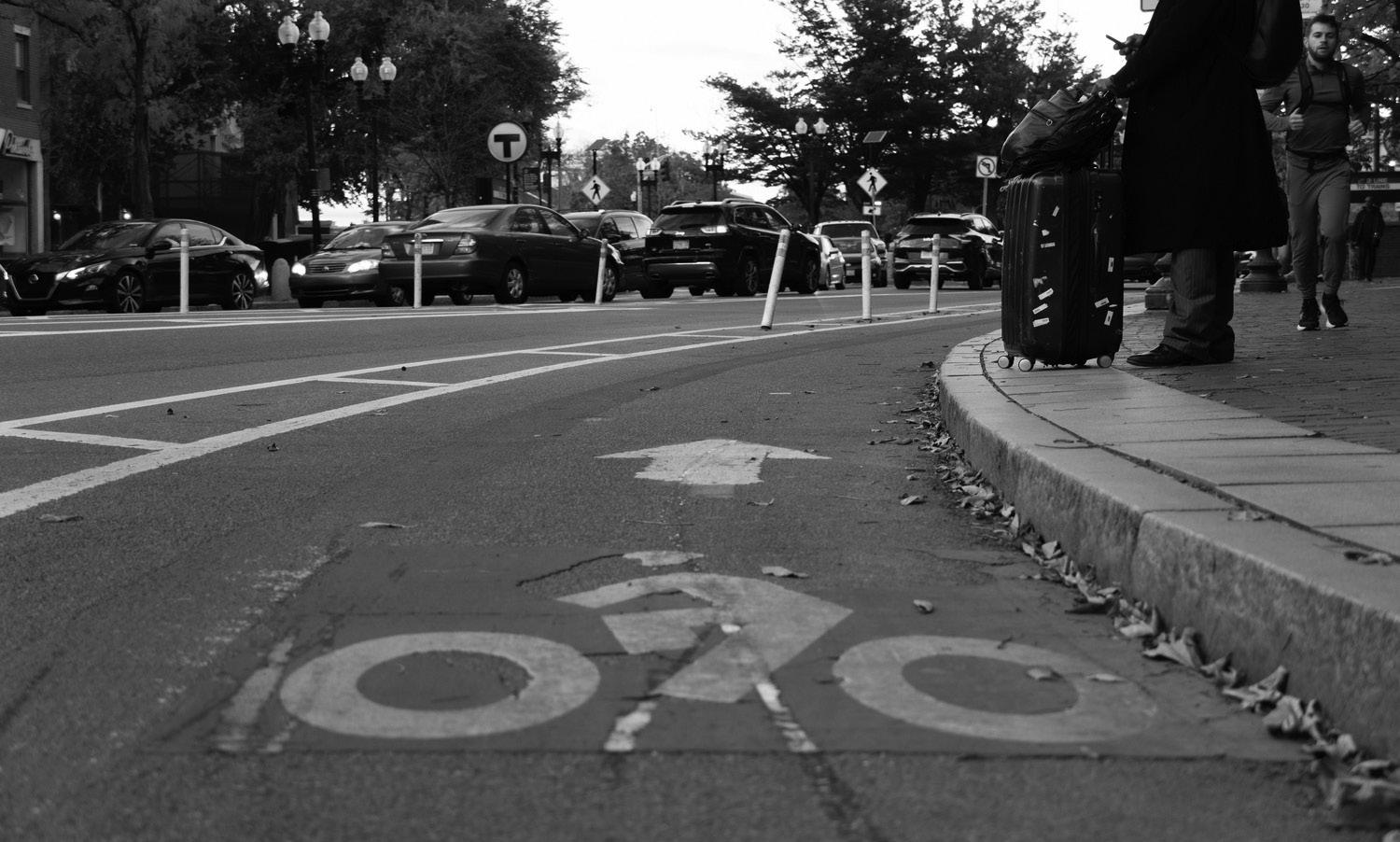
really want to be driving.”
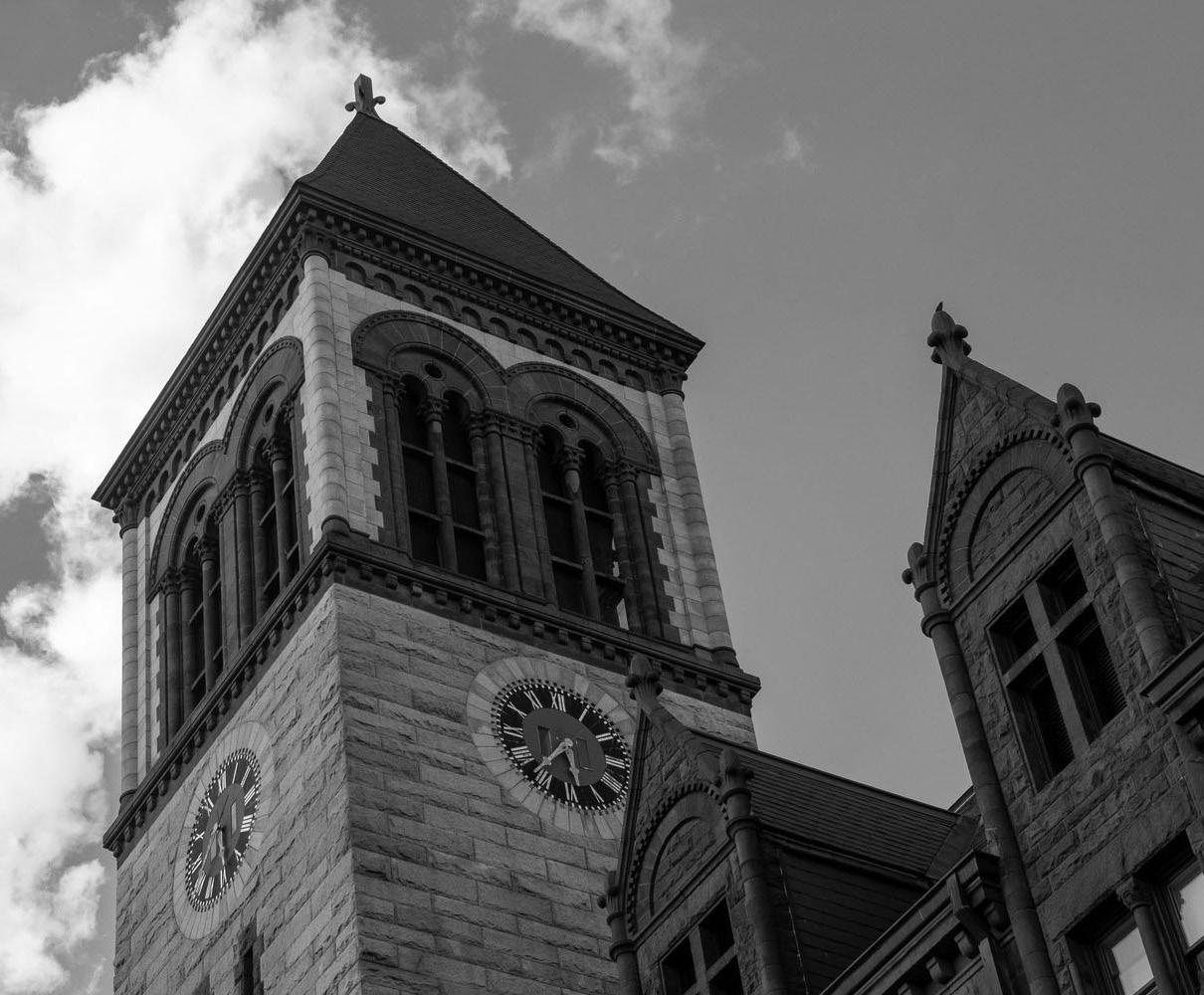
La
was obtained by the Eagle Tribune.
The
The
survey results in the study revealed that more than 60 percent of the business owners believe their revenues declined following the installation of the bike lanes.
“That is what they’re feeling.
That is what their experience is. And even though it couldn’t be matched up with financial data, it’s still a great concern as to what is happening with our businesses,” Councilor Joan F. Pickett said.
John Hanratty, a member of the Cambridge Streets for All, a transit advocacy group, said that the real problem is congestion and parking for the small businesses.
“We don’t know whether traffic is more congested or not as we push traffic off of certain streets. We don’t know anything about the shop owners, or the traffic that they’re seeing,” Hanratty said.
“Whether they’re pedestri-
ans or handicapped or they’re bicyclists or cars, we need to collect more relevant data to this problem,” he added. Councilor Burhan Azeem said the city should focus on how it can continue to support Cambridge residents through the change, citing the various city-led studies, as well as discussions between officials and small businesses.
“All of us care about small business owners, and we’re trying to figure out what exactly the middle ground looks like for everyone,” Azeem said.
Itamar Turner-Trauring, a member of Cambridge Bicycle Safety, a volunteer organization that has advocated for the construction of separated bike lanes, said that the goal of the ordinance is to build a network that allows bikes to safely travel anywhere in the city. “If you have just random stretches of dangerous streets, then people can’t bike, which means biking is a less useful form of transportation,” Turner-Trauring said.
Janie Katz-Christy, another member of Cambridge Bicycle Safety said that bike lane expansions are “better for the people who
However, some students have reported that this feature does not work with their HUIDs.
Jack P. Flanigan ’27 said that after discovering that his HUID did not work when trying to take the
“It doesn’t hurt anyone. It helps everyone,” she added. “It helps pedestrians by slowing down the cars, by narrowing the space allotted to them, and it helps the people who really need to be driving.”
The economic impact report recommended the city establishes a systematic way to evaluate the impact of future projects, including collecting and comparing baseline information before and after the implementation of the bike lanes.
According to Pickett, the Council will hold a follow-up meeting to further discuss improvements for future bike lane expansion early next month.
While McGovern said that the Council has to “continue to engage our business community,” he said that it needs to be clear that the city is going forward with the Cycle Safety Ordinance.
“The question is about how we do the implementation and not if we do the implementation,” he added. “We should be working together to come up with the how.”
ayumi.nagatomi@thecrimson.com
MBTA, he reported the issue to Harvard University ID Services. Flanigan, a Crimson Editorial editor, was informed that there was an issue with the card his ID was printed on and was given a free replacement.
Experts and local leaders called the threat of two Boston hospitals’ closures a potential “catastrophe” at a city council hearing Thursday as Massachusetts officials respond to an ongoing financial crisis at one of the state’s largest hospital chains.
St. Elizabeth’s Medical Center in Brighton and Carney Hospital in Dorchester are both at risk of closure following reports last month that Steward Health Care, a national for-profit hospital chain, is behind $50 million on rent in its Massachusetts locations. The chain’s financial trouble has made its viability a top issue among local leaders over the last month as they work to keep its nine Massachusetts hospitals open.
At the hearing, city councilors, hospital employees, public health officials, and policy experts explored the wide range of ramifications of a potential closure on the city, from patients’ health to the local economy.
“We couldn’t possibly suffer the blow of losing what St. Elizabeth’s brings to our community,” said Ellen MacInnis, a board member of the Massachusetts Nursing Association and registered nurse at St. Elizabeth’s.
Councilor Elizabeth “Liz” A. Breadon, whose district covers Allston and Brighton, noted that St. Elizabeth’s is the largest employer in her district and has existed there for over a century. She also pointed out the burden St. Elizabeth and Carney Hospitals’ closures would place on other health care institutions in the city.
“If this system goes down,” Breadon said, “there’s no way” other providers in the city can assume all of thier patients.
Dr. Bisola Ojikutu, Chief of the
“Someone printed this on the wrong kind of ID,” Flanigan said.
It is unclear what is causing some HUID cards to not work as CharlieCards. According to Flanigan, his HUID was missing a Char-
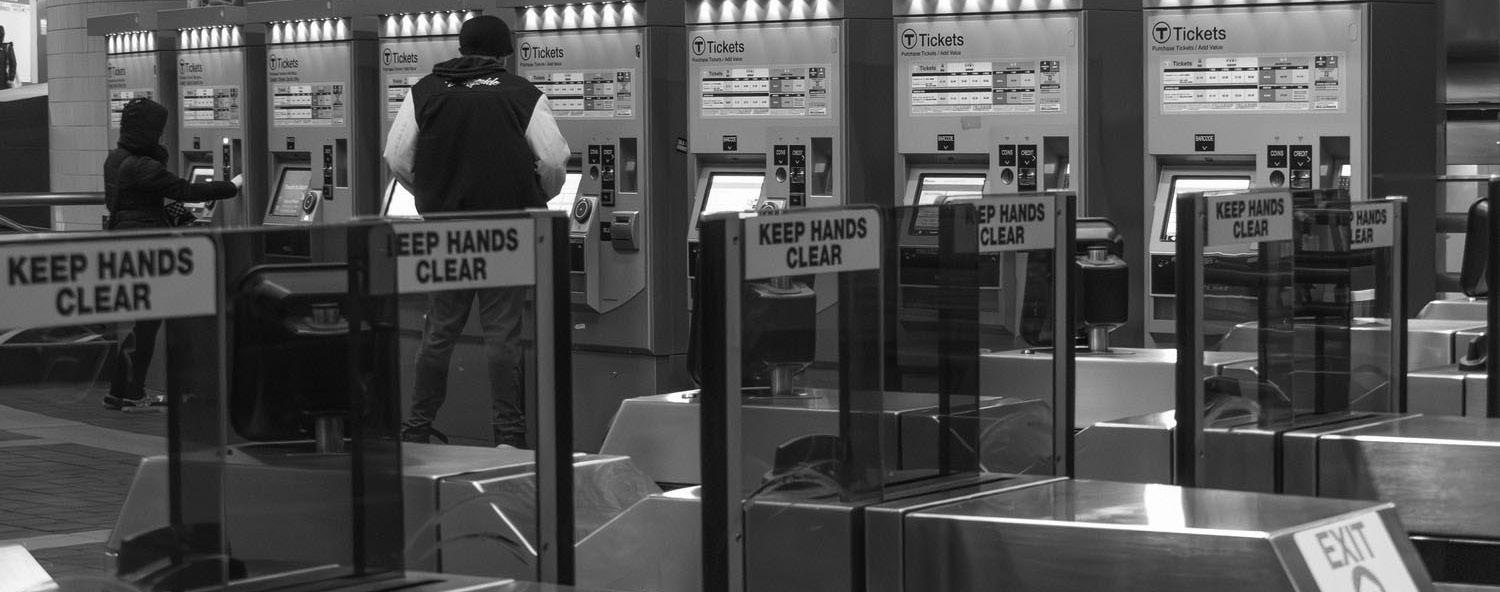
Boston Public Health Commission, said Mount Auburn Hospital in Cambridge is the closest hospital to St. Elizabeth’s and its closure would add a “time delay” for people and ambulances getting to the hospital.
Earlier this month, Steward announced that they had found enough money to keep all its hospitals in the state open. Despite their announcement, some officials have remained skeptical, and the threat of the hospitals’ closures remained a consistent theme in testimony during the hearing.
Panelists also put blame for the crisis on both the state, which they accused of inadequate oversight and regulation, and the for-profit healthcare model more broadly.
On Tuesday, Massachusetts Governor Maura T. Healey ’92 demanded the immediate disclosure of financial documents in a letter to Steward CEO Ralph de la Torre.
“This is not a new issue. For years, you have refused to engage in the same level of basic transparency that every other system in Massachusetts offers by not releasing your audited financial statements,” Healey wrote. She added that refusing to release the documents is “an affront to the patients, works, and communities that the Steward hospitals serve” and “creates a major roadblock to our ability to work together to resolve this effectively.
In addition to the release of financial documents, Healey called on de la Torre to permit expanded monitoring by the Department of Public Health with “full collaboration and compliance” and guarantee supply levels as well as safe staffing at each Steward facility in Massachusetts.
Steward Executive Vice President Michael G. Callum responded to the allegations that they did not comply with state regulations in a letter to Healey on Thursday which
lieCard serial number, which allows students to access MBTA services, according to the
In the letter, Callum listed materials that Steward Health Care gave to the Attorney General and the Executive Office of Health and Human Services in the past two months, including financial documents from the end of 2017 to 2022.
“We remain committed to continuing an open process with you and your administration, and will continue to share as much as possible given various regulatory and contractual constraints we are obligated to honor,” Callum wrote in the letter.
Callum indicated that Steward would comply with a potential transfer of ownership of its hospitals.
Despite the risks highlighted in the hearing, officials stressed that both hospitals remain open and fully functional for the foreseeable future.
Breadon said that state law would require notice of at least four months prior to the closure of either hospital, adding that “there is a process, and none of these hospitals are going to close imminently.”
While the hearing also explored ways forward, officials admitted the city had no direct authority over the hospitals, which instead fell under state power. For some local health organizations, the potential closures remain top of mind without further communication from state and local officials. A spokesperson for Charles Community Health Center in Allston wrote in an emailed statement that they do not have capacity to take the extra load in the event of service reductions from St. Elizabeth’s.
New ownership might mean “those patients and needs would fall through the cracks,” he wrote.
“I
said the war in Ukraine will decide “the future of Europe” during an event at the Davis Center for Russian and Eurasian Studies Thursday afternoon.
from Russia’s brutal full-scale invasion of the country and Trofimov’s career as a two-time Pulitzer Prize finalist for his work as a war correspondent.
Ukraine is “the most dangerous war to cover as journalist.”
“At least in Afghanistan and Iraq, you had the illusion of control of the environment,” he said.
BY JO B. LEMANN AND ANGELINA J. PARKER CRIMSON STAFF WRITERSaroslav Trofimov, chief foreign affairs correspondent for the Wall Street Journal,
“Ukraine — it probably has the highest stakes of many other wars I’ve covered, for sure,” Trofimov said. The event, which was moderated by Ukrainian history professor Serhii Plokhii, discussed Ukraine’s struggles on the frontlines as it seeks to defend itself
Trofimov, who was a Pulitzer finalist in 2022 for his coverage of the Taliban takeover of Afghanistan and again in 2023 for his coverage from the ground in Ukraine, started the event by comparing his experience reporting in Afghanistan to Ukraine.
Trofimov said that the war in

“The Taliban didn’t have an air force, they didn’t have an artillery. You knew what areas were more or less safe,” he said. “Whereas in Russia, death can get you anywhere.”
“I think seven or eight of the hotels where I stayed in — places like Kharkiv or Zaporizhzhia — had been destroyed by Russian missiles since then,” said Trofimov.
Trofimov, who is Ukrainian, also talked about his experience covering the Russo-Ukrainian war in the city he grew up in.
“I was in the middle of Kyiv, standing all alone in the street that was empty because everybody had gone or was hiding, wearing a helmet and body armor, and thumps of artillery were background noise to it.” he said. “It felt like a personal insult — almost an injury — sort of feeling that, ‘How dare they?’”
“It’s a city where every corner
of geography was intimately connected with my past,” he added. “I remember the botanical gardens when I used to go on dates; the hospital where my grandmother used to take me to check out my eyes was now housing the wounded.”
Trofimov said that the extent to which the war was personal gave him “extra motivation to go out and to go to the frontlines.”
Trofimov and Plokhii also mentioned the 2022 peace talks in Istanbul between Russia and Ukraine, which Trofimov said failed after Ukrainian President Volodymyr Zelenskyy witnessed the aftermath of Russia’s massacre in Bucha.
“So 400 plus civilians in a small town were executed. There were bodies with their hands tied behind their backs found on the courtyards and dismembered corpses in the streets,” he said. “It was a shock to Zelenskyy who came to Bucha — it was the first time he left the city of Kyiv since the war began.”
“There he said, ‘How do we talk to these people? What is there to
talk about the people who are basically committing genocide?’” Trofimov added.
Trofimov also spoke about the United States’ failure to send much needed aid to Ukraine, an effort that has stalled because Speaker of the House Mike Johnson (R-La.) has refused to take up a bill passed by the Senate that would provide $95.3 billion in foreign aid.
“Now because of internal political reasons in the U.S., American military funding has stopped now for four months,” he said. “And Ukraine is once again outgunned and is losing ground because it just doesn’t have enough ammunition.”
Despite recent battlefield losses for Ukraine and a lack of military assistance from Washington, Trofimov said Ukrainians are motivated to fight for as long as it takes.
“There is a determination, real determination, to keep on fighting because there are no other options,” Trofimov said.
jo.lemann@thecrimson.com angelina.parker@thecrimson.com


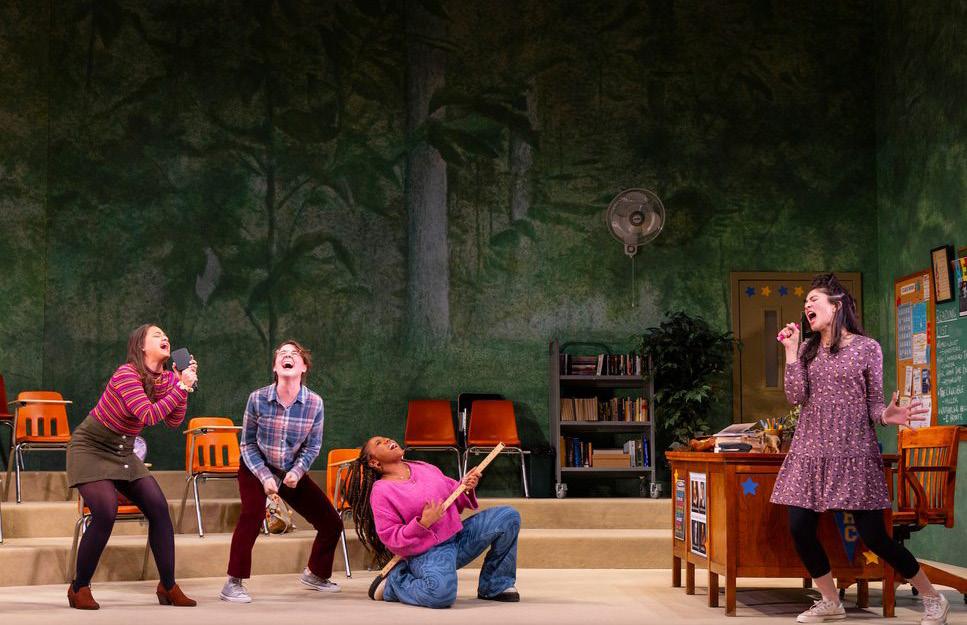
In 2018, teenage girl culture favored the Brandy Melville Alien Ringer Tee and Taylor Swift’s sixth album, “reputation.” Today, that shirt is “vintage,” and Brandy Melville’s new designs are popular, while Swift’s fans await a re-record of “reputation” and an upcoming eleventh album. Former trends fade, but their foundational agents persist. The Huntington’s production of “John Proctor is the Villain” includes both the alien shirt and “reputation,” displaying the passage of time and suggesting that present-day culture — while different on the surface — remains the same at its core. In “John Proctor is the Villain,” a funny and moving play by Kimberly Belflower, teenage girls grapple with relationships, power, and finding their voices in 2018, as they concurrently study “The Crucible,” a classic text that parallels their lives during the height of the #MeToo movement. Directed by Margot Bordelon, The Huntington’s phenomenal production of “John Proctor is the Villain” runs at The Calderwood Pavilion until March 10.
The play beautifully harmonizes contrasting tones to tell a complex story in a captivating show. Beyond doubt, “John Proctor is the Villain” triumphs as an allaround success. As a coming-of-age tale about sexual assault, the play juxtaposes youth life with adult topics. Bordelon smoothly blends funny with poignant, fiery with gentle, and simple with complicated. When a heavy conversation about sexual assault shifts into hysterical laughter, the friends’ guffawing further reveals their distress. When a goofy boy and an outspoken girl share an unexpectedly vulnerable conversation, the scene — staged seated on the floor — evokes love and empathy for the characters. When a few girls mention Harry Styles during a challenging discussion about bodily ownership and sexual consent, their buoyant physicality positions teenage innocence beside imperative maturity. In “John Proctor is the Villain,” Bordelon provides profundity and levity, which neither detract from nor clash with each other, but instead enhance the show. The cast delivers remarkable performances, aside from fluctuating attempts at Southern accents. The actors who portray
teenagers almost rely too heavily on a caricature of childhood, opting for overdramatic comedic choices, but the hyperbolic acting benefits the play. It makes the characters charming, accentuates their humor, and underscores their youth, which emphasizes the incongruence between adorable, developing minds and agonizing, grownup issues. Additionally, the actors, including those who portray adults, express convincing, nuanced feelings in touching or despondent moments. Alongside exaggerated comedy, the affective drama proves even more heartbreaking.
The entire cast successfully develops well-rounded, distinct characters, but Isabel Van Natta (Shelby), Victoria Omoregie (Nell), and Jules Talbot (Beth) stand out due to their impressive emotional range. Van Natta’s Shelby is both aggressive and lovable, Omoregie portrays a confidently bold Nell while finding compelling tenderness, and Talbot balances Beth’s eagerness and willpower with her insecurity and sensitivity. As a result of these actors’ exceptional skill, their characters shine. Van Natta conveys trauma, confusion, and pain, not only in despair but also in humor and joy, drawing audi-
ences to Shelby’s intricate depth.
Omoregie and Talbot are consistently hilarious — and their comedy embodies Nell’s and Beth’s specific personalities, respectively, making them the most engaging characters in the play.
“John Proctor is the Villain” also thrives from Bordelon’s and
“
tle through hallway chatter, then sit for the next class. In the show’s transitions, actors interact in character, then form tableaus for the next scene. Bordelon immerses the audience in adolescent life: Teenagers are forced to shift their minds quickly, and the audience must do the
As a coming-of-age tale about sexual assault, the play juxtaposes youth life with adult topics. Bordelon smoothly blends funny with poignant, fiery with gentle, and simple with complicated.
the designers’ thorough attention to detail. For example, colorful lighting and loud music end each scene immediately after the last line, producing abrupt, intense transitions. These choices replicate the fast pace and cognitive whiplash of high school: Scenes conclude suddenly and emphatically, like the jarring ring of a school bell. In real-life passing periods, teenagers bus-
same. As “John Proctor is the Villain” is stellar in nearly every area, it is impossible to communicate all of its strengths. Detailed scenery by Kristen Robinson creates a realistic classroom, while subtle greenery on the backdrop nods to “The Crucible.” Fluorescent overhead lighting by Aja M. Jackson imitates a familiar element of high school,
and dim lighting for one scene’s non-school setting supports its dialogue’s weight and intimacy. Costumes by Zoë Sundra reflect the 2018 setting, the characters’ ages, and their individual identities — especially teenager Raelynn’s self-growth, as her attire gradually changes in accordance with her personal development.
Overall, The Huntington’s
“John Proctor is the Villain” is a must-see production. With artfully executed complexity and comprehensive success, the play surpasses the quality of most contemporary theater. Similar to alien T-shirts, “reputation,” and other aspects of 2018, #MeToo disappeared from mainstream culture, but its underlying problems — prevalent male-perpetuated sexual assault and the silencing of women’s voices — persist in 2024.
“John Proctor is the Villain” explores these problems and highlights their stagnation with fresh creativity. Despite its weighty subject matter, the play closes with an uplifting scene. It does not provide a rose-colored conclusion, but it offers empowerment at the end of a striking show.
vivienne.germain@thecrimson.com
an alien invasion. The idea for “Exordia” first came from a fanfiction Dickinson wrote when he was fifteen — a story about an alien invasion set in the Lego Bionicle universe.
“My parents were worried that I spent a lot of time on the internet, writing really bad science fiction,” Dickinson said. “My parents were always like, spend more time on your studies, spend less time writing about Legos. And instead of listening to them, I wrote some fanfiction in study
hall about Lego Bionicles.” Dickinson later rewrote this fanfiction as an early draft of “Exordia.” “It was about aliens legally distinct from Bionicle, invading the real world instead of Bionicle,” he said. “And it sucked. It was not a good book. But it was my first book.”
“Exordia” went through several iterations before finally being released as a novel this year. In fact, the first published version of “Exordia” appeared as a short story, titled “Anna Saves Them All,” in a 2014 issue of Shimmer Magazine. “I had this theory that a short story is really just the climax of a novel. It’s where the interesting decisions are made, and the moment of maximum crisis,” Dickinson said. “It’s where things can’t go on as they have gone before, and something has to change. So I tried doing a short story version of the climax of the novel.” Then, Dickinson began expanding “Exordia” into a series of novellas, or short novels, which eventually became the first and second acts of the final
book. “Each of the first two acts was an independent novella with a cliffhanger, and I think those are probably the best-paced parts of the book,” he said. “Because that novella structure, and the need to keep inside a certain limit, forced me to move at a certain clip, to move things fast. It feels like the first 50% of the book is a whole novel because there’s so much stuff jammed in there.”
Dickinson eventually rewrote “Exordia” as a full-length novel in between writing the first and second installments of the Masquerade series, wanting to write a “fun book.” His publisher, Tordotcom, acquired the project before the pandemic, but didn’t publish it for several years — a process that Dickinson described as “frustrating.”
But little by little, “Exordia” started moving toward publication. “Every time it moved towards that, I would rewrite it,” Dickinson said. “And I think the book got a lot stronger and a little weaker from that process.”
“Exordia” takes place in 2013, in the midst of Obama-era geo -
politics and 25 years after the true events of the genocidal Anfal campaign in Iraqi Kurdistan, in which Iraqi forces targeted and killed at least 50 thousand Kurdish people. The novel makes it clear that the atrocities committed against the Kurds, many of them caused by the United States, are not merely a thing of the past.
“It’s about growing up in the Obama administration,” Dickinson said. “You’re constantly like, yeah, Obama, we’re making things better. But also like, man, we just Predator droned a village, we blew up a wedding. How do these two things fit together? Why are we blowing up weddings? I thought we were doing things better. Do we have to be like this? Are we just inevitably blowing up weddings because that’s what it means to be the biggest and the strongest? Who makes these decisions?”
Despite the novel’s heavy subject matter, it was important to Dickinson to keep things light. He compared the contrasting tones of “Exordia” and the more serious Masquerade novels to his own experience with depres-
sion. “It’s the difference between being deeply, painfully aware of everything that’s going on, and feeling it crashing on you — and being deeply, painfully aware of everything that’s going on, and nonetheless just hurtling forward,” he said. “There’s a certain carelessness about it, a certain ‘fuck it, we ball’ attitude that you just have to maintain in the text.”
While writing “Exordia,” Dickinson spoke with experts to implement physics and mathematics into the story, where concepts such as pink noise and Kolmogorov complexity feature prominently throughout.
“I had to talk to a mathematician. I would explain concepts I was trying to get at, and he would give me a sense, and I’d be like, this sounds beautiful. I don’t really know what it means,” Dickinson said. “But there’s a degree of reality to it that even a poet — I’m not a poet, but you know, a layperson — can understand.”
The characters in “Exordia” come from every corner of the globe, from a Filipina-Ugandan physicist to a Chinese mathematician to an Iranian fighter pilot.
Dickinson also consulted several friends and expert readers to most authentically represent these characters. “I have a couple of queer characters — women from China, from the Philippines. I was trying to figure out who their crushes would have been growing up,” Dickinson said. “And every time I came up with someone, like a DJ, I would want to find my friends from those places. And they would just laugh at me. They thought I had the worst taste in gay women. I never really did end up with good picks. They’re probably still laughing at it.”
After a lengthy journey to publication, “Exordia” was released on Jan. 23. In its final form, it’s become a novel about complicity in violence, moral dilemmas, and ultimately, hope in humankind. It’s also about spaceships made of math. All of these topics together create a sharp, action-packed, and deeply entertaining work of scifi that will leave readers excited for what else Dickinson has in store.
samantha.chung@thecrimson.com
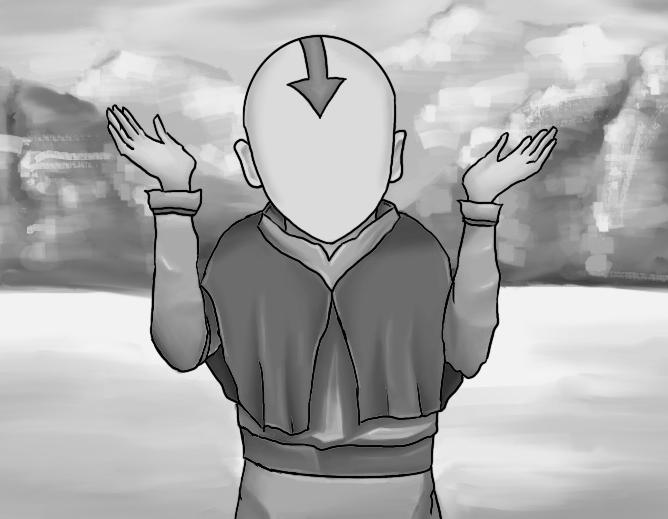 BY GISELLE P. ACOSTA CRIMSON STAFF WRITER
BY GISELLE P. ACOSTA CRIMSON STAFF WRITER
One of the most widely beloved animated shows in recent memory, “Avatar: The Last Airbender,” returned for the first time in twenty years on Feb. 22. The live-action show is a remake of the 2000s animated series of the same name. It is worth noting, however, that the new production’s team has their work cut out for them: The original animation’s lofty legacy is still felt today.
The original “Avatar: The Last Airbender” is an animated TV show that ran on Nickelodeon from 2005 to 2008. It follows the journey of a 12-year-old monk named Aang (voiced by Zach Tyler Eisen) who, along with his friends must set out on a mission to end a hundred-year war. The show’s world is divided into four nations — the Earth Kingdom, the Fire Nation, the Water Tribes, and the Air Nomads — whose denizens have the power to “bend,” or manipulate, their respective ele -
ments. As the Avatar, Aang is the only person who can bend all four of these elements and restore balance to the world.
The series itself has aged well, if its 9.3/10 rating on IMDb is anything to go by. Its longevity has many factors, but perhaps most crucial to its relevance are its immersive worldbuilding and expansive diversity — the four nations are inspired by a variety of Asian and Inuit cultures.
The show’s writers even invited the Vice President of the Media Action Network for Asian Americans to consult on the project and ensure it was culturally sensitive. It was also one of the earliest TV shows to respectfully portray disabled characters. Toph, for instance, is a blind teen girl who is canonically one of the strongest benders in the world.
The show’s popularity is also likely due to its excellent writing. “Avatar” boasts complex yet likable characters who experience rich development over the course of three seasons. The show’s plot is planned well, so its relatively short run ended with a satisfying conclusion. The conclusion
was so good, in fact, that the finale holds the rare distinction of being the show’s highest-rated episode, with a nearly perfect score of 9.9/10 on IMDb.
All of these factors combined have given the original show broad acclaim and appeal. “Business Insider” mentioned it in their top “50 TV shows everyone should watch in their lifetime.” In this piece, the author writes that the show “aims at being for all ages, and miraculously, succeeds.”
With the live-action remake, Netflix is attempting to garner the same appeal. The predominantly Asian and Native American cast respects the diversity of the source material, and the fact that the actors are real people also makes the diversity more empowering. In an interview, Daniel Dae Kim, the actor who plays Ozai in the remake, said, “Having a predominantly Asian group of people in front of and behind the camera is significant.”
While elaborating on the relationship between the two series, executive producer and director Jabbar Raisani said, “I hope that fans say, ‘This is the live action ad-
aptation that we’ve always wanted.’” However, it remains to be seen whether that will be true.
The Netflix production’s rewrites seem likely to eradicate the complexity and depth of the original show. The script, for example, completely omits the misogyny of Sokka, one of the main characters, a decision that makes no sense within the context of the original story. If Sokka doesn’t learn how to overcome his misogyny, he arguably loses most of his character arc in the first season. Moreover, several other plot points, including his first interaction with his love interest, Suki, are rendered irrelevant.
This creative decision is part of Netflix’s larger problem of misunderstanding its audience. In an interview with CBR, the remake’s showrunner, Albert Kim, said, “It couldn’t just be for kids. It had to also appeal to the people who are big fans of ‘Game of Thrones.’”
This choice may appear as an insult to the storytelling of the original show, which appealed to all ages and subtly covered the same dramatic topics in a way children could understand.
The original show’s head writer put a particular emphasis on empathy while crafting “Avatar,” and the show is beloved for its ability to appeal to a wide age range while still respecting the intelligence of its younger viewers.
This difference in approach reflects the creative conflicts that caused the original show’s creators to leave the forthcoming remake in 2020. Bryan Konietzko, one of those creators, said via Instagram, “They made a very public promise to support our vision.”
“Unfortunately, there was no follow-through on that promise,” he said.
This statement can only make fans wonder whether the liveaction remake will resemble the “Avatar” they know and love.
Emotional significance aside, the original “Avatar” set an important precedent for storytelling in television at large. “Avatar: The Last Airbender” proved that shows with short episodes, animated shows, and, yes, even kids’ shows, can be serious. And they can do it well.
giselle.acosta@thecrimson.com
the game — Elon Musk,
James, Lady Gaga, Khloé Kardashian, and many others. And of course, this list would not be complete without the halftime show performers themselves, including Usher, Alicia Keys, H.E.R, Lil John, Jermaine Dupri, and will.i.am.
Swift wasn’t the only big name to grace the
Bowl. Others in attendance included Beyoncé — who dropped two new singles
Overall, people are generally obsessed with drama and conflict. Talk is cheap when the story is good, and when a global artist attends her lover’s biggest game, it is typically a great sto -
ry. But Swifties tuning into the Super Bowl are not an anomaly. There have always been a mix of arts and football fans at Super Bowls, and there always will be. The halftime show brings in tens of millions of viewers — with 82% of the total 123.7 million tuning in this year — making it the largest live broadcast event in which a musician can perform. In terms of viewership, the game itself is also one of the largest in the United States. Due to its magnitude, the game’s atmosphere will al-
ways contain a particular tension between fan groups.
However, it seems that Swift’s influence surpasses the realm of music and even the game of football itself. She helped make the Super Bowl more influential, introducing an entirely new fan base to the sport as well as football fans to her own work. Fans on both sides had better buckle up. While this may be the first time such a star has impacted the Super Bowl in this way, it certainly won’t be the last.
BY ABIGAIL A. GOLDEN CRIMSON STAFF WRITERWith particularly poignant selections like “We Don’t Talk” and “Something You Were Trying,” Go’s music was melancholic and haunting, thick with the influence of the musicians before her.
Throughout her performance, Go effortlessly navigated the space of the intimate venue, inviting listeners new and old into her repertoire with every strum of her guitar. There was an ease to her performance that demonstrated her comfort on the stage as she confidently punctuated her set with jokes.
“Yeah, I’m not from here. That’s why I sound weird,” she quipped about her accent early in the set, earning several laughs across the hall. One of the evening’s standout moments came with the performance of “7 Up,” a newer release that showcased Go’s ability to seamlessly blend introspective lyrics with acoustic brilliance. Her stage presence and delivery were spellbinding.
But the most striking aspect of Go’s performance was the palpable sense of vulnerability that permeated her music.
Each song was another layer of her persona peeled back, showcasing a remarkable undercurrent of honesty and authenticity. Though a solo career is certainly a novel development, Go’s spirit that evening made it a welcome one. As her set came to a close, Go addressed the crowd with earnest gratitude, her humility and appreciation for those in attendance well apparent. With her captivating exhibition, she proved that she was not just an opener but a force to be reckoned with in her own right, leav -
ing a lasting impression on the hearts and minds of all who were fortunate enough to experience her live. In the end, Go’s concert was more than just a performance. It was a journey of self-discovery and artistic revelation. With her full-bodied acoustic sound and unwavering authenticity, Go has emerged as a rising star within the alt-pop scene, and her concert was a testament to the power of musical evolution.
abigail.golden@thecrimson.com
was not just born into any family — he had a grandfather who wrote about evolution. It kind of predisposes you to think about this stuff. But he did some amazing things. Actually, after Darwin writes “On the Origin of Species,” he spends the next 25 plus years till he dies mostly writing about plants. So the book after “On the Origin of Species” is about pollination in orchids, a whole book on orchids — brilliant book. Then he writes another book about climbing plants. He writes a book about movements in plants. I don’t think most people think of Darwin as a botanist or plant person, but he was really, really interested in the plant world.
Friedman then takes FM on a golf cart tour of the Arboretum.
NF: Look at these. This is a hem-
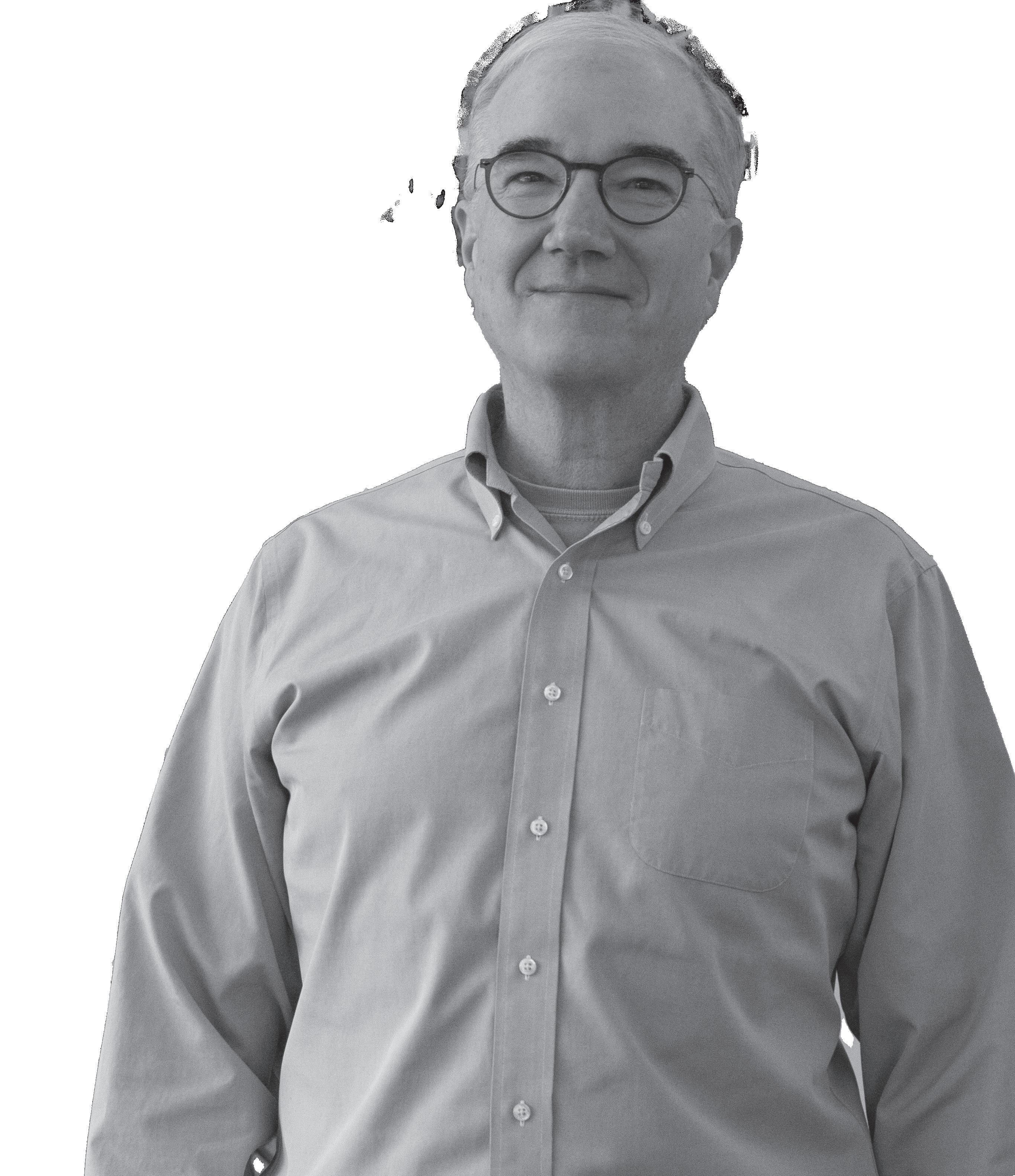
plants. It’s celebrating the beauty and the extraordinary thing that plants are.
FM: What is it about plants specifically? When you look at a plant, whether on your walk or under the microscope, what do you find so beautiful about it?
NF: So I’m an evolutionary biologist. I’ve studied the history of plants — you know, how did we get to the world that we inhabit? And it’s a three-and-a-half-plus bil-
lion-year history. Everything that is our reality has been shaped by plants, which is pretty amazing, right? You and I are breathing air in and out, and we need oxygen. And yet the planet was born with no oxygen. All of our oxygen has been created by plants or photosynthetic organisms. As you get deeper and deeper into it, you just sort of realize that you’re a little bit player over here. Plants had been sort of shaping the earth, drawing down CO2, evolving in all kinds of habitats, and everything that’s us has been made by plants. Basically our bodies are recycled plant material and all that carbon.
But then there’s another aspect, which is just the beauty of plants.
The more you know, the more you realize how amazed one can be at how extraordinarily beautiful the planet can be. And for me, it’s plants. I’m sure
for an astronomer, it’s out there in space. For someone who’s a poet, it’s the construction of a few words into something that creates meaning. I think for everyone, we all attempt to find something we connect deeply with. For me, it’s just these wonderful organisms that I love. They can’t love me back. They’re not sentient, but they bring incredible joy to my life.
FM: I also read, as I was researching up on you, about your lectures on Darwin. Did he not come up with the idea of evolution? I’d never heard this before?
NF: Yeah, so he didn’t come up with the idea of evolution. He convinced the world of it and he came up with the mechanism of natural selection as a way in which evolution works. But I’m really interested in people
— and I actually taught a course on — people before Darwin who wrote about evolution. There are about 70 people who actually believed that the world was created through an evolutionary process. They didn’t necessarily know what the process was, but they didn’t think it was a bunch of magical miracles where poof,
That’s about a 120-year-old organism. It’s just beautiful, isn’t it?
Yeah. So every one of these trees has a tag on it. We know where it came from, where it was collected. We know its history — same as you and me, right? Members of the same species, but we have our own identities. Every tree here has its own identity.
Just to give you some idea, I’m just going to do a 360 here — look at this view. Wow. That’s meant to be open. It’s meant to be that you look into the conifers, you see the blues and the greens and the different forms. Amazing place. That’s designed. 120-30 years ago, there was nothing there except pasture. So when Olmstead designed it, he didn’t live long enough to see those trees get much taller than you and me.
FM: Wow. That’s a lot of confidence in your vision. You have to have faith. Long game.
You have to have faith, and you’re so right about long game. Those trees weren’t planted for anybody who was alive then. So it’s also about generosity and paying it forward. So, they were planted for you. Isn’t that an amazing thing? Someone had to think that in 150 years, someone will be here — they don’t know you, of course — and they will take some pleasure in it.
FM: I’m also hoping you can show me your favorite tree. I could probably show you a few favorites. That’s a dawn redwood from China. And it was thought to be extinct. It was only known from the fossil record. And then in the middle of World War Two, some Chinese botanist figured out that this was a species that hadn’t been described scientifically. And because we’d already been interacting with China for a long time, the first seeds to leave China came here — that’s from 1948. But one of my favorite trees came from France. It’s kind of a magical tree, and it’s a mutant tree, too. A lot of horticulture is about finding weirdos — in a wonderful way. Mutations happen all the time. It’s a beautiful tree. I mean, look at this little curtain, look at the form of it. Isn’t that something? The way it just kind of goes around and spirals. That’s an amazing tree.
dina.zeldin@thecrimson.com
FM
Fifteen Minutes is the magazine of The Harvard Crimson. To read the full interview and other longform pieces, visit THECRIMSON.COM/ MAGAZINE
With a coast-tocoast, third quarter, mandown goal from senior goalie Christian Barnard setting the tone for the second half of play, the Harvard men’s lacrosse team (1-0) struck gold in its season opener against Providence with a decisive 23-7 victory. The team remains undefeated against the Friars, boasting a perfect 5-0 record against its opponent.
The first quarter of play was gridlocked between the two squads, with the Crimson drawing first blood on an unassisted goal from sophomore attacker, and The Crimson’s 2023 Rookie of the Year, Teddy Malone. Malone worked the two-man-game with junior middie Miles Botkiss, beating his defender around the left side of the crease with a shifty split dodge from the X that allowed him to get a step on his defender on the switch and bury the ball in the low left corner. Providence answered back immediately, winning possession on the next face off. After about a minute of play, Friars middie Ryan Bell ripped a righty side-arm sniper low from the top of the fan off an easy pass. Bell smartly used Crimson SSDM Ray Dearth as a screen, blocking his shot from Barnard to set up an easy goal with lots of time and space.
Senior attacker Graham Blake, who was sidelined for much of the 2023 season due to injury, was an electric contributor on the offensive end for the Crimson. Starting on the attacking unit alongside junior attacker Sam King – who was named to the 2024 Tewaaraton Award watch list – and Malone, Graham made an instant impact, notching an impressive hat trick in the first quarter. The team’s offense, which at times struggled to get hot last season, started the season off strong. The depth of Frisbie Family Head Coach Gerry Byrne’s bench was put on full display, with ten Crimson players notching goals, including two for sophomore middie John Aurandt IV and one for freshman middie Michael Smyth.
“It was fun [to be back]. It was nice to get out there at the end of last year, but I feel comfortable and the other guys on offense made it super easy,” Blake said. “A majority of our goals were assisted and everyone was moving in good spots”
Despite snow squalls intermittently impacting visibility throughout the first quarter, the Harvard bench ended the first 15 minutes
faceoff X. After posting a sub-50 percent record last season, the junior’s work during the offseason paid off as he went 9-10 in the first quarter. Winning a majority of the clamps, DeGennaro was able to dish the ball out to his supporting wings, which were frequented by familiar faces in senior LSM Greg Campisi, junior captain and SSDM Andrew O’Berry, junior LSM Martin Nelson, and junior SSDM Ray Dearth, among others. Byrne also rotated in freshman Owen Umansky, who was touted as being one of the premier faceoff recruits in the nation. The increase in possession time enabled the offense to settle and work through its sets, spreading out wide to make use of its space. Spacing was a big area of focus for the team and for offensive coordinator Neil Hutchinson throughout fall ball, and was a huge factor in the offensive success against the Friars. By spreading out wide and creating lanes, the offense was able to utilize the pick game – like in Malone’s first goal – and cut through the middle for feeds from behind. Despite resulting in a one-minute locked in penalty with 3 minutes left to play, sophomore offensive middie Griffin Pokorny scored on a shifty split dodge down the right alley, sniping a low bouncer as the Friar’s defense was unable to slide for help. Pokorny’s momentum downhill carried him through the crease after the ball crossed the goal line where he collided with the Providence netminder. After celebration from the Harvard offense, and praise from the ESPN announcers for his “deliberate” and “aggressive” play, a flag was thrown and the goal was overturned on the penalty. Exactly two minutes later with 1:03 left in the first, Ip was able to reinstate the team’s fifth goal on the board.
“We have a lot of really great players this year and we have a lot of buy-in,” Blake said. “I think we have probably ten different attackmen who are all really really good and have been grinding all year. It’s the product of a lot of hard work and great coaching as well.”
The final play of the quarter was quarterbacked by Blake, who scored on a decisive cut to the doorstep off a feed from King with less than a second left to play. Byrne called a time out with 16 seconds remaining in the first in an effort to retain possession of the ball amid a struggle for the rebound on an errant take by Malone. The reset allowed Byrne to draw up a play for his unit, with Malone carrying the ball down the right side where he switched fields, swinging the ball behind the cage to Blake who saw King pop out in the right alley, to whom he promptly hit on the elbow. King, in his typical fashion, hastily made his way to the cage with four seconds left, drawing the double team from the Provi-
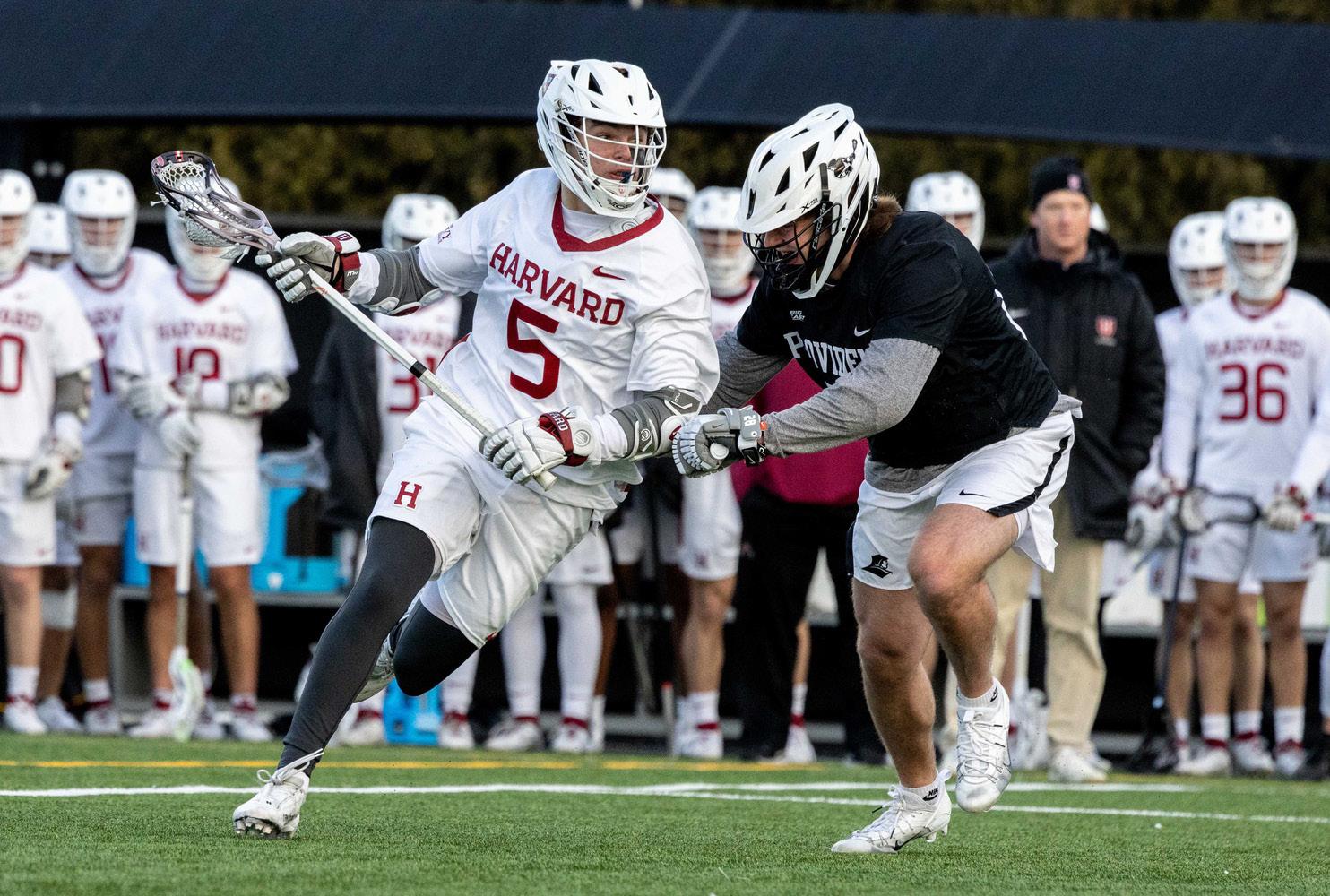
doorstep. King, whose head was up for the entire quarter, made the pass to Blake through traffic. Blake caught the ball cross-handed, keeping his feet moving towards the cage, finishing the play with a low back-hander that eeked over the doorstep. Because the other attackers stayed spread out and held their space, Blake was able to attack the open lane, which would have been much easier for the Friars to defend had the attack been sagging in.
The offensive middies, led by returning stars in Botkiss, junior Joe Dowling, sophomore Logan Ip, and Aurandt, were joined by some of Byrne’s impressive rookie class. Freshman Jackson Greene made his start early in the game, joining the first line offensive middies. Greene notched one point, an assist, in his collegiate debut. Greene, alongside first years Jack Petersen and Michael Smyth, will be players to watch in the squad’s upcoming contests. In an interview with Byrne regarding the team’s 2024 season, the coach remarked that he felt “poised to play between six to eight first years this spring.” Byrne’s squads, as seen over the last few years, tend to boast a strong crop of incoming players. However, it was his returning starters who made an impact against the Friars. Dowling, whose off-ball movement created opportunity for his line, tallied one assist, and Ip totaled three points with two goals and an assist.
“I think we have some of the most talented freshmen in the country. Every single one of them, I guarantee you, will play in really big moments as Harvard lacrosse players and I think a lot of that is going to happen this year,” Blake said. “They are great guys, and they fit in culturally and on the field better than you ever
team this season. The squad never let its foot of the gas, playing hard and fighting for every possession. Perhaps it comes from a more seasoned squad leading the helm, or a desire to redeem last season’s shortcoming and near bid to the Ivy Tournament; either way, in a fashion similar to the upset win against Cornell last April, the team looked like it wanted and deserved the victory.
The addition of penalty review in college lacrosse, which resulted from a close-call that potentially altered the outcome of the NCAA tournament game that saw Duke topple Penn State 1615 in overtime, was a monumental factor in penalty time during Saturday’s matchup. Duke won on a diving shot by middie Garrett Leadmon. The shot was controversial because upon replay from ESPN Leadmon clearly violated the crease, yet from the referee’s vantage point, he declared that Leadmon had not landed in the goalmouth before the ball crossed the goal line. The lacrosse community is divided on the idea of penalty review, with supporters saying it will help with close-calls on crease dives and improve safety as refs can analyze contact to the head and more appropriately dole out penalties. However, review – in contexts outside of championship games – slows down the pace of play and risks hindering the cadence of the game.
“The speed of the game and the athleticism of the athletes is so electric that the referees need technology to help them discern penalties and goals,” Byrne said.
head with “possible expulsion.”
The Crimson bore the brunt of this rule change, with two of its penalties being escalated from one-minute possible contact to the head infractions to two two-minute locked-in direct contact to the head violations. The first review was called for shortly into the second quarter and put the Crimson down two men. Sophomore defenseman Charlie Mueller took a knee for thirty seconds for a push, and sophomore SSDM Owen Guest was sidelined for a locked-in two minutes for direct contact to the head. Guest was initially flagged for a potential contact to the head violation. The contact was a result of Guest throwing his body into a driving Friar attackman who flew past Dearth as he was barrelling towards the goal. Guest stepped in from the left side, knocking into the shooter who was letting the ball fly well above the crossbar, sending him sprawling to the turf. The man-down unit was able to keep the Providence offense at bay for the entire flag.
“The start of the video review rule in College Lacrosse had an adverse effect on our team on Saturday but will be a positive for our sport in the long run,” added Byrne.
grounds of a crease violation. The Friars immediately locked down their Crimson counterparts, but left Barnard wide open with time and space to make a play. The veteran goalie saw his opportunity, and pushed the ball up midfield before crossing the 50, racing to the goal without drawing a single Providence slide. After sniping the corner, he drew a late hit from a Providence defender which knocked him to the turf. With the flag flying and the bench going crazy, the penalty would neutralize the effect of Guest’s, and grant even more momentum to the dominant Harvard squad. The goalie goal put the Crimson up by 10 with eight minutes left to play in the third.
The squad coasted through the remainder of the third and fourth quarters, tallying eight more goals and only allowing the Friars to score twice. Towards the end of the fourth quarter Byrne subbed in a majority of his roster, giving minutes to senior SSDM Fred Asare-Konadu, senior offensive middie Mark Stephens, junior goalie George Alvarez, and junior offensive middies Liam Griffiths and Lucas Hilsenrath, amongst others.

The team’s ride, which ranked third in the nation last season, looked strong against Providence, holding the team to a .789 clearing percentage.
The scrappiness between the thirties was a hallmark of the determination the team showed for the full 60 minutes, and translated into an intensity new to the
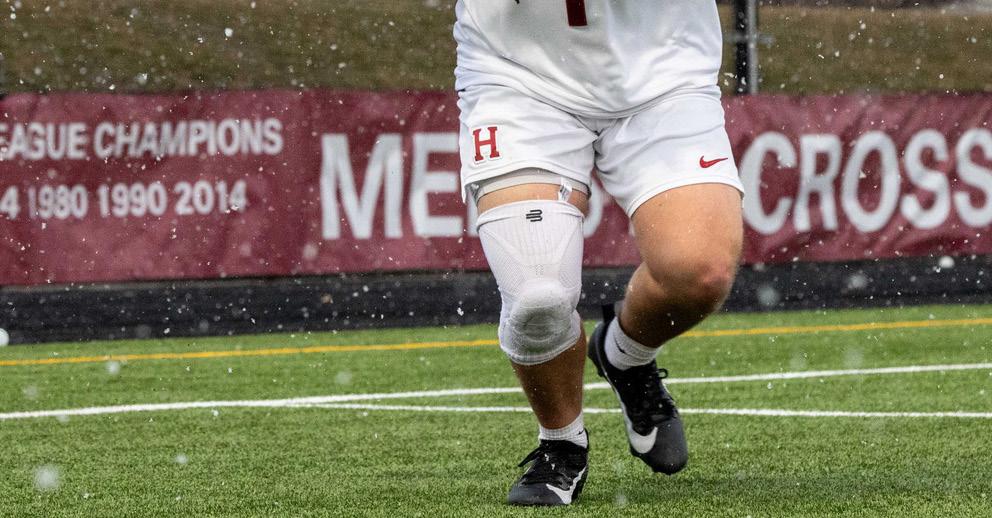
Each coach will be granted one review per half that they can use to challenge certain scenarios such as whether a loose ball crossed the goal line, whether a player crossed the crease before the ball entered the goal, or to determine if a player entered the crease as a result of illegal contact.
Each coach will also be granted two timeouts per half and one additional stoppage for each over time period. If a challenge is unsuccessful, the coach will be “charged” at timeout, and if the challenge is correct, the coach will retain that timeout. As such, a coach must have at least one timeout remaining in order to challenge a play. The review must be called for within 30 seconds of the end of the play, and any goal scored by either team during that time will be voided.
In addition to coaches being able to review plays, the referees will also be able to replay certain moments of the game and potentially escalate their penalties for certain infractions. In order for the refs to review, the on-field official must have initially cited potential contact to the head or neck. There are three scenarios that the NCAA has permitted the officials to reconsider, the first being indirect contact to the head or neck, the second being direct contact, and the third being “excessive or flagrant” contact to the
The man-down unit, which played lockdown defense throughout the 2023 season, struggled against the Friars’ fastpaced offense. Allowing the manup unit to strike on two of its four opportunities, the Crimson defense got caught ball watching, which allowed Providence to attack Barnard from a wide-open back side. Analyzing the skip pass and maintaining speed on its second slides will be a focus for the team as it faces off against Bryant on Tuesday.
“I think we have to be more alert on the switches, and faster with thinking ahead of the opponent,” freshman LSM Joost de Koning said. Before going man down, King opened up scoring for the second half, capitalizing on an assist from O’Berry. O’Berry intercepted the ball at the midline, taking advantage of the attackers’ ability to sag back and lock-down their defenders on the ride, hitting King with a leading pass down the right side of the field where he was able to breakaway and burry the ball low in a one-on-one with the goalie. The bench erupted with a cacophony of cheers, and the momentum from the goal carried through for the rest of the quarter. The next penalty review went against Dearth in the third quarter, whose violation escalated from a one-minute potential contact to the head to a two-minute locked-in contact to the head. Despite the disadvantage, the mandown unit kept the attack at bay. Barnard made an impressive stop on the doorstep, stuffing a Providence attacker diving underneath the approaching Crimson slide. The referee stopped the play and returned possession to Harvard, calling for a penalty on the
“Our starters were playing great, and I knew that I was going to have a chance to get in there, and they kept rolling, so I just fed off that energy,” de Koning said. Overall, the team performed remarkably well in its season opener, a testament to Byrne’s coaching throughout the offseason. The low defense, which is missing the commanding presence of junior Tommy Martinson, worked cohesively throughout the contest, doing a great job of talking through picks and tricky rotations.
The inclusion of sophomore LSM Sean Jordan, who made his return after a severe injury at the start of last season, and de Koning, were welcome additions to the defensive lines. De Koning in particular adapted well to the fast-pace of Division I lacrosse, tallying two ground balls and a CTO in his first collegiate performance. Heading into its next game against Bryant, the team will look to capitalize on its momentum. The theme of the game, and what led to such a decisive victory, was the team’s desire for success. Bringing that champion-mindset into Tuesday’s matchup will be crucial in securing another win against a scrappy foe.
“Bryant is a really good team, so I’m not really sure [what we’ll be working on] yet. But, I think that we’ll watch film and see where their strengths are,” Blake said. “They are always really gritty and work hard so we’ll see what we need to improve on from watching the film.”
The Crimson will welcome the Bryant Bulldogs to Jordan Field on Tuesday at 7 p.m., and the game will also be streamed live on ESPN+.
the first period, because we talked about a lot of things as a team.”
At a now-or-never point in the season, Harvard men’s ice hockey (5-16-4, 5-9-4 ECAC) must
out of the net. As time expired, both teams left the ice with the score still tied at zero.
“I think at this time of year, you can’t take too many chances to try to find your offense. So you got to be able to defend,” Donato said. “I thought Derek was outstanding in that. The score after the first period could have been in their favor and it wasn’t so to be honest with you I think just as a staff we were really frustrated after
play. Fine passed the puck to captain Ian Moore at the point, and Moore fired a shot to the front of the net. Junior forward Alex Gaffney stood firmly in front of the St. Lawrence goaltender, waiting for the rebound, which he tipped in with 24 seconds remaining to give the Crimson the lead. The team was able to hold for the final seconds to secure the win.
“[I]t was a big play to come up with the puck down there by Ryan Fine,” Donato said. “Ian

ward the final minute, a Clarkson rebound shot from graduate student forward Anthony Romano was taken in the slot from junior forward Ryan Richardson and dumped into the net for the team’s first goal. Momentum carried well into the second period for Harvard. Crimson first-year left wing Cameron Johnson joined the stat sheet with an opening minute goal. After an intercepted pass, first-year right wing Michael Callow took the puck into the offensive zone, passed to sophomore center Casey Severo, and then over to Johnson at the left circle.
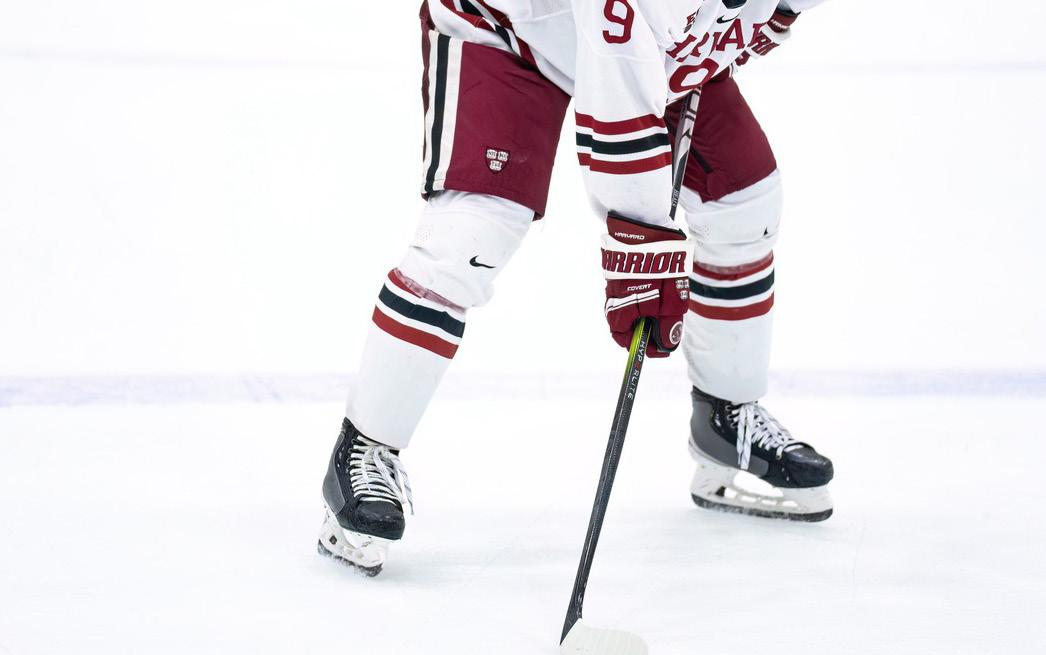
Shortly after, first-year defenseman David Hejduk was called for holding, handing Clarkson its second power play opportunity of the night. But the Harvard penalty kill held strong and kept Clarkson without a goal after two tries. With a full half of hockey finished, the Crimson continued to take advantage of Clarkson’s mishaps, as the Golden Knights were called twice for penalties in the final 7:12 of play with the second coming at just 1.2 seconds left in the second period. Both were also against senior defenseman Noah Beck, first for boarding and then for tripping. The first of two power plays was unsuccessful by the end of the period, but saw strong takes for Harvard and imposing zone time, leaving Clarkson players fatigued and in a position to foul late. The third-period penalty would also see limited action. It wasn’t until 8:23 remaining that either side appeared to take up momentum. This time, first-year right wing Ryan Fine was gifted a breakaway chance but could not convert.
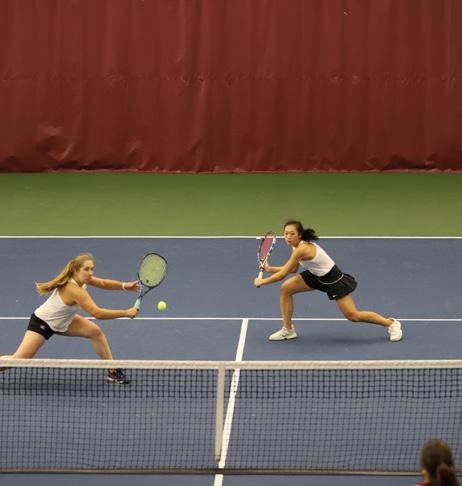
The Crimson came out revitalized in the second period, generating some high-danger scoring opportunities while continuing to shut down St. Lawrence in the defensive zone. However, neither side was able to find the back of the net for the majority of the period. It was only in the final two minutes of the period that the Crimson finally struck, as sophomore defenseman Ryan Healey game at one goal. Just 12 seconds after Healey’s goal, a loose puck at the Crimson’s blue line led to a breakaway for the Saints’ Jan Lasak, who had an open shot at the net. Mullahy was able to make the initial stop, but the rebound was picked up and poured in by Ty Naaykens, making the score 1-1 as the teams headed into the third period.
Harvard faced early adversity in the third when Healey was called for a slashing penalty just over a minute into the period. The Crimson’s penalty kill was up for the task, and kept St. Lawrence at bay for its only man down situation of the night. As the period wore on, Harvard’s offense continued to generate takes, striking solid shots that just wouldn’t find their way to the back of the net. With only one minute remaining in the period, it seemed as though the game might head into overtime, with both squads playing tight defense. But then, with possession in the offensive zone, freshman forward Ryan Fine was able to clinch a win for Harvard in the last 60 seconds of
at the right time. So this is certainly something that we’ll have to do a lot more of if we want to have success coming in.”
Clarkson 3, Harvard 2
This was the third-straight game for Harvard senior goalten-
tion until late, but remained a fundamentally sound game throughout. The first misstep would come at 8:16, when a penalty was called against Crimson junior center and captain Zakary Karpa for holding along the left boards of the defensive zone. Clarkson looked to have a power play scoring opportunity when Mullahy played a puck behind the net and hit it into a Golden Knight player at the goal line. The puck was instead taken on a bounce by Harvard and dumped out of the zone and over the boards onds of Clarkson’s power play, prised with ed goal. Sophomore right wing Joe Miller intercepted a pass in the air at the red line and took the puck up the ice on a shorthanded breakaway, ultimately scoring at 6:22 off a forehand-backhand deke.
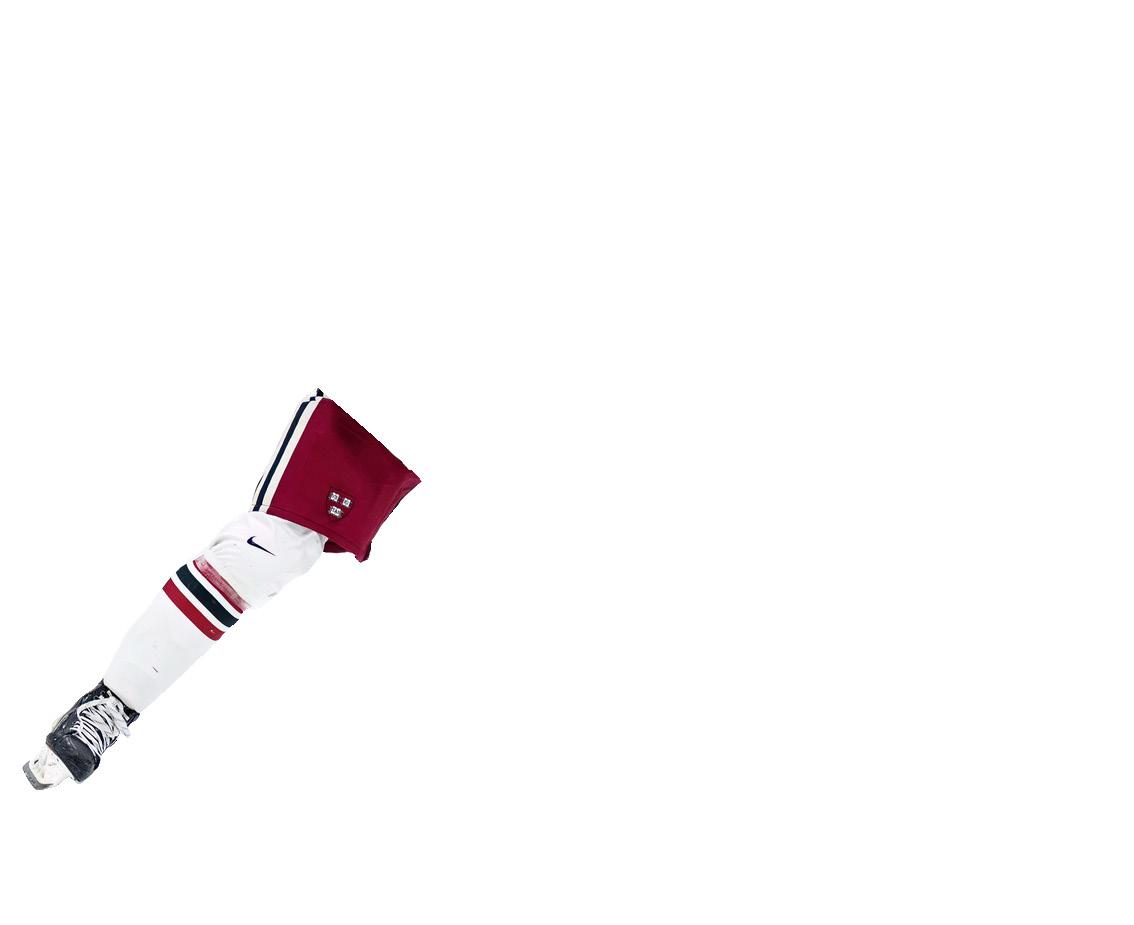
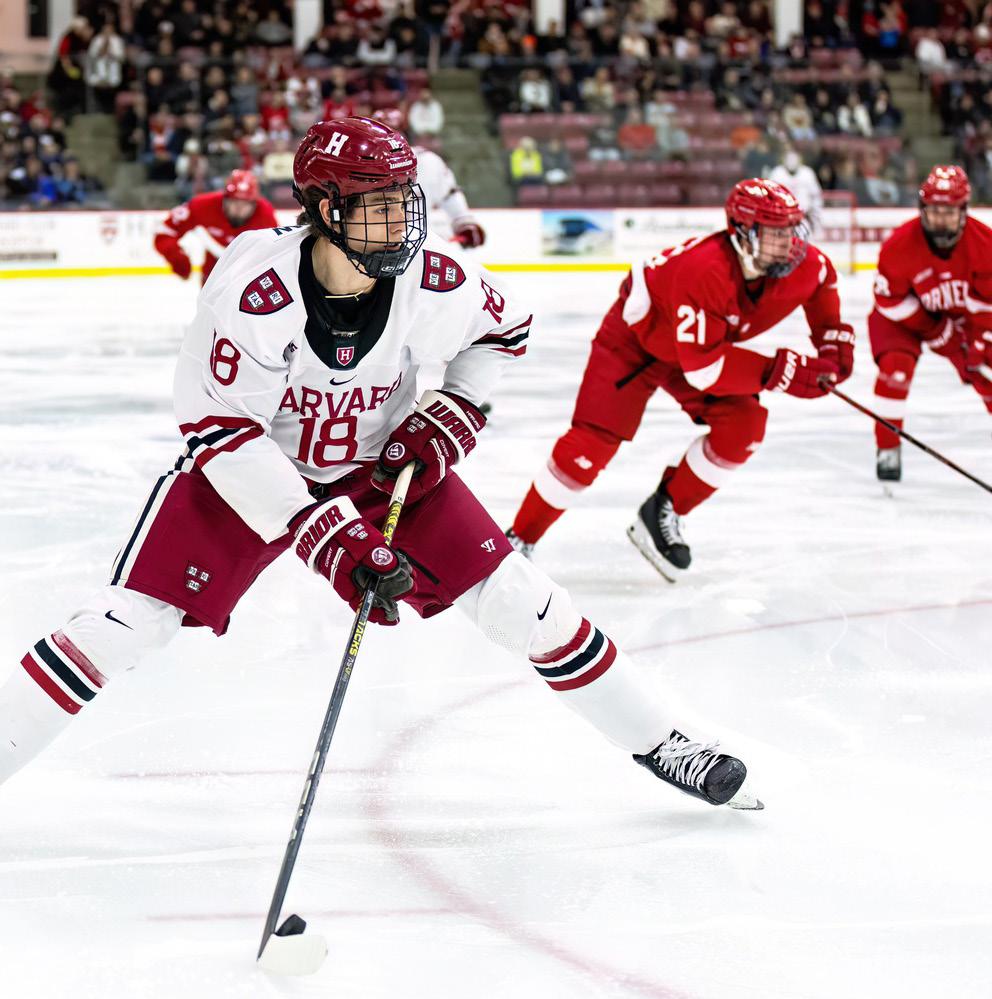
Less than five minutes later, with the game seemingly in the Crimson’s hand, Clarkson struck back. Beginning in Harvard’s offensive zone, first-year center Ben MacDonald took a stab at a fleeting puck, but failed to recover on the oncoming defensive play. This gave Clarkson a tight 2-on1 situation, with the only pass on the scoring try coming from firstyear forward Daimon Gardner to the goal-scorer, sophomore forward Ryan Taylor. Taylor swiftly drove the puck into Clarkson’s offensive zone from the left side and snapped a simple wrister, stickside high. The shot immediately beat Mullahy, who appeared to too strongly anticipate a cross-ice pass, knotting the score at two a piece less than five minutes from the end of regulation.
The contest went to overtime, and more than halfway through the 3-on-3 overtime period, Clarkson scored the game-winning goal in a routine take up the ice and shot from the right circle. Back in the Golden Knights’ defensive zone, a high puck hit off the goaltender made Harvard’s Severo pause. This gave Clarkson brief 3-on-2 positioning. A last second dive from junior defenseman Jack Bar to block the shot was too late and Clarkson drove it home. After the game, Donato described what went wrong on the play for the Crimson.
“[W]e just made a poor decision, and had a couple of mistakes that led to a 2-on-1 against [us] so I think you can’t feel bad for yourself when you give up a 2-on-1,” Donato said. “We did not manage the situation well and it’s very frustrating and hard for our guys to learn these lessons the hard way.” With playoff hockey soon approaching, the team wants to look past the tough loss and continue playing the way they’ve come to recently.
“Guys are playing their best hockey so far this year,” Mullahy said. “I think we treat it like it’s a playoffs already.
Millrose Games, one of the most prestigious Track and Field meets in the nation. Ramsden represented the Crimson as she competed against an esteemed field of professional runners in the women’s indoor mile. Ramsden posted a record-breaking time of 4:24.83, narrowly beating a ten-year-old Ivy League record held by Dartmouth runner Abbey D’Agostino. The title is another addition to her list of accolades.

HOT
STREAK FOR
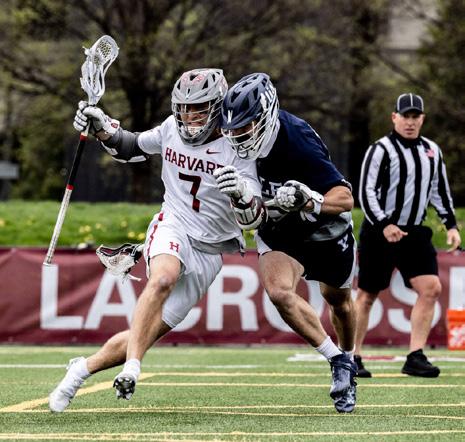
Head Coach
der Derek Mullahy. Speaking after the game about the decision, Donato explained by pointing to Mullahy’s performance against St. Lawrence. “I thought Derrick [Mullahy] played really well last night and [I] wanted to give him a chance to stay hot,” Donato said. The first period saw little ac-
Two Clarkson shots closed out a tight first period. The first, from Golden Knights’ junior forward Jesse Tucker at the left circle, appeared to be deflected in front of the net with a strong Golden Knight screen, but hit off the left post and into the corner. As the clock ticked down to-

